Cathedral MUSIC Cathedral MUSIC
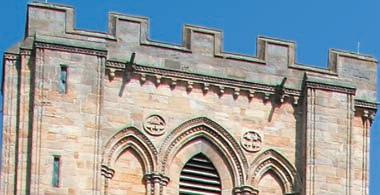
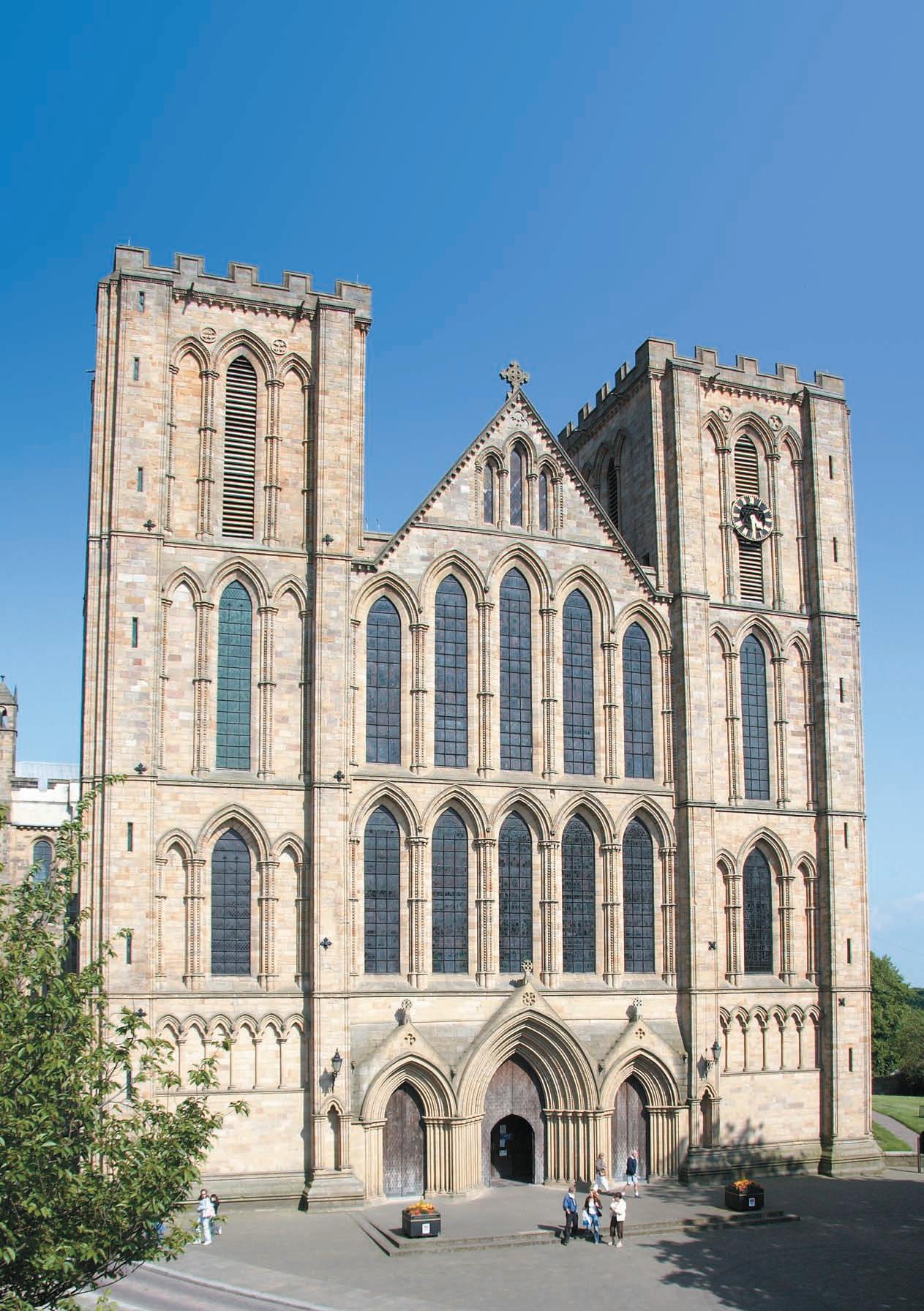
ISSUE 2/07
P3 140 CM Nov 07 A:3302 Cathedral Music MAY #B5827 31/10/07 13:43 Page 1

P3 140 CM Nov 07 A:3302 Cathedral Music MAY #B5827 31/10/07 13:43 Page 2
Cathedral Music
CATHEDRAL MUSIC is produced twice a year, in May and November
ISSN 1363-6960 NOVEMBER 2007
Editor
Andrew Palmer
21 Belle Vue Terrace Ripon North Yorkshire HG4 2QS ajpalmer@lineone.net
Assistant Editor Roger Tucker
Editorial Advisers
David Flood & Matthew Owens
Production Manager Graham Hermon FCM e-mail FCM@netcomuk.co.uk
Website www.fcm.org.uk
The views expressed in articles are those of the contributor and do not necessarily represent any official policy of Friends of Cathedral Music. Likewise, advertisements are printed in good faith. Their inclusion does not imply endorsement by FCM. All communications regarding advertising should be addressed to:-
Roger Tucker
16 Rodenhurst Road LONDON SW4 8AR
Tel:0208 674 4916
cathedral_music@yahoo.co.uk
Friends of Cathedral Music Membership Department
27 Old Gloucester Street London WC1N 3XX
Tel: 0845 644 3721
International: (+44) 1727-856087
E-mail: info@fcm.org.uk
Every effort has been made to determine copyright on illustrations used. We apologise to any individuals we may have inadvertently missed. The Editor would be glad to correct any omissions.
Designed and produced by Mypec
The Old Pottery, Fulneck, Pudsey, Leeds, West Yorks LS28 8NT Tel: 0113 255 6866 info@mypec.co.uk www.mypec.co.uk Cover Photographs
Front Cover Ripon Cathedral
Back Cover Ripon Cathedral
Photo: © Graham Hermon
The Magazine of
Friends
Music CM Comment 4 Andrew Palmer Keeping the tradition alive at Ripon 5 Andrew Bryden – Director of Music at Ripon Cathedral Mind the Gap 8 The Choral Scholarship Scheme at Portsmouth Publication, publication, publication! 14 Tim Rogers shares his thoughts on church music publishing Story from Across the Pond 18 Christopher Brayne In the (square) eyes of the world 22 David Flood Alex Mason 24 60 Seconds in Music Profile Cathedrals – places of delusion or truth? 26 Sermon by Canon Patrick Woodhouse, Wells Cathedral Precentor The Versatility of the Victorian Musician 30 David Barton Lay Clerks’ Tale 35 The Portsmouth Gentlemen and their watering holes by David Hampshire Three Notable Cathedral Organists and Choirmasters 36 Anniversaries of Sydney Nicholson, Francis Jackson & Alan Thurlow Elements of evil... nothing less than a Scandal 44 The Three Choirs Festival as seen by the Church Times in 1900 Sir Philip Ledger CBE – A Birthday Tribute 47 Graham Elliott Festivals Overview 2007 48 Roger Tucker Letters 50 Your views Book Reviews 52 The latest books CD Reviews 53 The latest recordings Cathedral Music 3
Photo: © Denise Carrigan
the
of Cathedral
Cathedral MUSIC Cathedral MUSIC P3 140 CM Nov 07 A:3302 Cathedral Music MAY #B5827 31/10/07 13:43 Page 3
Payment of a donation of £3 to the distributor of this magazine is invited to cover the cost of its production and distribution
‘ CM Comment Andrew Palmer’
Andrew Nethsingha, who after two cathedral number one posts at Truro and Gloucester has chosen to move back to his alma mater as Director of Music. His former job at Gloucester Cathedral has been taken by Adrian Partington, who is returning to cathedral music from directing the BBC National Chorus of Wales. The Acting Director of Music at Gloucester, Robert Houssart, is moving to academia at the Royal Northern College of Music.
An interesting situation has arisen at St Paul’s Cathedral, where Malcolm Archer left to take up the post of Director of Chapel Music at Winchester College. His job at what is our de facto national cathedral has now been filled for the first time in its history by a nonorganist (i.e. a non player): Andrew Carwood, a key director at the Edington Festival and also the founder-director of the Cardinall’s Musick.
of seperate choir directors: at Cambridge Geoffrey Webber (Gonville & Caius); Sarah Macdonald (Selwyn); Daniel Hyde (Jesus); Stephen Layton (Trinity) and at Oxford, Peter Phillips (Merton) and surprise, surprise, Stephen Farr is also going to direct the choir at Worcester College. What is interesting here is the indication that cathedral music is acquiring greater importance in academia.
These moves seem to indicate that mobility is being encouraged by the colleges and deans & chapters in the interests of musical growth and crosspollination. There is clearly no consistent trend but a general opening up of cathedral posts. But does that indicate anything, other than the increasing lack of younger organists with choir training ability who have the talent to train a choir to the high standards required today?
Signs of the times
There have certainly been a great many of what this magazine has always called moves this summer amongst cathedral organists. What is not yet clear is whether, on balance, this represents an overall movement out of cathedral music, or merely a repositioning for career advantage. Some of the moves are examples of directors of music moving over to concentrate on playing the organ and bringing fresh talent in to direct the choir. In some cases former organists have come back into the cathedral world. Then there is another ‘trend’ – I notice fewer Oxbridge Colleges are relying on undergraduate organ scholars to run the choirs and are engaging experienced choir directors. This is not unconnected with the variable supply of competent organ scholars.
So who has actually moved and where have they gone?
Unravelling the moves is like doing one of those Chinese puzzles, which piece was the first to be moved?
David Hill is quitting St John’s Cambridge to become Chief Conductor of the BBC Singers in London taking over from Stephen Cleobury. David’s post at St John’s has been taken by
David Poulter is moving from Chester to become Director of Music at Liverpool Anglican Cathedral thus leaving Ian Tracey free to concentrate on playing the organ in the cathedral as Organist Titulaire. In the same way, David Lowe from Cambridge has been appointed to Norwich to direct the choir leaving David Dunnett free to concentrate on organ playing. The former assistant at Norwich, Julian Thomas, like Malcolm Archer, has already moved to a music teaching post at Tonbridge School. Readers may remember that John Winter at Truro Cathedral moved back to the organ console while his assistant, Henry Doughty, took over the direction of the choir and our former FCM Chairman, Christopher Dearnley, mirrored this in 1977 by bringing in Barry Rose to train the choir.
Stephen Farr has moved from Director of Music at Guildford Cathedral to St Paul’s Church Knightsbridge and his post has been filled by Katherine Dienes from St Mary’s Warwick. Other moves to note are Tim Noon leaving St Davids for Liverpool Metropolitan Cathedral and Alex Mason from Lichfield taking his place.
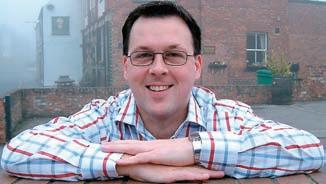
In Oxbridge, chapel music is now being strengthened by the appointment
It is worth remarking that at one time the post of director of music at Gloucester Cathedral prior to David Briggs arriving was regarded as a job for life. There had only been three organists in the 20th century; Herberts Brewer and Sumsion and John Sanders. Such was the attraction of the post, with its triennial commitment of directing the Three Choirs Festival. Now the flexible employment situation gives organists the opportunity for more diverse musicmaking. This realignment of the traditional cathedral organist’s job can only be good for musical development. Or is it? Could this mean the dedicated traditional lifetime specialism that produced talented masters of both arts, playing and directing, which was always a difficult marriage is gradually being phased out? Does this mean we are in a new era of nomads?
Finally a shining example of a nonnomadic organist isFCM’s VicePresident, Francis Jackson, who has been awarded the CBE in the Queen’s Birthday honours and in October he celebrated his 90th birthday: we all wish him well. He is a superb example of a lifetime dedicated to cathedral music as chorister, organist, choir director and composer.
Cathedral Music 4
P3 140 CM Nov 07 A:3302 Cathedral Music MAY #B5827 31/10/07 15:30 Page 4
‘There have certainly been a great many of what this magazine has always called ‘moves’ this summer amongst cathedral organists.’
Keeping the tradition alive at Ripon
Andrew Bryden Director of Music at Ripon Cathedral
What is a lay clerk? A question which I am sure all who are members of the Friends of Cathedral Music can answer without any difficulty whatsoever. In our electronic age with immediate access to the wealth of information that is the World Wide Web, a quick Internet search provides the uninitiated with the following concise definition.
‘A lay clerk, also known as a lay vicar, song man or a vicar choral, is a professional adult singer (or an accomplished amateur) in a cathedral or (occasionally) collegiate choir in the United Kingdom’.1
And yet this merely scratches the surface of an occupation which if unknown outside the cathedral music community, can be deeply misunderstood by those who have regular access and contact through their interest, governance and attendance at services.
To provide a fuller definition is complex to say the least. Of the forty-two Anglican cathedrals in England, no two are the same. There may be distinct similarities between respective music foundations, and to a certain extent a degree of categorisation can take place. But ultimately a number of other factors make each unique. Finance, geographical location and population size to name but a few.
So what is the background to the adult singers in our
cathedral choirs? The answer can be found in our ever expanding, and if recent press coverage is to be believed, sometimes inaccurate online encyclopedia.

‘The title (lay clerk) refers to the laymen who were employed to sing musical sections of church services during the Middle Ages. At the time, this was often music which was evolving into a format too complicated to be sung by many ordinary clerks and priests’.2
In looking for the fuller definition of a lay clerk the second sentence perhaps contains the clearest and simplest explanation. Lay clerks were, and still are, singers with musical experience and training who were, and are able to perform vocal music which is generally too difficult for the average person in the street.
This does not mean that lay clerks need to be professional singers, but rather singers with a high level of musical and vocal expertise. Little has changed since the Middle Ages in our requirement for competent singers but what has changed are the expectations of performance quality and standards.
Early twentieth century recordings and broadcasts of the finest choirs and singers in the country undoubtedly brought about a raising of standards in vocal performance. Modernday sophisticated editing techniques provide near perfect
Cathedral Music 5
P3 140 CM Nov 07 A:3302 Cathedral Music MAY #B5827 31/10/07 13:43 Page 5
Photo: Graham Hermon
performances on CD recordings. The advent of church music recording labels and companies leaves little cathedral music repertoire that has not found its way into a comprehensive church music CD collection.
And yet, despite all this exposure and awareness, the reality is that as standards continue to rise, the recruitment of the singers who are able to perform to this level has become more challenging and at times impossible.
“But there are numerous amateur secular choirs and choral societies flourishing throughout the country”, I hear you cry! “People want to sing! Why not recruit lay clerks from these choirs?”
One of the main skills required of a lay clerk is the ability to sing music proficiently at sight, or to learn music quickly and efficiently. Twenty minutes rehearsal before most services is normal in most cathedrals, and this does not allow time for the process of teaching the required music to the adult singers. Amateur secular or concert choirs/choral societies will often spend at least ninety minutes each week over many months preparing repertoire. In my experience singers with the required skills and expertise of a lay clerk are generally not drawn to sing in this type of choir. The constant repetition as the choir learns the music can become dispiriting.
We must also take into account the number of singers. In large choirs or choral societies there are perhaps at least fifty singers, and often more. This allows for a certain degree of flexibility in accuracy, blend and learning the music. There can be some ‘blurring of the edges’! Many cathedral choirs rely on six, or more normally twelve adult singers. If one singer struggles or is inaccurate, then the consequences can be quite devastating! With such relatively small numbers, that could mean one quarter of the choir being wrong!
Most people have the ability to drive a car. But few have the necessary skills to become a Formula One racing driver or the next Lewis Hamilton! Likewise most people have the ability to sing, but few have the necessary skills to be a lay clerk.
There is also the question of commitment. The local choral society rehearse probably once a week and perform a concert every three months or so. The normal cathedral choir will sing at least two or three services each week, with the vast majority singing at least four or five. At Ripon Cathedral the choir sings six days each week through term time with the lay clerks singing on five days including three services each Sunday.
Singing in a cathedral choir is onerous to say the least. It requires dedication and a commitment not just from the adult singers themselves, but also their families. Cathedral services do not follow sociable hours. Evenings and weekends need to be sacrificed in order to fulfil the required duties.

Being a lay clerk is not a full time job. Other employment is necessary, and there are very few salaried professions or employers which are able to provide the flexibility for someone to leave work in time to arrive for a choir rehearsal at five o’clock most days of the working week.
Part-time or self-employment can often provide the solution, but hours of work for an individual undertaking private music teaching can often clash with the hours of work required of a lay clerk. In general the salary of a lay clerk does not meet the income that is lost through being unable to work during the time when the lay clerk is employed by the cathedral.
So why do people take a lay clerkship? Well, for many it is a way of life. The ability to be part of a centuries old tradition, singing vast amounts of constantly changing repertoire on a daily basis is quite simply, an enjoyable experience. There is undoubtedly the camaraderie aspect as well. Coming together with a small group of like-minded individuals to produce something which sounds effortless and natural is very rewarding, despite the large amounts of hard work and expertise which have been expended to produce the end result.
At Ripon our difficulties in recruiting lay clerks began approximately ten years ago. We were sustained by a number of part-time appointments, and some singers who had been committed to the cathedral choir for over twenty years. As time passed and people moved on it became increasingly difficult to replace lay clerks. By September 2006 there were just four full-time lay clerks, with two vacancies being filled by a group of very willing and able deputies.
We were well aware that we were not the only cathedral to be facing such difficulties, but our situation had reached a more critical point than that of our colleagues in other institutions. It was obvious that a complete review was required with radical action needed to stem an impending crisis.
Ripon is the epitome of the English market town with a population of approximately 16,000. The Cathedral stands on the site of England’s first stone church, built by St. Wilfrid in AD672. Following the dissolution of its college of canons in 1547, the Cathedral once again became a collegiate foundation
Cathedral Music 6
Ripon Cathedral Choir
P3 140 CM Nov 07 A:3302 Cathedral Music MAY #B5827 31/10/07 13:43 Page 6
Photo: Graham Hermon
in 1604 when James I issued his Charter of Restoration and Ripon became the country’s fourth smallest city.
The present-day music foundation is similar to that which James endowed and consists of six lay clerks, 18 boy choristers, 22 girl choristers, a director of music, an assistant director of music and an organ scholar.
The decision taken by the Cathedral Chapter was not the first to be implemented to preserve the future of the Cathedral’s music. The purchase and foundation of the present choir school in 1960 was a decision which we can only marvel at today, and be thankful that due to the foresight of our predecessors the existing music foundation and daily services have continued.
A school dedicated to the general education of the cathedral choristers had existed until the late 1890s, and after its closure the choristers were educated (with some boarding) at Jepsons Hospital, a Blue Coat School founded in 1672. By all accounts this arrangement worked well and allowed the daily sung services of mattins and evensong to continue without detriment. In 1927 the Hospital closed and the choristers were recruited from a variety of local schools, most notably the Grammar School. The Cathedral and its worshipping life no longer came first. Dr Charles Moody, the Organist of Ripon Cathedral at the time, bemoaned this situation. ‘Time and time again I had to change settings and anthems at the last moment because of detentions at school’.3
It was Moody who first proposed the founding of a choir school, when he raised a question at the 1951 National Federation of Old Choristers in Chester. Moody suggested selling literary treasures held in cathedral libraries in order to fund the foundation of choir schools, and thus ensure the continuance of daily services. He questioned the justification in retaining such rare books (which were not accessible to the wider public) when cathedrals were desperately in need of money to sustain what they were built for, referring directly to Ripon which held Caxton Bibles and other rare works. Moody reported that, ‘My suggestion was not cordially welcomed by the press, and it was coldly received by the Chapter of Ripon’.4
In 1954 the Reverend Harry Graham was appointed Archdeacon of Richmond and Canon Residentiary at Ripon. He was given the task of raising £150,000 for repairs to the Cathedral. Within three years Graham achieved this target and soon after a local prep school, St Olaves, came on the market. Presumably with the assistance of Moody and a successor as cathedral organist, Philip Marshall, Graham set about persuading his chapter colleagues to undertake the proposal to sell the two Caxton Bibles to purchase the school.
The Caxton Bibles were sold at Sothebys on 31st May 1960 for £35,000. The media storm that ensued questioned why an appeal fund had not been initiated to save these treasures for the nation, but the subscribers to the earlier appeal for repairs had literally been bled dry and there was little hope of securing further donations so soon after.
From tentative beginnings the school soon grew with the number of non-singing boys increasing rapidly to provide a secure financial basis for the school to develop with a number of new buildings through the 1970s and 1980s. The school became co-educational in 1979 and today boasts a reputation for both musical and academic excellence.
And so to the present day and to the impending crisis of lay clerk recruitment. In 2006 a complete review of the music foundation was undertaken and a consultation document was presented to the Chapter in November. After two months’ work numerous ideas had been discounted, and finally two proposals
emerged which it was believed could rectify the situation.
The first proposal was to allow for a reduction of choral services with only the choristers singing services during the week. The full choir, with the lay clerks, would sing for Sunday services and major festivals. No extra financial investment was required and it was felt that a reduced lay clerk commitment might assist in recruitment.

The second proposal suggested an 85 per-cent salary increase for lay clerks. This would take Ripon into the top bracket of cathedral lay clerk salaries in England. Significant financial investment was required, but the established pattern of daily sung services would continue.
Following further consultation and discussion the second proposal was adopted and our lay clerk vacancies filled.
Our experiences in Ripon do not mean that all cathedrals will have similar difficulty in recruiting lay clerks. Certainly foundations in larger areas of population with the expected amenities and opportunities will probably continue to find little problem in maintaining the numbers of their adult singers. Likewise, cathedrals with inexpensive or free property available for singers will undoubtedly continue to fill their vacancies. The difficulties arise for the provincial foundations which do not have ancient endowments or a significant property portfolio.
Our solution at Ripon was the one which met our needs best with the resources that were available. It may not be possible to transfer the Ripon model to another cathedral that finds itself in our situation. Respective foundations will be required to examine and utilise their own assets.
The following was stated many times by many people throughout our consultations and discussions:
“If we allow the tradition to disappear we will not be able to bring it back. Once it is gone, it will be lost forever”.
The foresight of the successive Chapters of Ripon Cathedral has ensured the continuance of our music foundation. Let us hope that with the same support and vision others will be able to do the same should the need arise.
1 Wikipedia: The Free Encyclopedia.
2 ibid
3 A Choir School for Ripon Charles H. Moody (The Musical Times, Vol. 101, No.1409, July 1960, pp. 444-445)
4 ibid
Cathedral Music 7
Ripon Cathedral Choir
P3 140 CM Nov 07 A:3302 Cathedral Music MAY #B5827 31/10/07 13:43 Page 7
Photo: Graham Hermon
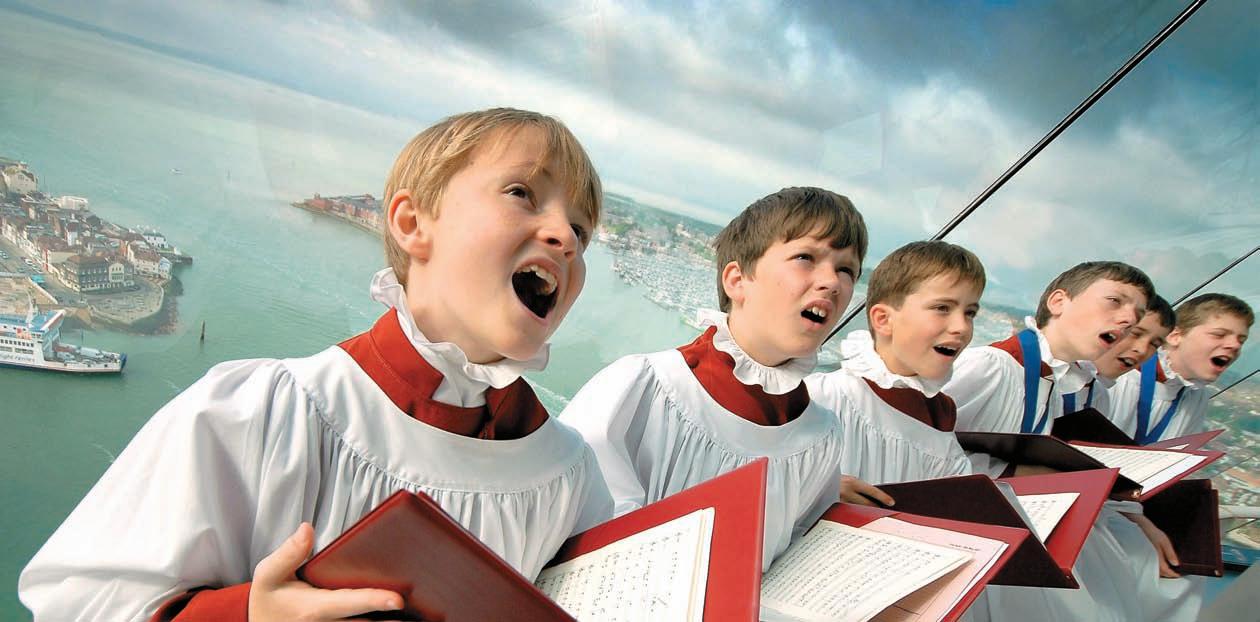
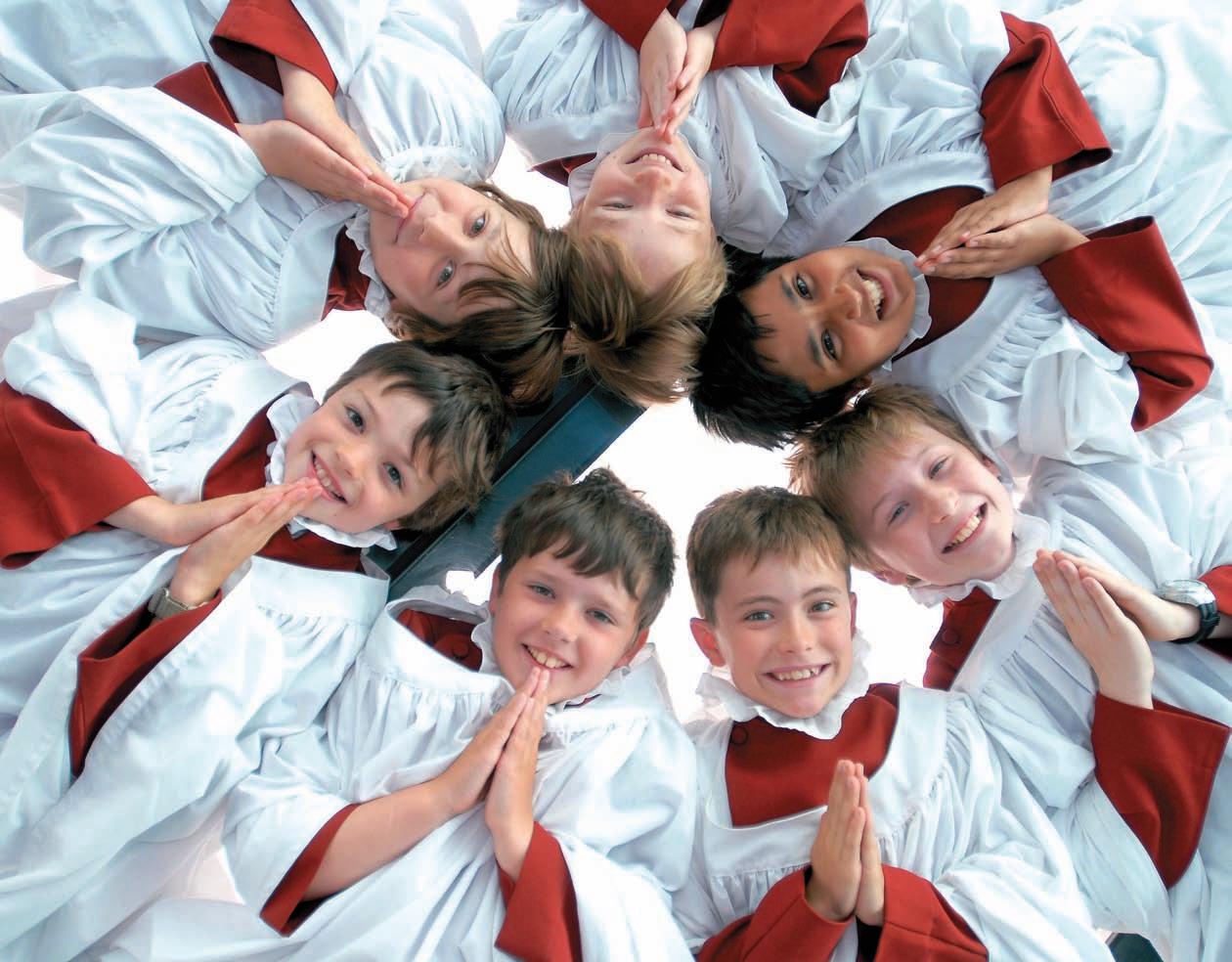
Cathedral Music 8
Choral Scholarship Scheme at Portsmouth David Price
Mind the Gap The
P3 140 CM Nov 07 A:3302 Cathedral Music MAY #B5827 31/10/07 13:43 Page 8
Portsmouth choristers sing at top of Spinnaker Tower,Portsmouth/on glass floor of Tower (330m above sea level)
Next year the Portsmouth Cathedral Gap Year Choral Scholarship Scheme (in its expanded form) marks its tenth anniversary. Over those ten years we will have seen 35 young men pass through the scheme. In the early days we often only had two or three scholars per year – nowadays we are more likely to have a larger team. The class of 2007 intake was a bumper one of seven choral scholars. It has been good to note a steady increase in those coming forward for audition –indeed this year we have two applicants for every place available.
The concept of a gap year for school leavers is not a new one (indeed the whole idea is now sadly on something of a decline nationally) but it is a relatively new concept for cathedral choirs.
How it works
We offer the chance for aspiring young counter-tenors, tenors and basses, possibly on their way to university choral scholarships or to a music conservatoire, the chance to sing in a cathedral choir for an academic year. We sing seven services a week, and so it is a good opportunity for young singers to develop their vocal stamina, their knowledge or repertoire, sight-reading ability and what it is like to be in the back row of a cathedral choir. We provide singing lessons with our vocal coach, Warren TrevelyanJones, and so we are able to keep a close eye on their vocal health. The choral scholars find themselves singing alongside our lay clerks for most services and so in that way, no undue pressure is placed on a young voice as would be the case if they were expected to hold a line unassisted.
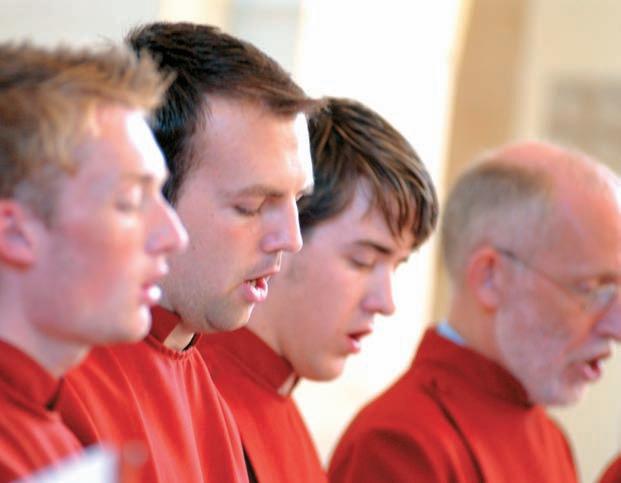
How we pay for it
An important part of the audition process is working out where a candidate might be placed to earn some money. Once they have passed the singing trial we look at our partnership institutions. First call goes to our choir school, Portsmouth Grammar School. This year three of our seven scholars are employed at the Grammar School working in the Sports Department, the Music Department and Junior School respectively. Every year, at least one of our scholars works in the Cathedral Music Office working alongside the Organist’s PA and the Precentor’s PA.
Our collaborations with the local state school music advisory service (Portsmouth Music Service) go deep, and one or two scholars a year are employed by them in their office and as

animateurs for choral music in local primary and secondary schools. In 2005 we had two Edwards working there. They recruited far more singers to the city’s youth choir than could normally be expected due to their youthful engagement with potential recruits and by their very nature as young role models. Readers will, I hope, note that this predates the new DfES and CSA initiatives by some considerable time. One of the Eds also worked in a school’s Rock Academy – thereby also breaking down a stereotype of angelic, stiff-necked cathedral choristers!
Where do they come from?
No sooner has the new choir year started every September than we start thinking about the next year’s set of recruits and their auditions. We have a very wide spread of schools who send their sons to us – for instance King’s Gloucester, Prior Park College Bath, King’s Ely, Trinity School Croydon, Lancing College, Shrewsbury School, Southwell Minster School, Charterhouse, Hereford Cathedral School and numerous London schools. It has been interesting to note that the balance of voices coming for audition over the last 10 years has been very even. We have been delighted to see quite a few young counter-tenors coming our way.
Cathedral Music 9
‘The concept of a gap year for school leavers is not a new one (indeed the whole idea is now sadly on something of a decline nationally) but it is a relatively new concept for cathedral choirs.’
P3 140 CM Nov 07 A:3302 Cathedral Music MAY #B5827 31/10/07 13:43 Page 9
Gappers 2005/2006 - Outreach project 2006
…where do they go?
Most scholars go on to make music at their chosen university once they have left us. It has been good to see a number proceed to the choirs of Magdalen College Oxford, New College Oxford, Christ Church Oxford, Trinity Cambridge, Durham University, Trinity London and Royal Scottish Academy of Music and Drama.
Being a Gap Year student
Tom Doig September 2007
I have taken up the position in the Cathedral Music Office doing administrative work and part-time at Portsmouth Music Service.
The phrase ‘in at the deep end’ never applied better than here at Portsmouth. I’ve never been so busy….
The kids are great – I love kids, and am now debating becoming a music teacher, which hadn’t really entered my head before now – and the atmosphere is so welcoming. The staff and the local people have really made me feel at home. Thank you Portsmouth.
Looking back
Ed Maclean Choral Scholar 2005-2006
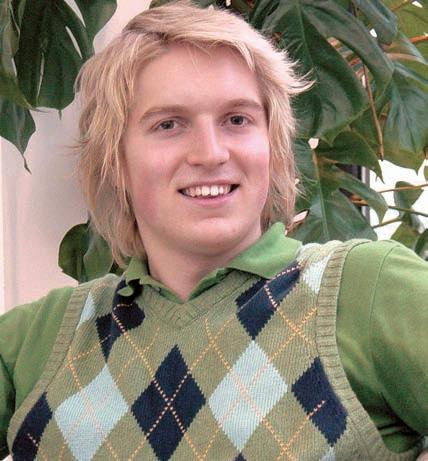
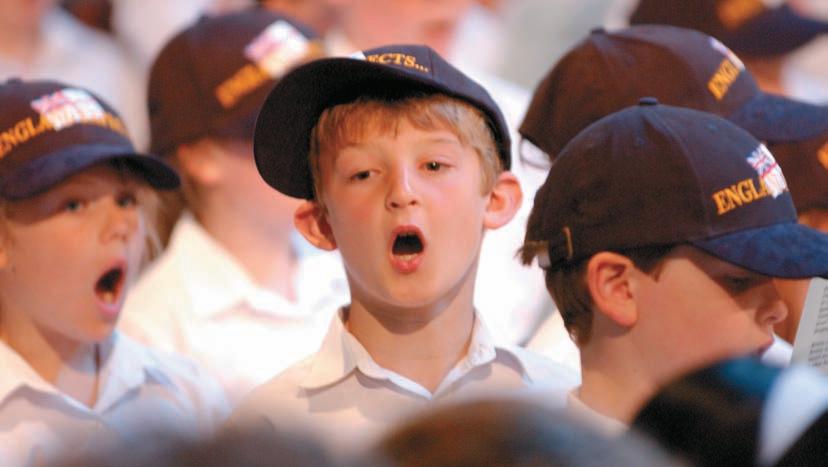
I’d committed myself to doing medicine, but I thought, “I’d like to have a musical year.”
I’d been head chorister at Portsmouth, but the choral scholarships are such a different and attractive package that I thought it was worth doing. You really have your skills finely tuned. David Price is a great guy and a good laugh, but he’s also professional. The choral scholars form a close harmony group called Stop Gap. We released an album and the proceeds went to Macmillan Cancer Support. Recording experience is a good insight into the music business; you’ve got to be very patient, and you have to be a team player.
The choral scholarship structure at Portsmouth Cathedral is unique. You don’t just do seven services a week and help with the choristers; you also have an attachment in the community, teaching in the grammar school or, as I was, working with the local music service... That was really good for me, I did all kinds of things; directing and training ensembles; attachments with the Youth Choir and Orchestra, playing for productions at the King’s Theatre: and we were involved in event management, managing an instrument database and delivering instruments to primary schools. We gave recitals
and presentations on the benefits of youth music, and I got a teaching placement in the Popular Music Academy.
The PMA is a school that draws from the city’s underprivileged areas, so it was a good experience for me. I was only a gap year student, 18 years old, and yet I was teaching 14-16 year olds. It really made me appreciate how music is an inspiration for kids. Some of them had personal difficulties, low self-esteem and weren’t very motivated at first. You have to draw on all your experience to get them inspired and working – and it was hugely rewarding to see the progress they made. You never know how good you are at something until you try to teach it to someone else. I think my communication skills improved – when you’re doing presentations in front of sceptical teenagers you have to be very sure of yourself or you won’t last five seconds!
It was a brilliant year. When I started it, I definitely felt 18 years old; when I finished it I had so much life experience, working with all these kids I felt 25!
Andrew Henderson
Choral Scholar 2005-2007
My mother forbade me from having a gap year before university. My experiences at university, both musical and otherwise, taught me that gap years are valuable for personal and, in the case of choral scholarships, musical development. It was with this mindset that I applied to a number of cathedrals for gap year choral scholarships after my degree.
In due course, I found myself singing in the choir of Portsmouth Cathedral, under Dr David Price (as he now is), living with two other ‘gappers’ - both 18-year-olds - in the Cottage, on the High Street in Old Portsmouth, just 400yds from the beach.
The lay clerks are used to the changing personalities amongst the choral scholars, and the community life amongst the back rows is based on a sense of acceptance by the one cohort of the other. However odd the combinations have been in some years, the unity demonstrated in the service has always been continued in The Dolphin afterwards!
The pre-university choral scholars have headed to a second choral scholarship at many prestigious institutions, including Oxbridge colleges and other cathedrals, whilst the graduate scholars have variously returned to university and gone into employment, either in music (with a West End star amongst
Cathedral Music 10
P3 140 CM Nov 07 A:3302 Cathedral Music MAY #B5827 31/10/07 13:43 Page 10
Outreach 2005 (Trafalgar200), Ed Maclean - Choral Scholar 2005/2006
2006 P3 140 CM Nov 07 A:3302 Cathedral Music MAY #B5827 31/10/07 13:43 Page 11
the alumni), the Church (the first ex-scholar curate has returned to Portsmouth diocese, with a second training for another diocese), or in other professions.
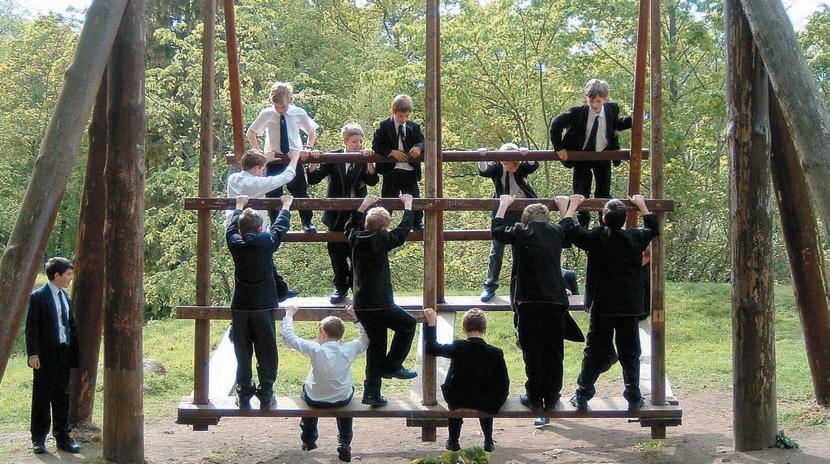
It has become traditional for a number of the scholars to work at the Portsmouth Grammar School in an administrative capacity. Whilst some of the duties inevitably include photocopying, there are opportunities to teach instruments, theory and aural skills. It was this experience that led me into teaching at the School for a year after my scholarship, continuing to sing at the Cathedral, and now to a PGCE.
Gap years are valuable if arranged by an inspiring and
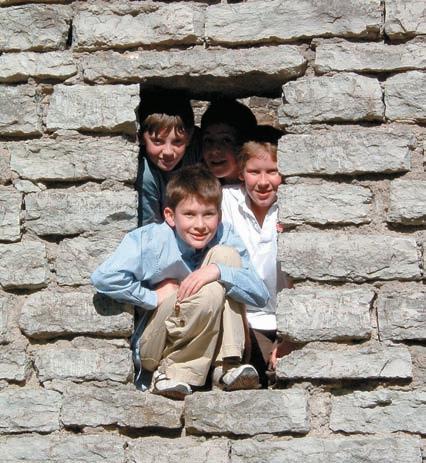
Common Praise
Main features include:
Familiar words set to new and different alternative tunes. New musical arrangements. Tunes and words in new combinations which put both into fresh perspective.
Twentieth century words and music included for the first time.
Five editions available.
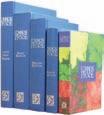
responsible authority; Portsmouth Cathedral and the Portsmouth Grammar School make an effort together (not forgetting that both the outgoing and incoming headmasters are accomplished musicians, and that the School’s Director of Music is also in charge of Cantate! at the Cathedral) to act in unison in organising a scheme which is important not only to individuals but also nationally.
Portsmouth’s scheme has spawned a curate and an ordinand, a number of teachers, several Oxbridge choral scholars, and at least one West End star. I am proud to be one of their number; indeed, I stayed for a second year. The scheme makes an
AllEditionsOutNow! New English Praise
A Supplement to the New English Hymnal
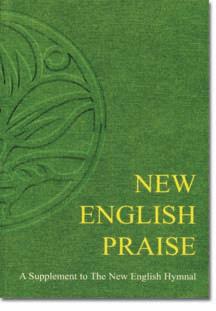

An entirely new supplement. Comprising fifty hymns together with a range of seasonal material and responsorial psalms and some new tunes for existing items.
Full Music
1 85311 264 5
1 85311 266 9 171 x 114mm ·hardback 608pp · Ref.
To order/request a grant application form: Tel: 01603 612914 or Fax: 01603 624483, write to: SCM-Canterbury Press Ltd, St Mary’s Works, St Mary’s Plain, Norwich NR3 3BH, or email admin@scm-canterburypress.co.uk
Published to mark the centenary of English Hymnal of 1906. Includes material from the Common Worship: Times and Seasons volume
Available in 3 attractive editions.
To order/request a grant application form: Tel: 01603 612914 Fax: 01603 624483 SCM-Canterbury Press Ltd, St Mary’s Works, St
Mary’s Plain, Norwich NR3 3BH. E-mail: orders@scm-canterburypress.co.uk
Cathedral Music 11
25%
TRADITIONAL · CONTEMPORARY · COMPREHENSIVE · ESSENTIAL
GrantAvailable*
978
210
1440pp
193
*To qualify for a GRANT OF 25% an order for a minimum of 20 COPIES, in any combination, of Common Praise hymn books, together with a completed grant application form (available on request from SCM-Canterbury Press Ltd) must be received. CMCP07 1056pp
x 140mm · hardback
· Ref. No 49 Usual Price £25.00 With 25% Grant*£18.75 Melody 978 1 85311 265 2
x 124mm · hardback
· Ref. No 47 Usual Price £13.50 With 25% Grant*£10.13
978
No
Usual
With
Words (cased)
45
Price£9.99
25% Grant*£7.49
978 1 85311 267 6 171 x
· paperback 608pp · Ref. No
Usual
With
Large Print Words 978 1 85311 467 0 240 x 160mm · hardback 608pp · Ref. No 41 Usual Price£19.00 With 25% Grant*£14.25 All editions are in hardback blue cloth,
words paperback
colour cover
Words (paperback)
114mm
43
Price£5.00
25% Grant*£3.75
except for the
which has an attractive full
Main features include:
Full Music Edition 978-1-85311-724-4 210 x 140mm · Sewn with printed softback covers 320pp Usual Price£15.00 With 25% Grant* £11.25 Congregational Edition 978-1-85311-730-5 210 x 140mm · Sewn with printed softback covers 240pp Usual Price £9.00 With 25% Grant* £6.75 Organ Edition 978-1-85311-735-0 234 x 150mm · Spiral-bound with printed softback covers 320pp Usual Price£25.00 With 25% Grant* £18.75
*To qualify for a GRANT OF 25% an order for a minimum of 20 COPIES, in any combination, of New English Praise hymn books, together with a completed grant application form (available on request from SCM-Canterbury Press Ltd) must be received.CMNEP07
Choristers on tour to Estonia
important contribution to music and the Church; for many people, it is the archetypal gap year choral scholarship.
Portsmouth Cathedral Choral Scholar Scheme: A Lay Clerk Writes…
When David Price arrived from Ely as Organist and Master of Music, he inherited, through no one’s fault (because several lay clerks had moved on during the previous months for job and family commitments) a choir consisting of 14 boys, five of whose voices broke over the summer, three altos (whose voices didn’t), two tenors and one bass, who was that year’s single choral scholar and assistant music librarian. (S.S. Wesley had it easy - at least he could rely on the Dean’s butler to turn up after luncheon to sing the bottom line.) But with his characteristic verve and youthful energy David quickly recruited a number of students and VIth Formers, often former choristers, to come to the aid of the party. Over the years this scheme has grown and developed so that now we enjoy the company of up to five or even six official scholars, some pre- and some post-university, to add to the eight permanent lay clerks who provide the continuity (dare one say stability?) from year to year. This scheme has in many ways transformed the cathedral’s musical and social life.

Portsmouth has always been a chummy, matey city and each new bunch of scholars soon comes to realise that there are no divisions or stand-offishnesses in the musical establishment. Whilst clerks may be more experienced, the scholars are often very talented and evince great musical and personal development as the year progresses: I have not known any of them yet who has not found the year to be highly beneficial. From a lay clerk’s point of view, whilst it is good to have the company and understanding of colleagues with whom one has sung for ten or even twenty years, it is great to have the injection of fresh blood, and of such a variety of personalities, that the scholars provide. We like to think they help to keep us young, and abreast of the latest developments in Rap, Emo and Hollyoaks. If they occasionally bite off more than they can chew (or swallow) on the Saturday night before the Sunday morning, it’s all a good learning curve for their future university and college years. They are also, on the whole, a
great help to the Master of Music in helping to shepherd the choristers and provide them with encouragement and support. (Many of them are ex-cathedral choristers themselves, of course, from both boarding and day institutions.) It is difficult now to remember quite what it was all like before the scholar scheme was fully up and running: quieter on foreign tours, certainly, but probably less fun too. For a clerk, the ability to sing next to someone new every year, to offer advice and encouragement and occasionally to demonstrate that even the best of us sometimes sings a wrong note (all right then, all the right notes but not necessarily at the required time...) is also a beneficial and a learning experience. Now that the cathedral has solved the problem of permanent accommodation for such a burgeoning group of students we can look forward, in perpetuity we hope, to the present balance being maintained..... Oh, and of course all those updates on Hollyoaks
Martin Cawte
Why do it?
We could not sustain what we do at Portsmouth without the gap year scheme – or at the very least it would be a drastically reduced choral programme. Our partnership with our choir school Portsmouth Grammar School continues to grow in strength and interconnectedness as well as with Portsmouth Music Service – a relationship which enters a new phase with the possibility of DfES money. For the future – we look to recruiting some female gap year students to work alongside and mentor our girls in Cantate! (the cathedral’s new youth choir), and to sustain the steady stream of young people auditioning for places here. All this will help to maintain the opus Dei – the work and worship of God in Portsmouth Cathedral.
David Price is Organist & Master of the Choristers, Portsmouth Cathedral
Auditions for choral scholarships at Portsmouth Cathedral for the academic year 2008-2009 will take place in December 2007 and April 2008. More details from www.portsmouthcathedral.org.uk and organist@portsmouthcathedral.org.uk
Cathedral Music 12
P3 140 CM Nov 07 A:3302 Cathedral Music MAY #B5827 31/10/07 13:43 Page 12
Portsmouth Cathedral Choir - choristers, choral scholars and Layclerks at the 150 anniversary of the Victoria Cross - attended by HRH Duke of Edinburgh.
PASSION FOR DESIGN OPENS DOORS FOR WHOLE CHURCH COMMUNITY
The combined expertise of a retired local architect and a Yorkshire construction company has transformed a Pontefract church building into a valuable community asset. Wakefield specialists FP Construction, owned by award-winning Space2Work specialising in office design and refurbishment, was invited to work on the refurbishment of the worship area of the church by well-known architect, Derek Curtis. As part of the phased programme of refurbishment, the worship area needed expert attention and an innovative redesign to overcome the problem of poor acoustics. Managing Director of FP Construction, Stephanie France said: “Derek is so passionate about the church and this is why it was a really extraordinary project to work on. The people who use it were the main drivers behind all the design decisions. The building performs a variety of functions for a mix of generations and interests so the facilities had to work for everyone, whether they attended church services, play groups, youth groups or sports clubs.” The Central Methodist Church, Pontefract was built over 52 years ago with help from a grant from the J. Arthur Rank Trust. The film producer and founder of the Rank Organisation was a devout Methodist and gave grants for the building of churches after the Second World War. The funding was conditional on the design allowing the building to be easily converted to a cinema, should it fail to thrive as a church. Provision was made for a ticket office, a curtained stage and even an organ pit. The original design has proved to be restrictive as the church fulfils the role of a community centre as well as a place of worship. Derek Curtis, founder of West Yorkshire’s D.J. Curtis and Associates Ltd agreed to come out of retirement to produce a design that would improve the acoustics and allow the building to be successfully used as a concert venue. “Due to the curtains and other sound-absorbent surfaces, it was difficult to sing and play music in the church. Sunday hymn singing was affected and choral groups and brass bands just wouldn’t perform here.” said Derek.
RSCM APPOINTS NEW DIRECTOR
Lindsay Gray, currently Headmaster of The Cathedral School, Llandaff, Wales, will take over leadership of the RSCM from Professor John Harper during spring 2008.
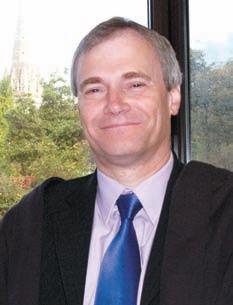
Lindsay Gray has wide experience in education, in church music, and in inspiring young people. He has sung in some of the great choirs of Britain, and directed choirs in parish, school and cathedral settings. Brought up in Nottinghamshire, he gained the ARCO organ-playing diploma before he left school, subsequently winning a choral scholarship to King’s College Chapel, Cambridge, under the direction of Sir David Willcocks and Sir Philip Ledger. He continued his studies at Durham University, where he sang in the cathedral choir and directed a parish church choir. He was Director of Music at Queen’s College, Taunton (where he also directed the Somerset Youth Choir) and at Cheltenham College, before moving into educational leadership and management.
Lindsay Gray, said: “I care deeply about the continuing choral tradition and I firmly believe in encouraging different types of music in a variety of different worship settings. At the same time I am conscious that the number of young people involved in church music has steadily declined over a number of years and I relish the opportunity to work within the RSCM to assist in reversing that trend.”
News from Choirs and Places where they sing
St. Peter & St. Paul, Aldeburgh ORGANIST REQUIRED
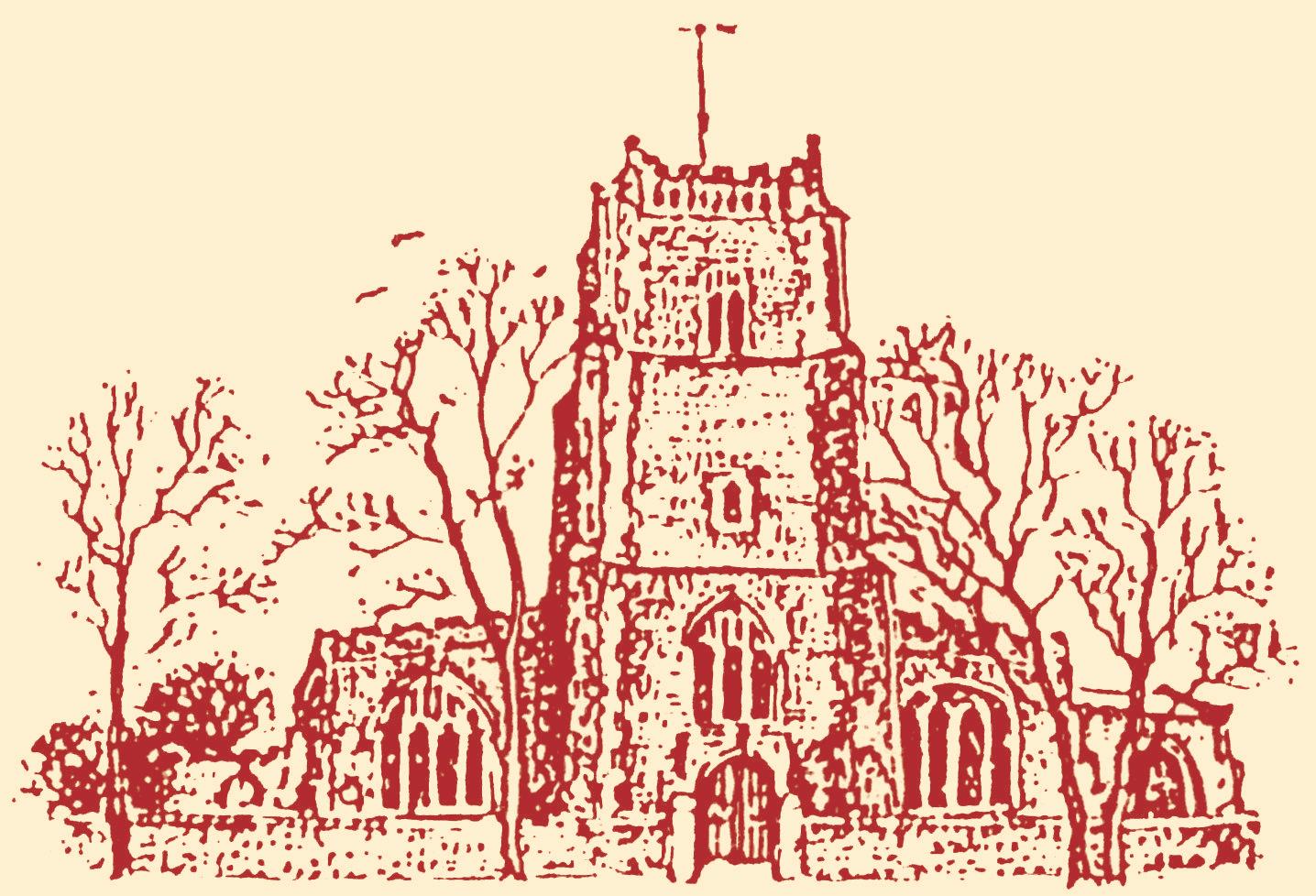
to work with the Director of Music, as we refresh our music in the home of the Aldeburgh Festival. Fine Hunter two-manual organ and Ibach grand piano available, for private tuition use.
Information pack available from the Vicar, Revd. Nigel Hartley, 01728 452223 or by email to aldeburghparishchurch@btinternet.com
Closing date: 14th December 2007.
Cathedral Music 13
NEWSBITE
P3 140 CM Nov 07 A:3302 Cathedral Music MAY #B5827 31/10/07 13:43 Page 13
Publication, publication, PUBLICATION
Philip Ledger’s best-selling arrangement of This Joyful Eastertide has a certain familiarity about it, being based on a traditional Dutch tune. Performances are repeated each year and, in a good way, the piece is predictable. It moves beyond the version by Charles Wood, but does not attempt to break new ground musically. This makes it fit for purpose in the church music market today.
The origins of Encore Publications date back to 1992. Having heard Philip Radcliffe’s carol, The Oxen, broadcast on radio, my curiosity to find the sheet music took me to the Rowe Music Library in Cambridge, where his manuscripts are kept. After reading his unpublished scores, I made what, at the time, seemed like a bold decision to
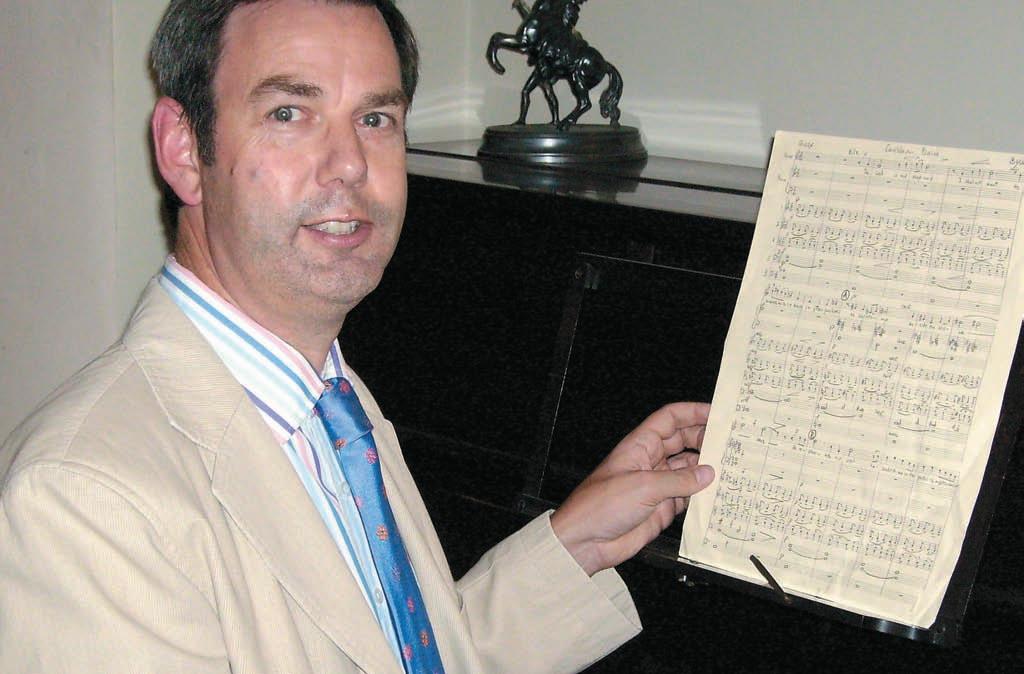
Cathedral Music 14
Tim Rogers shares his thoughts on church music publishing
P3 140 CM Nov 07 A:3302 Cathedral Music MAY #B5827 31/10/07 13:43 Page 14
‘Daily radio is about familiarity, repetition and even predictability,’ writes Terry Wogan in his autobiography Mustn’t Grumble. In some ways, the same could be said of church music, whether used in daily worship or from Sunday to Sunday. When reflecting on 15 years of publishing under the imprint of Encore Publications, I too mustn’t grumble.
buy some of the copyrights and start my own publishing business from scratch.
The financial investment in Radcliffe’s music proved a sound one (in all senses). As a teacher and writer, he had influenced many of those holding key posts in the world of church music. However, if it had not been for the support of Stephen Cleobury, Barry Ferguson, Richard Lloyd and Philip Moore in the early days, then the venture would never have become established. Bryan Kelly and Alan Ridout provided further backing as composers from outside inner church music circles.
Trading conditions favoured the growth of small publishers of church music around the early 1990s. Novello and some larger firms were focusing on their house composers rather than taking contributions from others on a work-by-work basis. The RSCM became dormant as a publisher and lost market share. And specialist catalogues, such as the Church Music Society and Roberton Publications, changed their distributors. All in all, there were opportunities within a niche market.
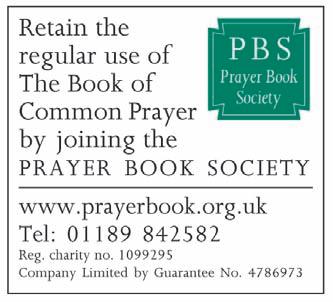
In building the Encore Publications list there has been a fine balance between an overtly commercial approach and producing works with recognisably less sales opportunities. While working for the Music Sales Group, I was encouraged to ‘follow the dollar’. However, my next experience working as publisher to the RSCM came as a sharp contrast. When making decisions about new items for Encore Publications, I swing between these opposite positions. It’s a luxury of being an independent publisher: I do not have to follow a policy imposed by head office – it’s always my own decision, not the collective responsibility of an editorial board or outside advisers.

As a student at Cardiff University, I had an interest in the music of contemporary Welsh composers, particularly William Mathias; and his representation of praise. And praise has remained a key element in many of the works published by Encore Publications. It is an integral part of worship and a recurring point of reference in my work as a publisher (e.g. Praise His Name in the Dance by Bryan Kelly, A Garland of Praise by Richard Lloyd or Easter Song of Praise by Philip Ledger).
Initially, I had a strategy of publishing a large number of short pieces each year, rather than investing in a few large ones. My aim was to create an impact in the crowded market in terms of the number of works. For this reason, I would make commercial decisions to divide the cost of publishing across ten four-page choral leaflets instead of one 40-page work. It was a case of not putting all my eggs in one basket and
spreading the financial risk.
My approach has changed over time as the business has grown. The temptation of publishing more extended works, such as Andrew Millington’s Missa Alme Pater, became too hard to resist. Yet, investing in a large-scale work can affect significantly the publishing programme for the rest of the year. Philip Ledger’s newly composed Requiem (A thanksgiving for
Cathedral Music 15
‘
P3 140 CM Nov 07 A:3302 Cathedral Music MAY #B5827 31/10/07 13:43 Page 15
My aim was to create an impact in the crowded market in terms of the number of works.’
life) is a major choral work published in 2007. It’s not only his most extensive piece to date, but also the largest to be published by Encore Publications, originally written for soprano and tenor solo, poems by Thomas Traherne and traditional latin texts. This piece has also been rescored in two different instrumentations: for orchestra (without organ); and for organ alone.
As well as making individual decisions, I have to keep in mind the make-up of the entire catalogue, trying to produce a varied range of titles that are suitable for seasons and Holy Days throughout the Church’s year. Some years ago, I felt that the balance was weighted too heavily towards Advent and Christmas. I set about changing this so that the pattern of sales became flatter and more could be achieved in the period before Passiontide and Easter. I published John Scott’s St Luke Passion as an alternative to the St Mark Passion by Philip Moore and I commissioned June Nixon’s hymn-tune arrangements of There is a Green Hill and Love’s Redeeming Work is Done, plus a setting of Most Glorious Lord of Life by William Llewellyn. It was a business model akin to the ice-cream maker,
Walls, selling sausages in winter so as to generate turnover for the full 12 months of each year.
Except for one publication by Holst, the complete catalogue is made up of copyright works, which have the potential of earning income from broadcast performances and recordings, as well as sheet music sales. It’s also no accident that my catalogue comprises works by more than 35 past and present cathedral organists. They make choices about music performed on a daily basis. They are receptive to programming new music and also exert a strong influence beyond their immediate cloisters, reaching out to their local parishes and beyond.
Young composers can find it difficult to have their works published by the larger houses. For this reason, it has been my policy to support the younger generation of church musicians, such as Peter Barley, Philip Godfrey, David Goode, Andrew Lumsden and Timothy Noon. In this way, the catalogue stays fresh with contributions from a growing list of rising stars, balancing some more established church musicians including Christopher Gower, Edward Higginbottom and Colin Mawby, amongst others.
Engagement with Scripture is one of the key elements at the heart of the Church tradition. And the choice of a text will often ‘set the scene’ for any
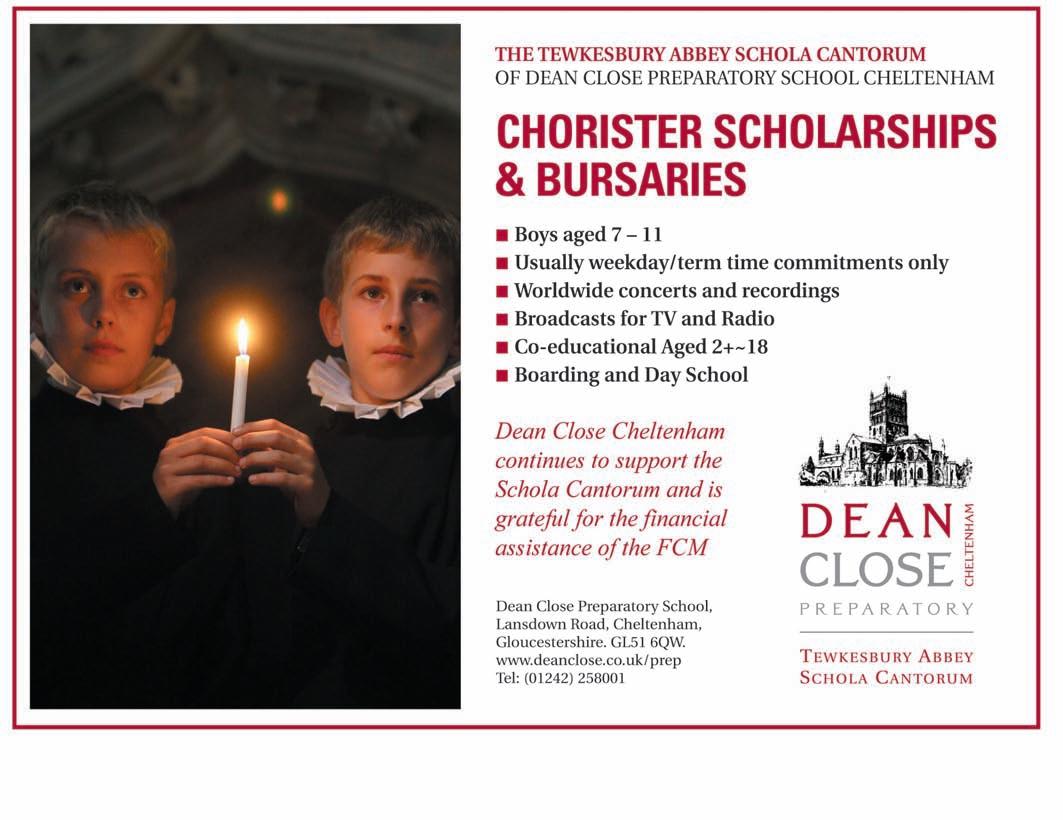
Cathedral Music 16 P3 140 CM Nov 07 A:3302 Cathedral Music MAY #B5827 31/10/07 13:43 Page 16
‘Young composers can find it difficult to have their works published by the larger houses. For this reason, it has been my policy to support the younger generation of church musicians...’
associated music. Sometimes, familiarity has been the starting point in the publishing process. Pieces such as Philip Ledger’s settings of Jesus Christ the Apple Tree and A Spotless Rose and also Peter Aston’s anthem, If Ye Love Me came about by a conscious decision to select classic texts. It’s a process whereby prospective performers are encouraged to think they already know a piece without having heard the music.
On other occasions, I have been delighted to be associated with some fine original texts by leading clergymen. The poems of Rowan Williams were already well known before Philip Ledger set his Advent Calendar, but other publications have involved words and music being published for the first time. Richard Shephard composed two carols, In Darkness Held and Like All, But Like No Other using words by Jonathan Draper (Canon Theologian of York Minster).
based on the descriptive words of Robert Willis (Dean of Canterbury).
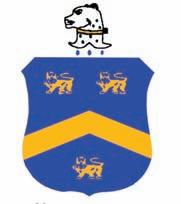
Because I’ve always welcomed submissions of unpublished manuscripts, my ‘slush pile’ has been a rich and fertile source of publishing. My post bag bulges to the point where I’m often faced with difficult choices. Recent submissions have come in from a diverse group of people including a cathedral organist, an organ scholar from an Oxbridge college, a 12-year-old choir boy, a professional singer and BBC choir member, and a dean. The quality is impressive and I wish that I could publish more than I do. But it’s important to manage the flow of new titles so that works are published in a timely manner. Manuscripts accepted for publication should never remain ‘in preparation’ for too long.
early in 2008. And Louis Halsey has just written an Easter carol Spring Bursts Today with words by Christina Rossetti. No publisher knows if any new publication is going to sell well, until it has been tried in the market. You can stack things in your favour by publishing musical sequels (e.g. Bryan Kelly’s Preces and Responses in C) or tie-ins (e.g. James Whitbourn’s Crown My Heart, an anthem based on the theme music of BBC2’s Cathedral Calls). You can have all the right ingredients for a successful item –the composer, the text, the length, the level of difficulty, the selling price, a prestigious first performance, a broadcast and recording – and still end up with a small return.
Other Christmas items have involved collaborations between Jonathan Barry (Canon of St Patrick’s Cathedral, Dublin) and Harry Grindle in Heaven Song, as well as Jonathan Meyrick (Dean of Exeter) and Andrew Millington in A Carol of Hope. Another anthem, The Burning Bush by Richard
Shephard,
is

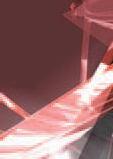

More often than not, I will approach composers asking them to write a particular piece, rather than waiting for the post to arrive. Colin Mawby’s dramatic setting of The Donkey, which is suitable for Palm Sunday, came about in this way, soon after G. K. Chesterton’s famous poem became public domain. In recent months, Richard Lloyd has composed a new setting of The Reproaches, which is due for publication
Even if you have a good instinct for what might become a best-seller, there’s absolutely no certainty in the publishing process. The essence of the business is about offering a wide choice of different styles of music that are well produced, reasonably priced, and released in a steady flow throughout the Church year – publication, publication, publication.
Tim Rogers is Managing Editor of Encore Publications (www.encorepublications.com) Contact
London College of Music Examinations

Diplomas in Church Music
•offered at Associate, Licentiate and Fellowship levels
•for organists, instrumentalists, singers and Directors of Music of all denominations
Grades and Diplomas
•wide range of graded exams, leisure play levels, performance and teaching diplomas
•graded exams accredited by QCA
fax: 020 8231 2433
lcm.exams@tvu.ac.uk
http://mercury.tvu.ac.uk/ lcmexams
Cathedral Music 17
us for syllabuses, publications catalogues and further information.
LCM Examinations Walpole House Thames Valley University 18-22 Bond Street London W5 5AA tel: 020 8231 2364
- - breaking new ground in arts qualifications -Teaching Diploma Syllabus ALCM and LLCM in Teaching Syllabus for Graded, Leisure Play and Step Examinations in Electronic Keyboard and Electronic Organ London College of Music Examinations Syllabus for Graded and Leisure Play Examinations in Music Performance
George Sixsmith & Son Ltd Organ Builders We provide all types of new instruments New Organs Restoration Rebuilding Tuning Maintenance
can give unbiased advice for all your requirements
Organ Works
Road, Mossley,
Tel:
833 009
P3 140 CM Nov 07 A:3302 Cathedral Music MAY #B5827 31/10/07 13:43 Page 17
We
Hillside
Carrhill
Lancashire OL5 0SE
01457
Fax: 01457 835 439
Story from Christopher Brayne Across the Pond
My musical journey began as a chorister at Lichfield Cathedral and from there via the Royal College of Music, St George’s Chapel, Windsor, Emmanuel College Cambridge, Wells and Bristol Cathedrals to Christ Church, Charlotte, where I have been Director of Music and Organist since 2000. It has been a fascinating experience so far and here in the USA I am joined by a number of other English organists and choir trainers eager to impart and share their gifts as well as learn from their counterparts here. For this writer I never envisaged taking a trip across the Atlantic to work and yet for me this has been one of the most fruitful, educating and fulfilling positions I have undertaken in my career to date.

In a recent article in CMQ David Hill touched upon why English organists and choir trainers are looking further afield –‘we need to look at the USA and the focus they provide for organists and conductors and the care they take in providing them with their positions in their communities as leaders in their field… by comparison with other similar jobs in the music profession, church and cathedral musicians (in the UK) fall a
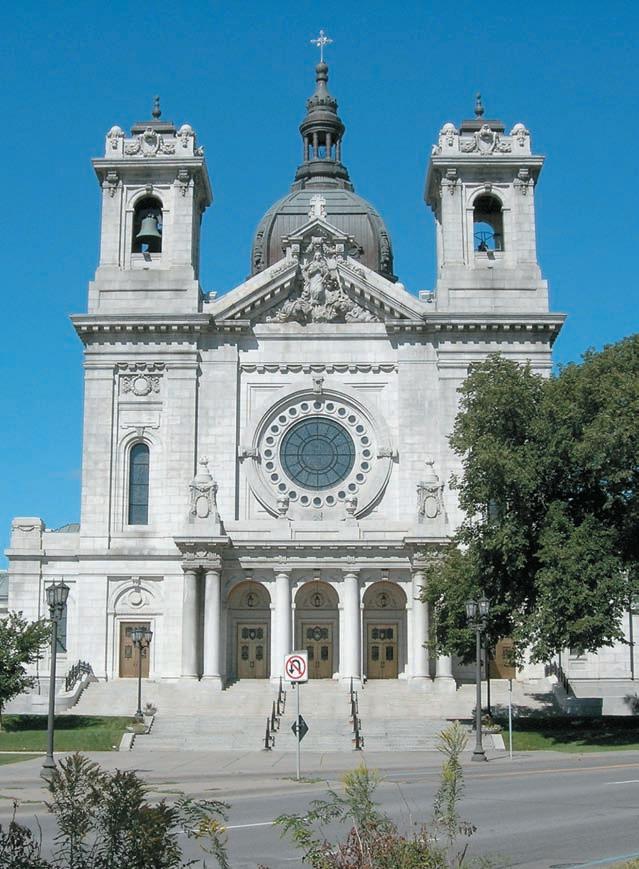
Cathedral Music 18
‘...we need to look at the USA and the focus they provide for organists and conductors...’
P3 140 CM Nov 07 A:3302 Cathedral Music MAY #B5827 31/10/07 13:43 Page 18
Minneapolis Cathedral – Trevor PawsonWashington National Cathedral Courtesy of Washington National Cathedral
long way short of the proper remuneration they deserve.’
Well back in April 2000 I began a new chapter in my career by accepting the offer to become Director of Music and Organist at Christ Church, Charlotte in North Carolina. Here I am responsible for recruiting and training singers of all ages from youngster to adult, planning a music programme for the parish and advising the clergy on all musical matters which appertain to the liturgical life of this church. I meet with all the clergy on a weekly basis and with the Rector fortnightly. I am also responsible for managing a large budget which I am handed by the Vestry annually. Inevitably it would be easy to make comparisons with my time as a cathedral musician in the UK but the purpose of this article is to try and give an insight into some of the reasons why I believe we can learn so much from our colleagues on this side of the Atlantic.
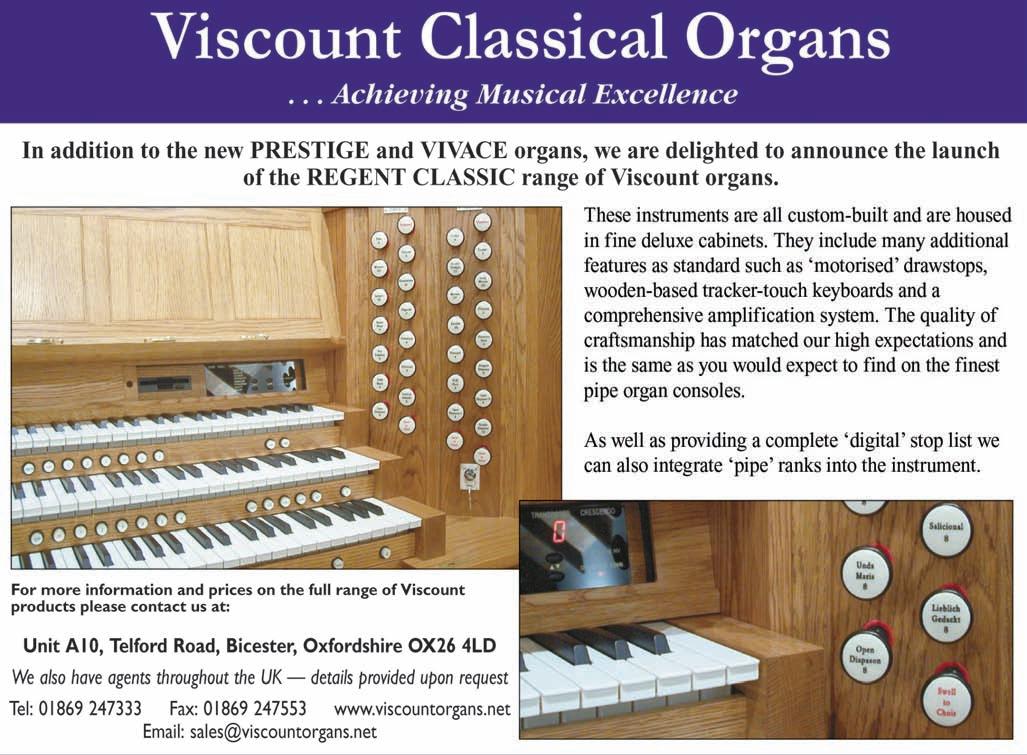

Apart from a beautiful building in which to create music I
enjoy a large rehearsal space, a fully-equipped office and the opportunity on a regular basis to gain further education in a variety of disciplines associated with my work. There are a number of institutions which offer degree courses in church Music and virtually every month there are courses available for church musicians to enable them to develop their skills and share ideas. However, the area which struck me most is that of collaboration and involvement in the whole picture of the work of the Church. A few months ago we began a project entitled ‘Expanding our Vision’ which involved setting up a plan for the next five years in the life of Christ Church. Under eight headings or commissions: Music and Worship, Children and Family Ministry, Youth Ministry, Adult Spiritual Formation, Senior (Sages) Ministry, Congregational Care, Parish Life and Fellowship, Mission and Outreach, we were asked to listen to our congregation’s views and also to look at other church’s
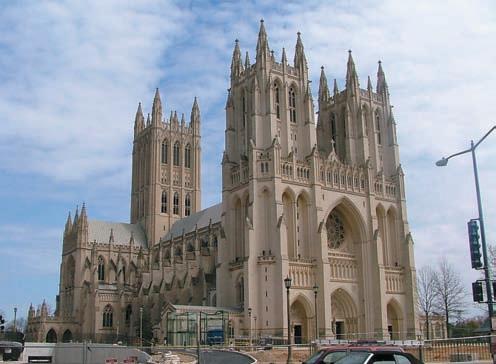
Cathedral Music 19
Washington National Cathedral
Photo: John Walter
P3 140 CM Nov 07 A:3302 Cathedral Music MAY #B5827 31/10/07 13:43 Page 19
Christ Church Charlotte, NC
offerings and from that draw up a plan for our ‘Vision’. During this process it became apparent that there were some common goals as well as new initiatives which would form the basis of the plan and move us to our current stage at the time of writing ‘Fulfilling Our Vision’. With all the wishes and dreams gathered, it falls to the Vestry and the Rector to decide on priorities and costs for each commission and area of the Church’s life over the next five years. What an exciting time for us all, as the process throughout has been transparent and we now know that consideration is being given to all the proposals put forward by the eight Commissions. Under Music and Worship we are looking to have orchestral instruments at every service in the church on Sundays, thereby giving an even greater scope for adorning our liturgy and allowing me to work with members of the Charlotte Symphony and setting up an independent orchestra which will be known as the Orchestra da Camera. In other areas we have hired a full-time food service coordinator who will provide Sunday Brunch and a midweek dinner as well as other meals throughout the week. We are taking a leadership role in the affordable housing crisis here in this city and working with the Episcopal Diocese of Costa Rica to help their children have a bright and positive future. We are focused on making a difference in the community and taking on national and international issues through a variety of initiatives. For me, to be a part of this vision/process has made a huge impact and most importantly made me feel a part of a team who have the same goal rather than a dysfunctional approach where one is left isolated and uncertain of how the larger picture can be developed. In addition, having full knowledge of the church budget and how it is divided makes for
a greater understanding of how my work fits in. One of the main differences over here lies in funding. It also brings up the fine dividing line between being a church and a business. However, setting that aside, the membership of each church helps to determine to a certain extent what it is possible to achieve and what people are really passionate about. Each member is encouraged to make a sacrificial offering each year and from that the budget for the year is determined. In addition to this we receive donations from a variety of sources to enable us to carry out our work. To put it in business terms, we have a large number of shareholders who have a vested interest in how we go about our daily work. I am fortunate to have both financial and pastoral support for all the work that I undertake and the challenges are different from running a cathedral music department. However, as I mentioned earlier, there are so many opportunities to develop my skills and share my experience that I find it both refreshing and rewarding in equal measure. David Hill talks about the need for an all-round education available under one roof for church musicians and for them to be leaders in their field and remunerated appropriately. Here in the USA there are several institutions which allow that to happen and regard it as being a priority for today and the future.
For any reader contemplating a move to USA please know that I would be more than willing to share both experience and a degree of expertise in making that move become a reality. Certainly for this writer there are few regrets and so many opportunities to enable my musical journey to be set on a full sail. If you wish to contact me please feel free to do so via my e-mail address: braynec@christchurchcharlotte.org.
Main features include: 500 of the best hymns from English Hymnal, English Praise and from other sources.
Further 42hymns covering Advent, Holy Week and major feasts. Proper hymns, including new ones, for all red-letter Saints Days. Office hymns for the Christian year. Enlarged Eucharistic Section. Selection of Responsorial psalms. Current printings include useful indexes together with an Appendix of Hymns suggested for Sundays and some Holy Days according to the Common Worship Lectionary. Available in the 4 editions.
Full Music and Words
978-0-90754-751-8 210 x 140mm
hardback· 1312pp
Ref. No 54
Usual Price£22.00
25% Grant* £16.50
Melody and Words
978-1-85311-097-9 171 x 114mm

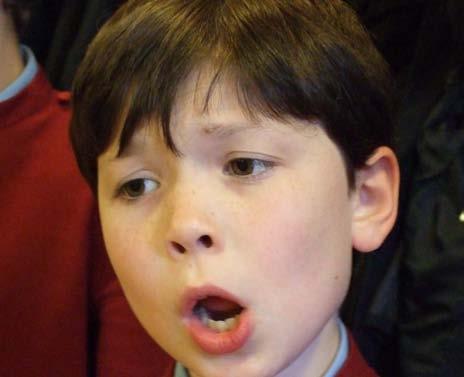
hardback · 920pp
Ref. No 52
Usual Price £11.50
25% Grant* £8.62
Words Only
978-0-90754-749-5 157 x 105mm
hardback · 616pp
Ref. No 50
Usual Price £9.50
25% Grant* £7.12
Large Print Words Only
978-1-85311-002-3 240 x 160mm
hardback · 544pp
Ref. No 56
Usual Price £17.50
25% Grant* £13.13
St Mary’s Works, St Mary’s Plain, Norwich NR3 3BH. E-mail: orders@scm-canterburypress.co.uk

*To qualify for a GRANT OF 25% an order for a minimum of 20 COPIES, in any combination, of New English Hymnal hymn books, together with a completed grant application form (available on request from SCM-Canterbury Press Ltd) must be received.CMNEH07
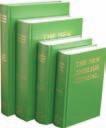
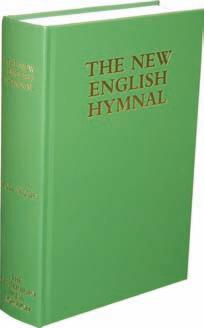

Cathedral Music 20
Oxford Voice trials for boys aged 7 to 9 years - Saturday 19 January 2008 substantial bursaries available registrar@cccs.org.uk www.cccs.org.uk (01865) 260650 3 Brewer Street, Oxford OX1 1QW 25%
To order/request a grant application form: Tel: 01603 612914 Fax: 01603 624483 SCM-Canterbury Press Ltd,
Christ Church Cathedral School
GrantAvailable*New English Hymnal
P3 140 CM Nov 07 A:3302 Cathedral Music MAY #B5827 31/10/07 13:43 Page 20
FRIENDS OF CATHEDRAL MUSIC HELP PORTSMOUTH CATHEDRAL WITH FINANCIAL SUPPORT FOR MUSIC CENTRE

On Saturday, 6 October, a cheque for £5,000 was presented to go towards a new music centre in Cathedral House. The presentation took place at the Old Choristers Reunion and a Gathering of FCM local members. The FCM grant will assist the £2m Portsmouth Cathedral Development Appeal. Within Cathedral House a room for workshops for visiting schools will be created and a music centre will be established to enable the Cathedral choir to rehearse. It will also provide facilities for ‘Cantate’, a new choir for teenage girls and boys. Roger Bishton, FCM Secretary said: “We are delighted to be associated with this marvellous project. The music at Portsmouth Cathedral is currently at a very exciting stage in its continued development. The provision of this new music centre together with the creation of a new young people’s choir will most certainly enhance the music and educational facilities available both for the Cathedral and also the wider community through parishes and schools.” With the new grant, FCM will have given a total of £18,000 to Portsmouth Cathedral over a 19 year period.
CATHEDRAL PILGRIMAGE
A North Yorkshire rector is taking his flock on a pilgrimage to thirteen English Cathedrals in only eight days in May 2008. Following a successful pilgrimage to Rome and Assisi last year, Fr Timothy Whitwell SSC has meticulously planned the forthcoming expedition so that at each of the cathedrals, the pilgrims will be able to able to hear the glories of English church music sung by the resident cathedral choirs. Also, it is hoped that the group – mainly from the Anglo-Catholic tradition within the Church of England – will be able to celebrate Mass every day of the pilgrimage. The unique spiritual and musical journey, starting on Monday, May 12th 2008, will begin on the Yorkshire coast at St. Leonard’s, Loftus-inCleveland, one of Fr Whitwell’s two Forward in Faith parishes nestling between the North York Moors and the steep slopes of the Cleveland coast. This eastern edge of England has been well used to Christian pilgrimage, sitting as it does betwixt Hartlepool and Whitby and the sister parish church of St. Helen’s itself clings perilously to the cliff edge at Carlin How.
After the first stop at Lichfield, the party will wend its way toward Hereford via Worcester, with Gloucester and Wells being the destinations for day three. Winchester and Salisbury are the stopping points before Canterbury on Sunday, 18 May. The return northward takes in Rochester, St Albans, Ely, Peterborough and then Southwell. The itinerary has been planned to hear the singing of Evensong by the cathedral choirs of Lichfield, Hereford, Wells, Salisbury (twice), Canterbury, St Albans and Peterborough. Early morning Masses have been arranged for each day of the pilgrimage, as are guided tours at all destination cathedrals. Father Whitwell would be very happy to hear from any members of the Friends of Cathedral Music interested in knowing more about the Pilgrimage and can be contacted on 01287 643702 or at timothy.whitwell@talk21.com
SCSA REUNION
Sir David Willcocks recently returned to Salisbury Cathedral, exactly 60 years after he first arrived to take up the post of Organist in 1947, to conduct a special Festal Evensong sung by the Cathedral choir and many former choristers – including 14 of his own former Salisbury choristers from the years 1947-50. The occasion was the Salisbury Cathedral School Association (SCSA) Reunion 2007. Sir David said: “It is exactly 60 years since I came to Salisbury in June/July 1947 to take over from Sir Walter Alcock who by then was in bed, looking very frail, but otherwise in fine form. My first service at Salisbury was his funeral. He was a very warm hearted person to know and greatly admired.”
David Halls, the current Director of Music at the cathedral, played the organ at this special service. “ It was a great honour for me to play for this special occasion. Sir David was on sparkling form and the choir sang superbly well for him.”
CHRIST CHURCH CATHEDRAL CHORISTERS PERFORM TO THE FRIENDS OF CATHEDRAL MUSIC
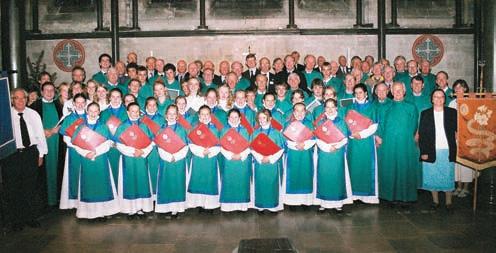
I have been vaguely aware of the existence of the body called ‘The Friends of Cathedral Music’ for some time – indeed I may have registered the name as far back as my chorister days at Winchester Cathedral. I was intrigued, therefore, to learn that the Friends were to visit Oxford and, further, that some of them would like the opportunity to look round the Cathedral School. At 11.00am on Saturday, 3 March 2007 some seventy of them arrived at the front door: what an interesting and varied group of people they were, all linked by their love of the music, of course, but also certainly living up to the soubriquet ‘Friends’. As is often the way when you get talking church music, there were links to be made both with my time at All Saints’, Margaret Street as a boy, with Winchester and with Durham Cathedral, where I was a Choral Scholar. After a brief history of our school we went on a quick tour, taking in No. 1 Brewer Street, once part of Wolsey’s empire and, the story goes, the site of meetings between him and his builders when his Cardinal College project was started; and of course the Sir William Walton Centre, a modern teaching block and Concert Hall named after one of our famous Old Boys. After lashings of coffee and biscuits, the company was ready for the morning’s musical entertainment, arranged in its honour by the Cathedral Choristers.
It was exciting to see these choristers not just singing, but playing a range of instruments to a high, as always, musical standard. The audience went away, I trust, with fine memories of the morning’s entertainment, and the boys thoroughly enjoyed playing to such an appreciative audience.
Martin Bruce, Headmaster
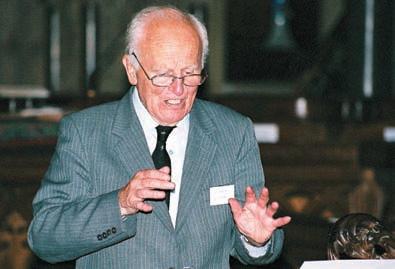
Cathedral Music 21
NEWSBITE P3 140 CM Nov 07 A:3302 Cathedral Music MAY #B5827 31/10/07 13:43 Page 21
News from Choirs and Places where they sing
In the (square) eyes of the world David Flood
Canterbury Cathedral is often fully in the gaze of a worldwide audience. The daily services welcome pilgrims and visitors from all corners of the world, even when they are least expected: in darkest November or February. Throughout 2006, however, even more eyes were fixed on us, this time via the television cameras of Peter Williams Television who made a series of eight factual programmes for ITV, simply called Cathedral . The programmes were screened on eight successive weekends beginning on December 17 2006. Even though the scheduled times were both erratic and at unpopular times (early morning and very late evening) they achieved a surprisingly large viewing audience and a considerable amount of enthusiasm and acclaim.
The brief, apparently, was to begin with three programmes centred around Christmas: the preparation, Christmas Day and then the following days including the commemoration of the murder of St Thomas of Canterbury. The Cathedral Choir featured very substantially in all the programmes but one, and throughout the Christmas season the lenses were never very far away and usually very close.
The presentation was always very sensitive, so even when the regular Christmas bug struck the choristers for a day or two and one or two hopefuls were not able to take part in the auditions for Once in Royal, the camera showed their plight and engendered lots of sympathy; no sense of sensation at all. We were able to show the pace at which we all have to prepare for these great occasions, together with the huge weight of the heritage and tradition which enables us to produce such wellengineered liturgy. The whole company of the Cathedral community, from flower-arrangers to the Archbishop and Mrs Williams, were featured reflecting on their role in the great Cathedral machine. The provocative question every time being: “What does Canterbury Cathedral mean to you?”
Choristers decorating the huge Choir House Christmas tree, opening presents, enjoying their ‘black tie’ Christmas dinner with the Organist carving (‘so well’) and constructing their infamous Santa-traps were always in view and they became quite at ease with the lens and the microphone. Therefore a truly happy, relaxed but hard-working team was well depicted both at work and at play.
The drama of St. Thomas’s day was striking and a rather good way to lead towards the following programme featuring Holy week and Easter. There was one programme in between, though, intriguingly entitled The Village. In order to show the wider spread of the Cathedral community, snippets of the lives of various Precincts residents were shown and the role of the Canon Pastor, merrily cycling to visit members of the congregation.
It would not have been good simply to show one service after another or to keep coming back to one particular section of the community, so the activities of Holy Week and Easter were shown in a very dramatic way. The view of a late-evening Maundy Thursday Cathedral, with the commentary “...and the Cathedral fell silent,” was especially effective after so much activity. As with so many of my colleagues, the rehearsal time available for so much music during Holy Week is very short and very precious. I shall long remember trying to conduct a fast, efficient rehearsal within one hour, when there were often seven television people, cameras, microphones, director etc., between me and the decani side of the choir. They themselves were always looking round lenses as well as watching the beat, trying to concentrate on the work in hand whilst a sea of people moved about amongst us. It is to their great credit that they survived extraordinarily well, producing high calibre performances despite distractions and developing a very professional disregard for the cameras.
Once again the most entertaining diversions came from the out-of-hours diversions of the choristers. Their Easter treasure hunt saw them running in various directions at high speed around the Precincts, whilst a few lamented the ‘stupid questions’ which their housemaster had developed for them, for example: “What make is the hand-dryer in the gents’ toilets?”! In collecting as many eggs as they could in the Easter morning egg hunt, a fabulous comic routine developed when small hands could no longer hold the quantity of eggs and the dropping treasure was chased around the floor, as even more fell out of grasp.
It was programme seven in the series of eight which was entitled The Sound of Music. Here the cameras followed us through the preparations for the re-development of the Choir House, the removal of the furniture, even the demolition of plasterboard walls, on to such great traditions as the annual cricket match in the grounds of St. Edmund’s School. Here they dwelt on the talent of the singers both young and old on the pitch, while the only action replay was for the Master of the Choristers scoring his run! The great thing was that the real fun and friendship of the occasion shone through brightly. The fitting outcome – a draw – was pure accident, honestly. The programme gave an opportunity too to follow a splendid group of aspirant choristers into the Voice Trial, to see them showing their best and giving to the television audience the true impression of the breadth of backgrounds from which they come. There was plenty of fun here too, along with some really outstanding singing and playing.
Canterbury Cathedral hosts many grand occasions in a year, and 2006 was not one for a Lambeth Conference (2008) or an Enthronement. So, to feature in the final programme the
Cathedral Music 22
P3 140 CM Nov 07 A:3302 Cathedral Music MAY #B5827 31/10/07 13:43 Page 22
producers chose a prominent funeral and a Cathedral wedding. The funeral of Sarah Jane Mulvihill, killed in action with the RAF in Iraq, was a highly moving occasion and the director managed to catch not just the sadness of the occasion but also the sense of celebration of her life. But the other ceremony featured centrally in this last programme was my daughter’s wedding. Here the whole musical establishment was featured both at work and at play. I was captured in all sorts of situations, writing and delivering speeches as well as leading my daughter all the way up the nave. The series ended with a real celebration and a wonderfully poignant closing sequence by the Dean.
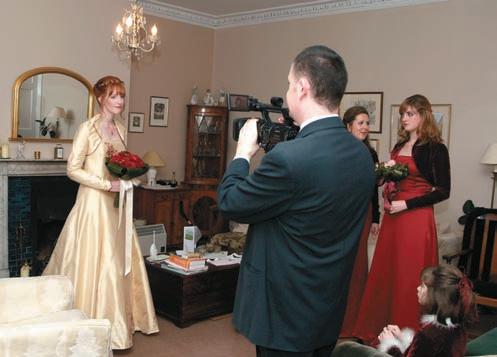
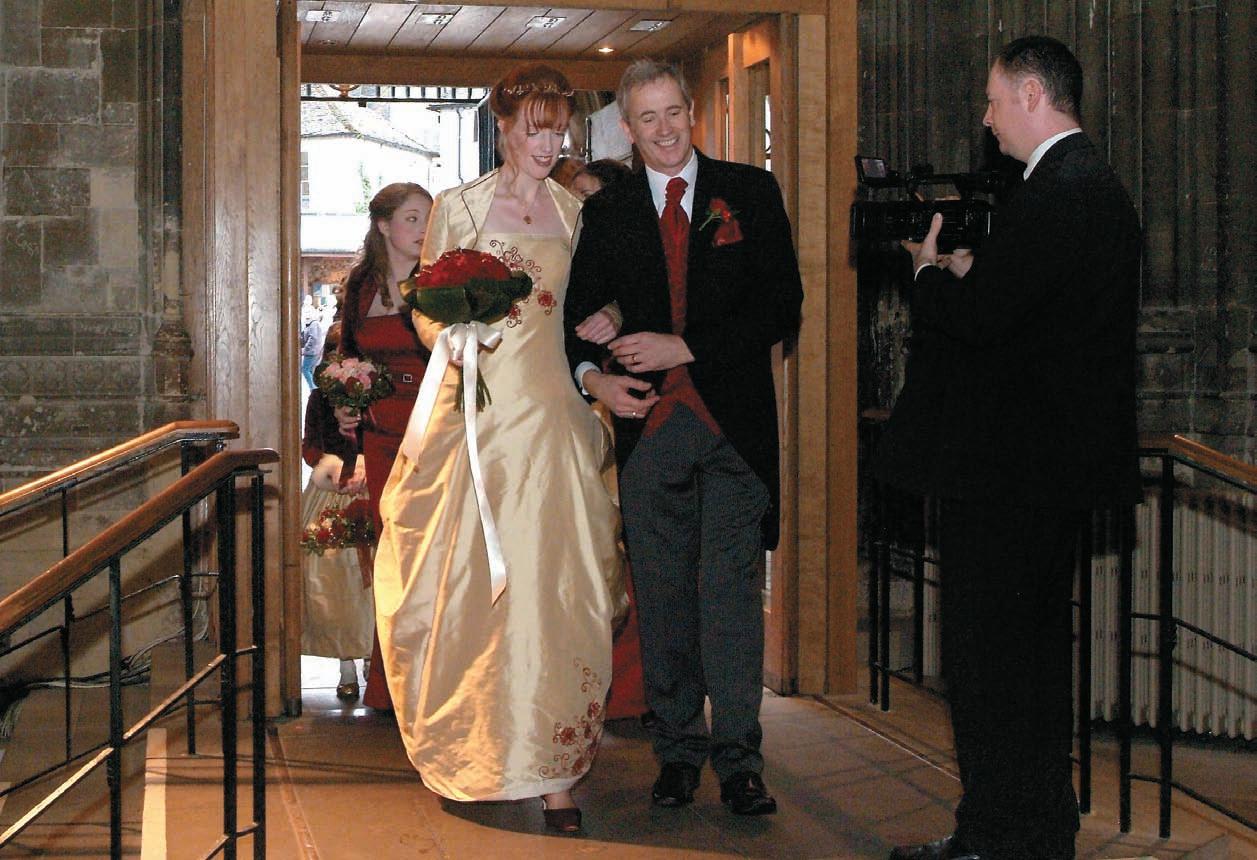
The broadcast of this series helped bring the continuum of the daily life of the Cathedral to the armchairs of the country and the response we have had has been tremendous. Not only has the huge impression that the Cathedral has on people’s lives been articulated, but also the joy that is inherent in all that we do. Our problems have been discussed, especially the recent launch of the £50 million Development Plan and the shots of decayed timbers and leadwork, and brought to the attention of a wide audience.
We became quite used to the pinning of a microphone where you least expect it and the lens appearing over our shoulder at every opportunity and I suppose we relaxed and became comfortable, knowing that the project was to show pride in a great national treasure rather than seek to sensationalise. This kind of sequence is a great help to our outreach and to the increase in awareness of our maintenance of the daily tradition. DVDs of the programmes now sell in our shop, so the process is by no means over!
Cathedral Music 23
The Christmas audition for the Once in Royal solo featured with popularity on YouTube [Ed].
P3 140 CM Nov 07 A:3302 Cathedral Music MAY #B5827 31/10/07 13:43 Page 23
‘Not only has the huge impression that the cathedral has on people’s lives been articulated, but also the joy that is inherent in all that we do.’
Alex Mason
60Seconds in Music Profile
New organist of St Davids Cathedral
Age: 32
Education details: Chorister and Organ Scholar, Gloucester Cathedral whilst a pupil at the Kings’ School, Gloucester (1981-92)
Organ Scholar, Worcester College Oxford (1992-95)
The Royal Conservatory, The Hague (1997-99)
The Royal College of Music (2000-01)
Career details to date: St Bride’s Fleet Street, Organ Scholar (1995-97)
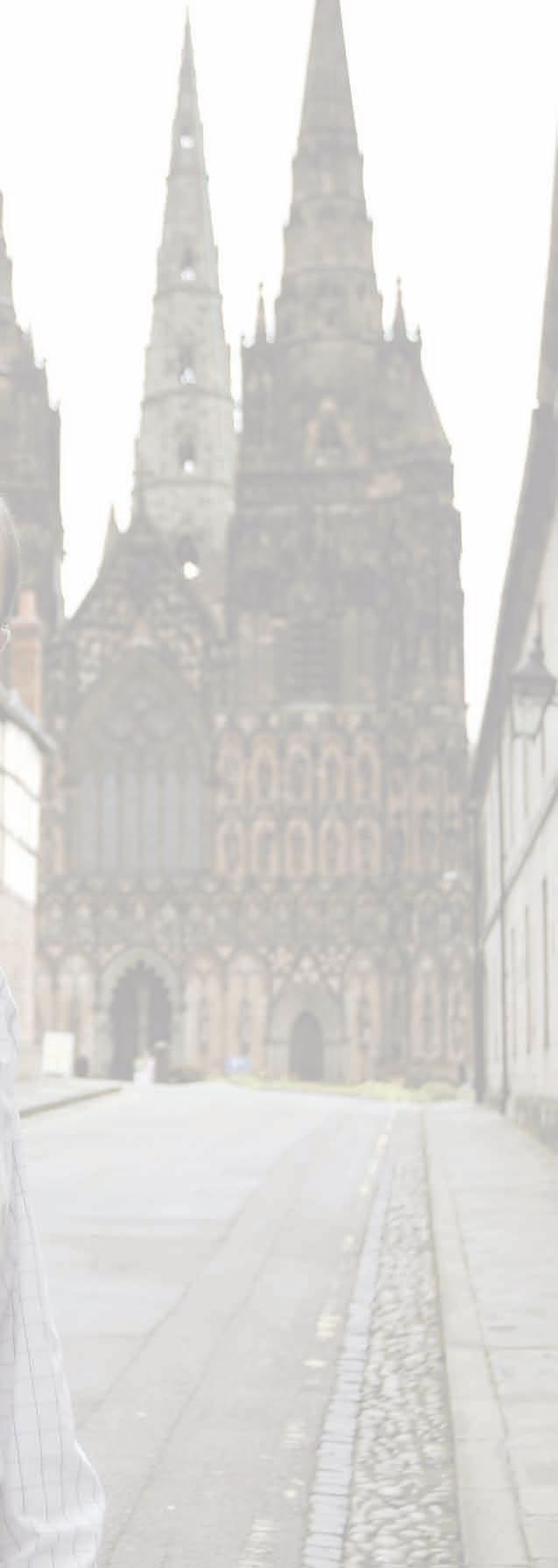
Organist, King’s College School, Wimbledon (1996-2002)
Guildford Cathedral, Acting Sub-Organist (1998)
HM Chapel Royal, Hampton Court Palace, Assistant Organist (1999-2000)
All Saints Church, Fulham, Director of Music (2001-02)
Lichfield Cathedral, Assistant Organist (2002-07)

What are you looking forward to most at St Davids?
The Festival, which takes place annually for a week, at the end of May will be a great opportunity for programming. There are some really interesting groups on the Festival circuit fusing jazz and world music as well as more traditional ensembles. I’m also looking forward to conducting the Festival Chorus in some of the larger-scale repertoire.
Cathedral Music 24
P3 140 CM Nov 07 A:3302 Cathedral Music MAY #B5827 31/10/07 13:44 Page 24
Photo: Tom Allwood
What organ pieces have you been inspired to take up recently and why?
I learned Reger’s Fantasia on Wie schon leuchtet for a Reger series at Guildford Cathedral. It’s a colourful and exciting work, so I’ve included it in quite a few programmes since. I’m also learning Miroirs by Ad Wammes. Wammes comes from the ‘pop’ music side of the track so I like the way he’s come to the organ with something fresh.
Have you been listening to recordings of them and if so is it just one interpretation or many and which players?
I heard Thomas Trotter playing the Wammes in Lichfield and this performance has really stuck in my memory. I like to learn a piece first and then, time permitting, compare several recordings. This is especially interesting with organ music as different instruments, registrations and buildings can influence an interpretation significantly.
Will you be introducing new repertoire at St Davids?
I’ll want to spend a bit of time discovering what the choir sings well first of all, but I’m keen to expand the repertoire in contemporary music.
What or whom made you take up the organ?
I think hearing the organ in Gloucester Cathedral during my chorister days left a pretty indelible impression. John Sanders, Mark Blatchly and Ian Fox were all tremendously encouraging at this time.
Which organists do you admire the most?
David Briggs – his transcriptions and improvisations are fantastic and I often listen to his recording of Dukas The Sorcerer’s Apprentice. David Sanger was a fantastic teacher in Oxford and his knowledge of the repertoire was staggering. I wish I could have heard Cochereau play live too!
What was the last CD you bought?
Brahms’ Requiem recorded by King’s Cambridge in the twopiano version in order to prepare for a performance I conducted in Lichfield.
What was the last CD recording you worked on?
Paul Spicer’s Easter Oratorio, which was Editor’s Choice in Gramophone
What is your;
a)favourite organ to play?
It depends on the repertoire really, but I did enjoy playing a recital at Hereford Cathedral shortly after the completion of the restoration.
b) favourite building?
Gloucester Cathedral.
c) favourite anthem
Bairstow Blessed City.
d) favourite set of canticles
Howells Gloucester Service.
e)favourite mass setting
Palestrina Missa Papae Marcelli.
f)favourite psalm and accompanying chants?
Psalm 136 – chant by C.H.Lloyd.
g)favourite organ piece
Duruflé Prelude, Adagio et Choral Varie sur le Veni Creator.
h) favourite composer J.S.Bach.
What pieces are you including in an organ recital you are performing?
I’m playing some Debussy piano preludes which lend themselves extremely well to the organ. Also a set of variations I composed on Torches for Joubert’s 80th birthday celebrations earlier this year.
Any forthcoming appearances of note?
I’m appearing with Ex Cathedra at Birmingham Town Hall in October and very much looking forward to playing there for the first time.
Have you played for an event or recital that stands out as a great moment?
I gave a recital at the City of London Festival in 2002 which was fun. Improvising after Choral Evensong from Lichfield ‘live’ on Radio 3 in 2003 stands out too!
Has any particular recording inspired you?
Cochereau’s Symphonie en Improvisation (1963) is a recording
I’ve known since I was seven or eight years old. It’s great music and unbelievable improvising. I also got hold of the 2-CD set of Barry Rose recordings from Guildford and there’s a track, lasting no more than two minutes, of Barry rehearsing some psalm verses with the choristers. Inspiring stuff!
How do you cope with nerves?
I’m generally pretty laid back.
What are your hobbies?
I play football every week and love to play tennis and I enjoy skiing when I can. I’m also a keen walker and have completed several long-distance paths such as the Cotswold Way and the South Downs Way. I enjoy reading, cinema, listening to jazz and pop music and travel in France for the food and wine.
Do you play any other instruments?
I played the clarinet at school…
What was the last book you read?
Milan Kundera The Unbearable Lightness of Being.
What are your favourite radio and television programmes? Have I got news for you, Dragon’s Den, Match of the Day.
What Newspapers and magazines do you read?
The Daily Telegraph and Classical Music.
What makes you laugh?
My daughter who is nearly two and Have I got news for you!
If you could have dinner with two people, one from the 21st century and the other from the past, who would you include?
John McEnroe and Herbert Howells.
What should be the role of the FCM in the 21st century?
To continue to uphold and promote cathedral music’s great legacy and to encourage wide access and participation to cathedral music outreach programmes.
Cathedral Music 25
P3 140 CM Nov 07 A:3302 Cathedral Music MAY #B5827 31/10/07 13:44 Page 25
Cathedrals places of delusion or truth?
Wells Cathedral is in the middle of a major development project which includes the clearing of the mediaeval cloisters, and the building of new interpretation space, a new restaurant and shop, and a new music and education building. This sermon was preached in July by the Cathedral Precentor, Canon Patrick Woodhouse, at the choir’s final evensong of the academic year 2006/7.

This evensong is a significant moment, for the choir as a whole, for the wider music family of the cathedral, and especially for those who are leaving. We are at the end of a rich and fruitful year. Broadcasts, CDs, gala concerts, great liturgical moments of the year celebrated in song. We have had them all. It is a time to give thanks, and to ponder for a moment the meaning of what we do and why it matters.
And this year we mark the end of the choir year at a crucial moment in the Cathedral’s life; for in the next twelve months this extraordinarily beautiful place is going to be transformed as we open up old spaces and build new ones and so extend and develop our capacity to welcome visitors and offer what
Cathedral Music 26
The Nave, Wells Cathedral
P3 140 CM Nov 07 A:3302 Cathedral Music MAY #B5827 31/10/07 13:44 Page 26
Photo: © Malcolm Warburton
this place has to give.
So as we embark on the final implementation of the development project, it is worth stepping back and reflecting for a moment on the building in which we make this music, seeking to see it with fresh eyes, pondering again why it was built, what it expresses, and the passion and belief which shaped it over 800 years ago.
It is an astonishing architectural miracle speaking with huge confidence of a faith that entirely dominated the mediaeval world. A faith that said that beyond this world in which human beings live out their short, struggling and suffering lives, there is another world to come, which for the mediaeval mind was intensely real… a world of rest and a reckoning, of consolation and condemnation, but a world of final forgiveness and freedom from the heavy weight of mortality. Above all a world of worship and praise in the presence of God himself surrounded by the angels and archangels and the whole company of heaven.
As the mediaeval builders fashioned and shaped this place, this was their total world-view – what they hoped for, looked towards, and both trusted in and feared.

Well things could hardly have changed more. As we in the 21st century seek to reveal and extend their work with modest additions of our own time, we are daily aware that the worldview that they inhabited so confidently has almost entirely collapsed. Only faint echoes of it now remain, certainly in northern Europe. And though we might feel this is lamentable – for secularism is an acid that dissolves not just belief but also
hope – it is also a liberation. Mediaeval Christendom for all the beauty of its creations would have been an intolerably suffocating and oppressive world.
So we build in radically different times, and the visitor of the 21st century, even more than his counterpart of the 20th century, will enter this place with their mind, their outlook and their world-view deeply shaped by a radical and allpervasive scepticism. Embedded more and more in the common assumptions of our time and coming across day after day in newspapers, on the radio, on television, is the message that the very notion of a living God is faintly absurd. To the mass mind of our times, it is increasingly seen as no more than a cultural memory, a product – so it is asserted again and again – of essentially primitive and even delusionary thinking from which science is gradually liberating us.
Our imaginary visitor will almost certainly have heard of and may well have read the wisdom of Richard Dawkins (his recent book, The God Delusion, has been a bestseller for weeks), or they may have picked up a copy of the recent book by the journalist and literary critic Christopher Hitchens entitled God is not Great – how religion poisons everything, or possibly he will be a reader of The Times and have heard the same kind of thing from the columnist Matthew Parris… and so the message goes on being transmitted day by day, week by week, – religion is essentially delusionary thinking for the weak and insecure, harmless enough in its liberal Anglican clothes but in its true fundamentalist colours, deeply dangerous.
So our imaginary visitor may well assume that this glorious
Cathedral Music 27
P3 140 CM Nov 07 A:3302 Cathedral Music MAY #B5827 31/10/07 13:44 Page 27
building created in the heyday of Christendom speaks of another age, not the present. He will be visiting a wonderful piece of our heritage, an intricately fashioned and beautifully created architectural miracle of the Middle Ages, built to celebrate… a delusion.
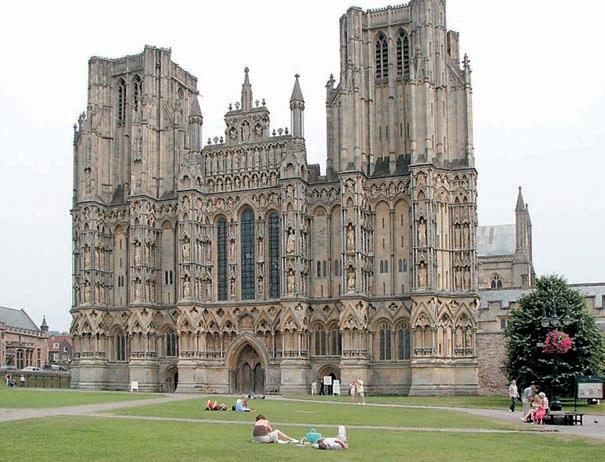
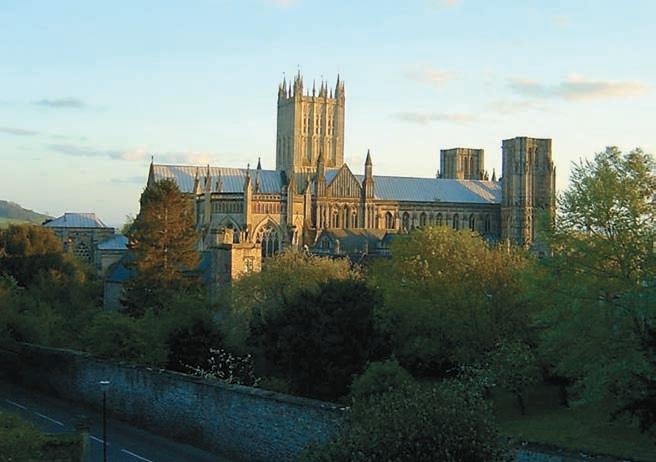
And yet as he or she walks slowly around the place they may well find that this way of thinking is somehow not quite satisfactory – does not quite fit what is before their eyes. As they gaze up at the lines of the pillars, the form of the stone, the symmetry of the dimensions, the artistry of the carvings, and the sheer feel of the space, they may begin to feel that this building somehow has a voice of its own… a voice that conveys a message of comfort… of consolation… of wonder… of beauty. And a message that gently invites some kind of response.
And if our visitor is a reflective person he or she may wonder about and be puzzled by this beauty, perhaps they might even allow themselves the question – what is it? Beauty? Why am I moved by it? And… where does it come from?
But that will probably be no more than a fleeting thought unless perhaps they stay beyond the time when many visitors leave, and hearing the sound of singing coming from the heart of the place, make their way towards evensong. Perhaps they might even accept the invitation from a verger to stay, and so going through the arch under the organ they would enter into the heart of the place.
What might such a person think as they stood uneasily in the ancient wooden stalls of the Quire? What would they see? What would they hear? A choir of young men and young
people, focussed, disciplined and integrated, making the most astonishingly beautiful music. And interwoven with the music – growing out of it and leading into it – they would hear words spoken – introductions and readings punctuated by silences. And as they listened they would I hope detect that there is some kind of story being told here. And then towards the end of the service and growing out of the music of the anthem, they would hear prayers. And through the whole experience of simply being there, I hope they might gain some kind of hard-to-define sense of what might be called connectedness, a sense even of being deeply embraced… and the feeling conveyed through it all that their life, and the life of this whole place is somehow part of something much, much greater.
For this imaginary visitor – making their way out into the evening light and resuming again their accustomed place in the world – there would, please God, have been a disturbance; and arising in their mind perhaps a questioning of everything they have assumed… and maybe… just maybe… the rekindling, the flickering again of a hope that they would have been led to assume, was hopeless.
In a world that is often dark and difficult and full of threat and foreboding, this Cathedral is, in many people’s hearts, daily a place of struggle between hope and emptiness. If you do not believe me just read the prayer cards that stack up week by week in the transept, or watch the candles at the stands being lit hour by hour. It may be an emptiness caused by any number of personal griefs or losses but beyond them a more universal grief lingers, a greater loss is being inarticulately mourned –the loss of meaning itself
We are here to confound that, for that is the true delusion.
To do it we deploy many languages; the language of architecture, of movement, of words, of signs, but, above all, the language of music. Day by day in the extraordinarily rich vocabulary of this language a triumphant assertion is made that underneath all things, and however much it sometimes seems impossible to believe… there is love; that whoever you are and whatever you may have done or not done, whether you are stranger or friend, believer or sceptic – you belong to this Love; you are known and you matter, and you are invited home to your own deepest heart and to the Mystery of the God who dwells there.
And so the message goes out again and again in a language far deeper than mere words alone that hope is not hopeless and life is infinitely more rich than the shrill purveyors of delusion know. And you musicians, you choristers, you men of the choir, are at the heart of this struggle, for in the language in which you are so skilled, day by day you make the fullest, richest confession of faith that this building is capable of.
Cathedral Music 28
Patrick Woodhouse
P3 140 CM Nov 07 A:3302 Cathedral Music MAY #B5827 31/10/07 13:44 Page 28
‘Embedded more and more in the common assumptions of our time and coming across day after day in newspapers, on the radio, on television, is the message that the very notion of a living God is faintly absurd.’
SALISBURY CATHEDRAL CHOIR’s popular annual open day. ‘Be a Chorister for a Day’ was held on Saturday 10 November. David Halls, the cathedral’s Director of Music, said: “The children have a great time with the current choristers, rehearsing and then singing with them in the cathedral during Evensong. They hear about the choristers’ daily routine, radio & TV broadcasts, concerts, recordings and tours and have the opportunity to ask all the questions they’ve ever wanted answered about life as a chorister. They will also hear about all the extra-curricular activities the choristers fit into their busy schedules. ‘Be a Chorister for a Day’ is partly about breaking down some of the mystique and myth surrounding the life of the chorister. My choristers are ordinary children from ordinary homes, who happen to be musically talented.”
 DAVID
DAVID
PRICE ORGANIST, PORTSMOUTH ANGLICAN CATHEDRAL

David Price received an Honorary Doctorate of Music in recognition of the significant contribution he has made to the development of music at Portsmouth Cathedral and for his contribution to the cultural life of the city. It also marked with pleasure his long association with Portsmouth University graduation ceremonies, providing music that has been much appreciated by thousands of students and their families.
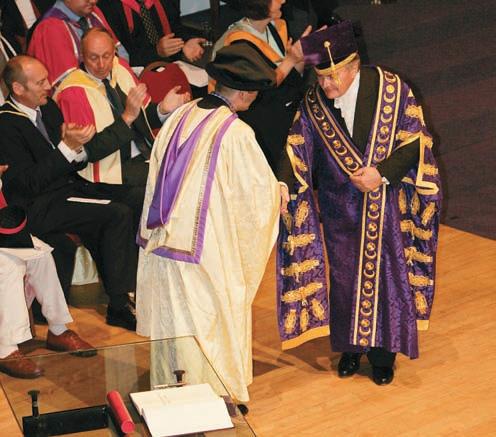
Cathedral Music 29
from
and Places where they sing NEWSBITE P3 140 CM Nov 07 A:3302 Cathedral Music MAY #B5827 31/10/07 13:44 Page 29
News
Choirs
The Versatility of the Victorian Musician
Henry Thomas Pringuer (18521930) will be a name unknown to most of you. In the great scheme of things, his life was unremarkable. He is, however, one of the many people who have, over the years, contributed in thier own way, much to the musical lives of many. His activities were diverse and varied, and countless generations of musicians and churchgoers will have benefited from his skills, particularly in the four parishes in which he served as organist and choirmaster. I have a particular interest in Dr Pringuer as his third wife was a distant cousin of my grandfather.
Henry Thomas Pringuer was born on 23 February, 1852, in Canterbury, Kent. He was the only son of Samuel Freemoult Pringuer, a carpenter and cabinet maker, and Eliza Hayward. At the age of 14 he was appointed as organist of St Dunstan’s, Canterbury, where he served for three years. He was a chorister under Dr Longhurst at Canterbury Cathedral, and it was from this time, that a love of the organ ensued.
In 1871, he was appointed to St Matthew’s, Redhill, Surrey, where he remained until 1880. During that time, he founded the Redhill Harmonic Society, and was director of the Insurance Musical Society. He was also choirmaster at St John the Evangelist in the same town. On leaving the latter, he was presented with a case of silver spoons, and a large plaque which reads: ‘Though we cannot but express our regret at having to lose your valuable services, we feel somewhat consoled by the fact that the circumstances attending such loss, are occasioned by your removal to a locality where a wider field is available for the exercise of your undoubted musical talents and ability, than is afforded in this neighbourhood.’ He married Julia Griffin at St George’s, Hanover Square on 4 September, 1872. They had a daughter, Beatrice, who was almost certainly born before the marriage, and who disappeared, along
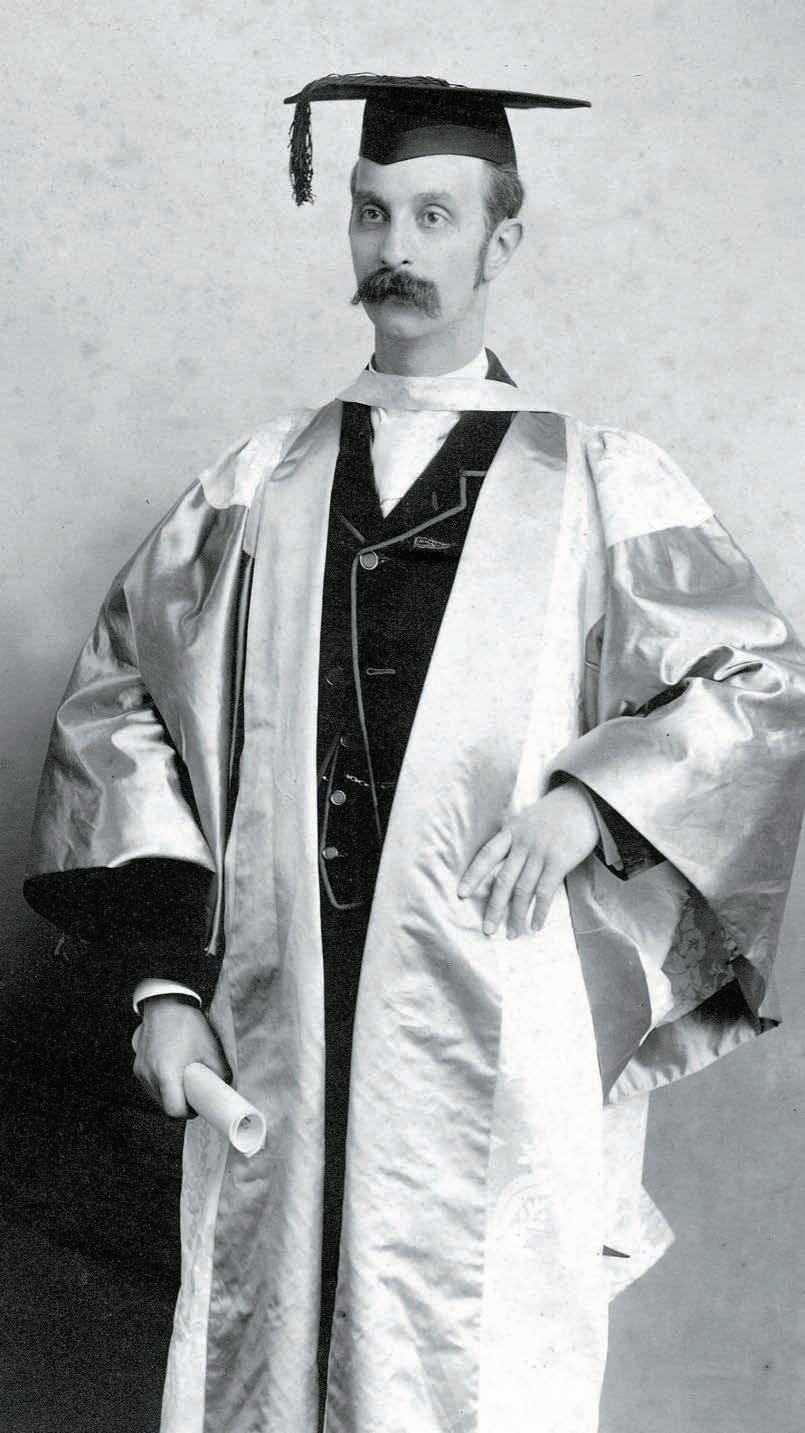
Cathedral Music 30
P3 140 CM Nov 07 A:3302 Cathedral Music MAY #B5827 31/10/07 13:44 Page 30
Written by DAVID BARTON
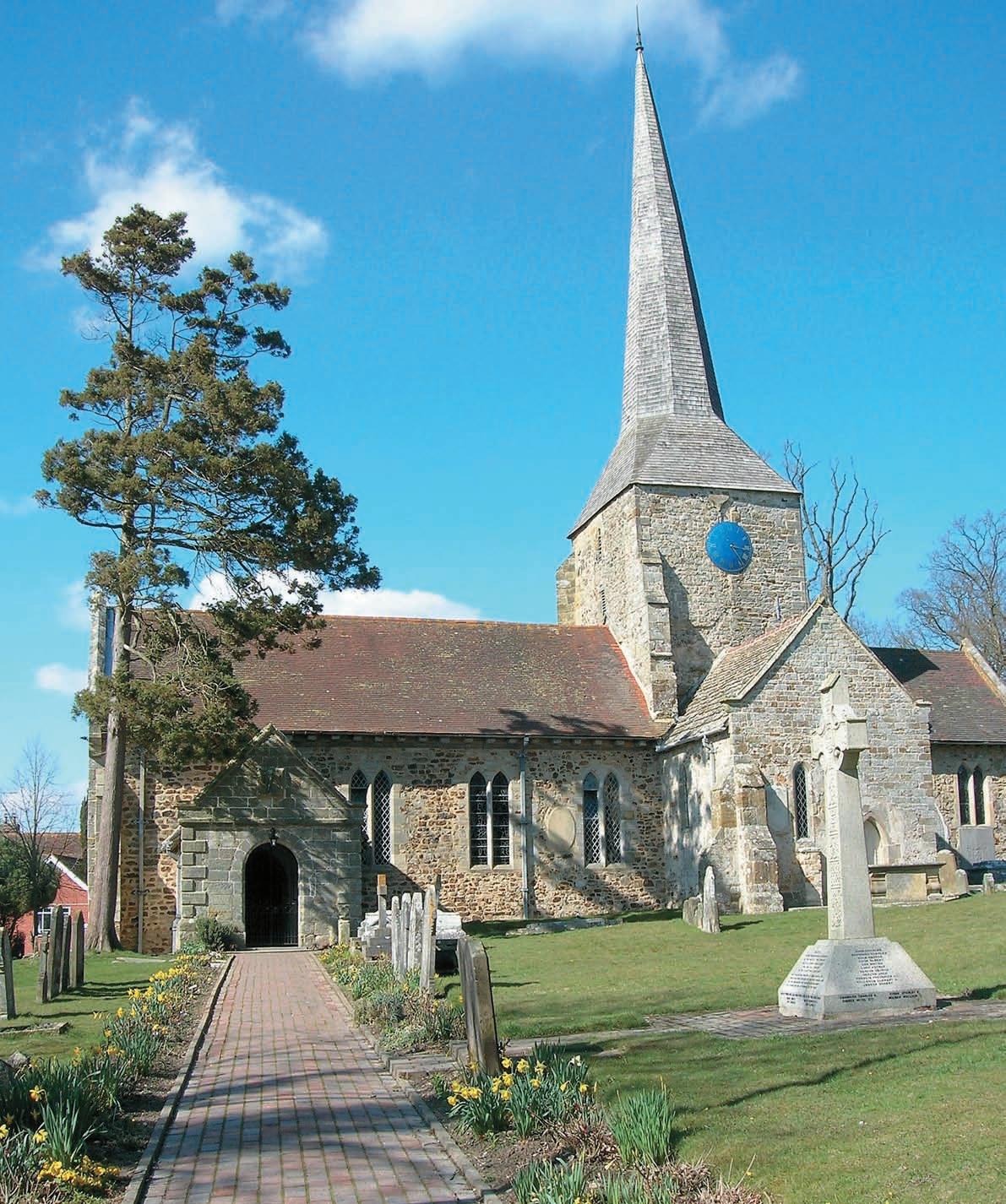
Cathedral Music 31
P3 140 CM Nov 07 A:3302 Cathedral Music MAY #B5827 31/10/07 13:44 Page 31
Parish Church, Horsted Keynes
with her mother, after 1881. I believe that Beatrice later emigrated to America.
In addition to Dr Pringuer’s skills as an organist, choirmaster, examiner, accompanist and teacher, he was also a composer. In 1875, he scored three pieces for piano: Holiday Time, Evening on the Lake and Queen Bess’s Solemn Dance, the latter of which was rescored for orchestra as A Recollection of Old London in 1876. Around the same time, he also wrote a song The Message of the Wind with lyrics by Lillie Davies, which was sung by Arthur Thompson.
During his time in Redhill, Dr Pringuer made regular trips to London and Oxford. He gained the FRCO on 30 January, 1877. He was examined in organ playing, harmony, counterpoint, and general knowledge of music, where the examiners included C. Warwick Jordan. On 25 October in the same year, Dr Pringuer gained the degree of Bachelor of Music, from New College, Oxford. The examiners were Sir. Frederick Arthur Gore-Ouseley Bart, Charles William Corfe (organist of New College) and Leighton George Hayne (organist of the Queen’s College). Candidates were examined in four and five-part harmony, the history of music, and the form and structure of pieces by ‘distinguished’ composers, as selected by the examiners. Dr Pringuer submitted a setting of Psalm 107 scored for flute, clarinet, violin, cello, double bass and SATTB for the composition element of the examination.
Later in 1880, Dr Pringuer was appointed to St Mary’s, Stoke Newington, in North London. He was to remain here for 40 years. During his time at St Mary’s, the church choir became renowned throughout London, ranking as one of the ‘best in the diocese’. In 1883, he sat on the committee which sought to provide a lasting memorial to Sir John Goss in St Paul’s Cathedral. As Dr Pringuer’s organ teacher, Goss also allowed him to deputise on occasions at the Cathedral.
On 12 November, 1885, Dr Pringuer was awarded the degree of Doctor of Music, again from New College, Oxford. The examiners were CHH Parry (Exeter College) and J F Bridge (Queen’s College). A substantial setting of Psalm 48 was submitted as part of the examination, scored for full orchestra and eight vocal parts. It was performed at the Sheldonian Theatre on 16 October, 1885. Around this time, Dr Pringuer wrote a set of two-stave organ pieces which were published in the Minster Voluntaries Book 3. These included A Call to Praise, Allegretto Grazioso, Triumphal March, Intermezzo, Festal Postlude, Canon, Communion, Barcarolle, At the Close of Evensong, and Andante Quasi Pastorale. As you may have read in a previous issue, he also wrote a number of psalm chants, as well as collating a vast collection of the same.
In 1889, Dr Pringuer composed a comic opera Guinevere (or alternatively titled Love Laughs at Law) with a libretto by Stanley Stevens. It was performed at Kilburn Town Hall on 19 March; produced and directed by Mr Henry Baker, and conducted by the composer. A review published in The Era stated: ‘Guinevere may be pronounced a complete success…’ A similar review in The Stage encompassed similar comments. The opera was never published commercially, and I believe that despite the reviews, has remained unperformed since.
Dr Pringuer led a colourful and varied life in more ways than one, as seemingly still married to Julia, he married again, to Agnes Sarah Carter on 26 November, 1892 at St Andrew’s, Stoke Newington.
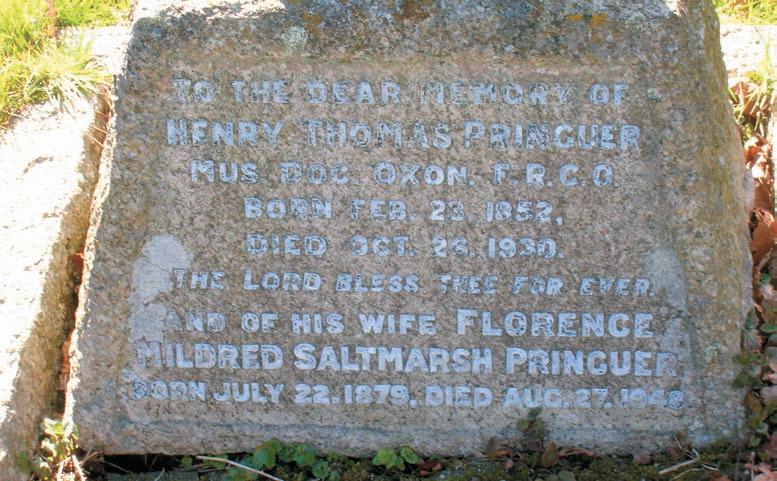
Between 1894, and 1921, Dr Pringuer was an examiner for the newly formed Trinity College, London. He was listed as an examiner for General Subjects, and Theory, as well as being on the ‘Board of Corporation’. During that time, he was also director of the chapel choir, being much praised by The Musical Times for his enthusiasm and commitment. He

Cathedral Music 32
‘Perhaps the most colourful episode in the life of Dr. Pringuer was in fact his death...’
P3 140 CM Nov 07 A:3302 Cathedral Music MAY #B5827 31/10/07 13:44 Page 32
Pringuer’s grave
directed a varied programme over the years, including Dvorak’s Stabat Mater, Schubert’s The Song of Miriam, Gaul’s The Silent Land and Hursltone’s ballad for chorus and orchestra Alfred the Great. ‘The singing was spirited and excellent in tone and executed efficiently’ stated The Musical Times in July 1911. Dr Pringuer was also a recitalist, giving concerts at many venues including St Michael’s, Cornhill; Canterbury Cathedral; St Peter-upon-Cornhill; and St Stephen’s, Walbrook. He was also a member of the Board of Studies at the University of London.
Always ready to encourage, Dr Pringuer added his testimony to the ability of Master Willie Child, a Blaxland’s Solo Boy in an advertisement in The Musical Times where he stated: ‘I have had many opportunities of judging Master Willie Child’s capabilities as a solo vocalist, both in sacred and secular music, and he is undoubtedly, a perfect little artist.’ The boy had previously been in the choir at St Mary’s, before seemingly attaining higher positions.
In 1906, Dr Pringuer penned the plans for a new organ at St Mary’s, Stoke Newington which was to be built by Hill and Son in the same year; a four-manual, with over 40 stops. The instrument was further enlarged in 1935 with modern electric action. It generated much interest and was seen as the ‘Rolls Royce’ of its kind. Unfortunately, during the war the organ was destroyed, the present organ being installed when the church re-opened in 1957, with nothing being saved from the previous instrument. In 1909, a carol-anthem was written: In the Virgin’s Arms. With both words and music by Dr Pringuer, it was published by the Vincent Music Company, and advertised in The Musical Times as ‘the great success of last season’. In 1910, Novello and Company published Dr Pringuer’s Te Deum and Benedictus; a festival setting in the key of A flat. I have a manuscript copy which has been re-scored with the addition of trumpets and timpani. A number of other pieces, including the anthems O Lord Our God (Spire Dedication Anthem) and Still, still with thee were unpublished. During the early 1900s, Dr Pringuer lived at Stamford Hill, where sadly, his second wife Agnes died from cirrhosis of the liver on 18 November, 1913, age 56.
Pringuer’s third and final marriage was to Florence Mildred Saltmarsh Challen, and took place at Canterbury Cathedral on 3 September, 1914. Daughter of George Trimmell Challen, and Julia Pontifex, Mildred was 27 years Dr Pringuer’s junior, and had been active in the life of the church at St Mary’s. Dr Pringuer retired from the church due to ill health in 1920, after 40 years in the poSt This was seen as somewhat a momentous achievement, not least because in that time, he had served under four different rectors. Giving him time to recuperate after what must have been a exhausting life, Dr Pringuer and his wife Mildred lived in Sidmouth, Devon for a year, before he took up his final appointment, to the Church of All Saints, Lindfield, in West Sussex, in May 1921, where he was to remain until his death. The couple lived at Priory Cottage in the High Street, and were well known in the village. They enjoyed walking, particularly in the nearby countryside around Horsted Keynes, where Mildred was able to indulge her love of painting.
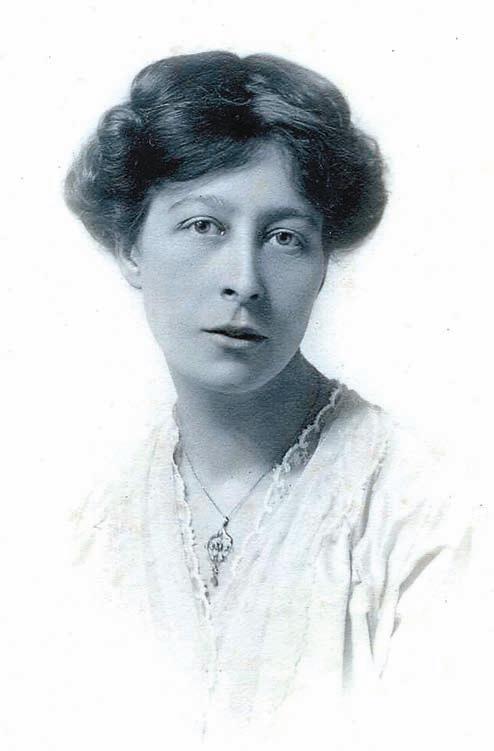
Perhaps the most colourful episode in the life of Dr Pringuer was in fact his death, the circumstances of which are surely the stuff fairytales are made of. On Sunday 26 October, 1930, having just been congratulated by the vicar, Revd Sidney Swann, on his excellent rendering of the hymn When morning gilds the skies at the morning service, Dr Pringuer collapsed in the vestry and died shortly after. Newspaper reports stated
‘…everything possible was done for restoration, and a medical man, Dr C W Dood, was speedily summoned, but he could only pronounce life to be extinct…’, the cause of death being heart disease. As his obituaries state ‘…there was some consolation in the fact that Dr Pringuer had passed away as he would have wished, in his cassock, and in preparation to go to the organ he had played and loved so well.’ His death ‘cast a gloom’ over the whole village until after the funeral. An impressive choral service was held at All Saints, and Dr Pringuer was buried at Horsted Keynes, just a few miles away, where an impressive gravestone still stands.
After Dr Pringuer’s death, his wife Mildred moved to live with her sister Dora, first at The Old Cottage, and then Moat Cottage at East Hendred in Oxfordshire, where she died, age 69, in August 1948. She was subsequently buried with her husband, at Horsted Keynes. Before she died, enough money was raised to erect a permanent memorial to Dr Pringuer at his home church, St Dunstan’s in Canterbury. The memorial plaque, in Hopton-Wood stone, and blue glass mosaic, reads; ‘Remember Henry Thomas Pringuer Mus Doc Oxon. FRCO 23 Feb 1852 – 26 Oct 1930. Organist and Master of the Choir in this Church at the age of 14, afterwards at St Matthew’s Church, Redhill, and for 40 years at St Mary’s Parish Church, Stoke Newington. His great gifts were devoted to the service of GOD in his Church “unto death”. M.S.P. 3 Sep 1934.’
Dr Pringuer is surely one of many such musicians who enabled the English choral tradition to flourish in the late 19th and early 20th century. He was blessed with many skills and talents, all of which he used for the benefit of others. His abilities as a teacher, recitalist, organist, composer, accompanist, examiner, conductor, and choirmaster, are long forgotten, but the plaque at St Dunstan’s lays testimony to his undoubted ability and popularity in these fields.
Cathedral Music 33
P3 140 CM Nov 07 A:3302 Cathedral Music MAY #B5827 31/10/07 13:44 Page 33
Pringuer’s third wife Mildred
GRAHAM WHETTAM
7 SEPTEMBER 1927 - 17 AUGUST 2007
Composer Graham Whettam, recently described by Musicweb as ‘one of Britain’s elder statesmen of music’, died peacefully in his sleep early on the morning of Friday 17 August at his West Gloucestershire home which overlooks the River Severn.
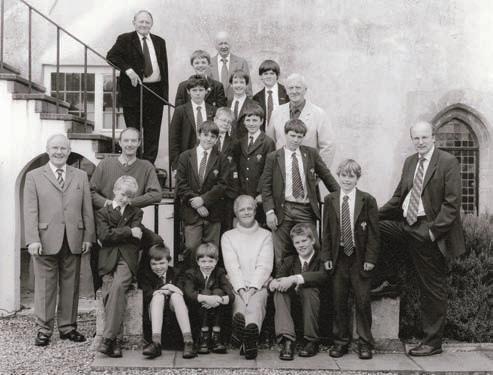
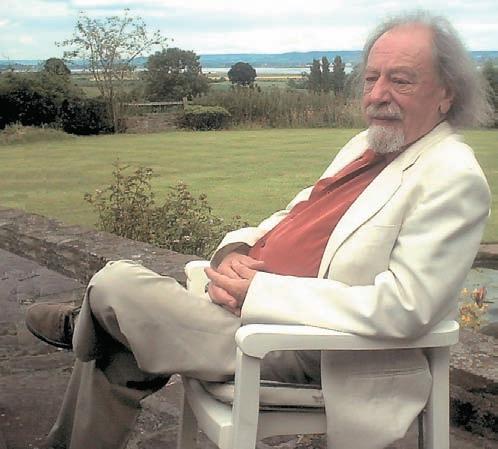
Whettam was to celebrate his 80th birthday on 7 September, and had most recently received commendation due to the highly acclaimed recordings of his piano music by Anthony Goldstone and Caroline Clemmow, which were released last year on the Divine Art label. His final week was marked by another CD release, the Carducci String Quartet unveiling their recordings of his string and oboe quartets at their performance of his String Quartet No. 1 in the Three Choirs Festival in Gloucester, Whettam’s last public appearance. This release is on the Carducci Classics label.
Five days earlier, the combined choirs of Hereford, Worcester and Gloucester Cathedrals had given a thrilling performance of Whettam’s Magnificat & Nunc Dimittis (Coventry Service) during Festival Evensong in Gloucester Cathedral.
Graham Whettam leaves behind a considerable musical legacy which Meriden Music will, of course, continue to promote.
NEW ORGAN SCHOLAR AT SALISBURY CATHEDRAL
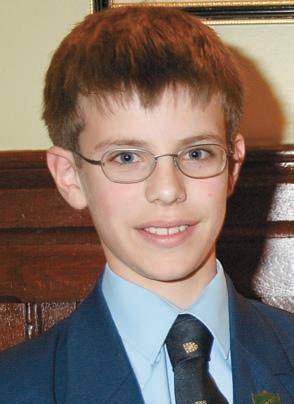
Simon Hogan (18) from Bristol has been appointed Organ Scholar at Salisbury Cathedral for the forthcoming academic year. Simon was Organ Scholar at Bristol Cathedral from 2006-07 and Organ Student at St Mary, Redcliffe, for the past three years. He passed his ARCO (organ) during the summer and will apply to study organ and piano at one of the music conservatoires following his gap year in Salisbury. Simon was delighted to be offered the organ scholarship in Salisbury and is ready to take up the challenges the year presents. “I’ve been to Salisbury on many occasions on choir tours and have always been awestruck by its beauty. I’m greatly looking forward to being part of the team and spending a year in this lovely city and playing its Willis organ.”

PETER BROWN, the well-known photographer from Amesbury who has taken the cathedral choir’s formal photos since 1976, enjoyed himself at Salisbury Cathedral recently when the men of the choir in 1976 joined Richard Seal, Organist & Master of the Choristers in 1976, and today’s boy choristers to re-enact that first photograph taken on the stairs at the back of the Cathedral School. Peter said: “I have always enjoyed taking photos of the cathedral choir; we have visited some interesting locations over the years including Old Sarum and the Cathedral Tower itself and filmed in all weathers from beautiful sunny days to heavy rain and even snow! I am proud to say that, to this day, we have never yet cancelled the pre-arranged photographic shoot. It was wonderful to see the men from 1976 with Richard Seal and today’s Director of Music, David Halls. I am extremely grateful to them all for coming down – to be there and do it was good fun.”
GUILDFORD CHORISTER
Ben Cunningham has now completed his time in the cathedral choir. The next FCM chorister will be Alistair Baumann. Alistair joined as a probationer in September 2006 and was installed as a full chorister on 9 September at the cathedral Eucharist. Alistair is eight years old and continuing the family tradition. His brother Peter was the Head Boy Chorister and his sister the Head Girl Chorister last year. Alistair’s parents are Paul and Diana who are both keen singers.
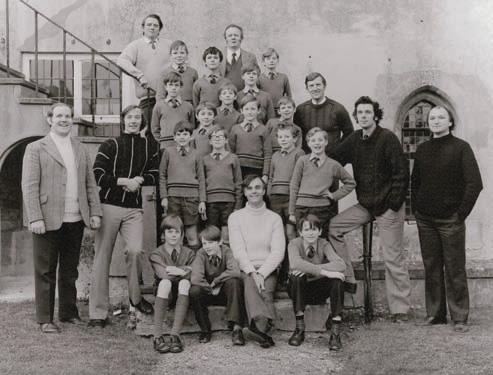
Cathedral Music 34
P3 140 CM Nov 07 A:3302 Cathedral Music MAY #B5827 31/10/07 13:44 Page 34
NEWSBITE News from Choirs and Places where they sing
The Portsmouth Gentlemen and their watering holes
David Hampshire, Lay Clerk
What do a group of teachers, a driving instructor, a financial advisor, a university lecturer, a government scientist and a bunch of students all have in common? The answer is that they all form the lay clerks and choral scholars of Portsmouth Cathedral Choir. This eclectic group meet to sing Evensong on Mondays, Tuesdays, Thursdays and Fridays together with the usual round of Sunday services. In addition, Saturdays can bring with them a flurry of special services or concerts.
The gentlemen show a fine range of experience. A number have been in the choir for over 20 years but the sound is kept fresh by a regular influx of young singers spending a Gap year between school and university.
Singing is a social and thirsty activity and it is important that the gentlemen are able to replenish their fluids on a regular basis. Fortunately, the Cathedral is well served by a selection of hostelries all within a stone’s throw
LAY CLERKS’ TALE
of the choir stalls. The Cathedral is in the ancient area of Old Portsmouth and the sea is in constant view, only a few metres away hence the self-styled title, The Cathedral of the Sea. Nelson and other naval heroes have walked down the High Street past the Cathedral and many of the pubs would have been used by press gangs in centuries gone by.
The Dolphin is a regular haunt of the choir and is to be found directly opposite the Cathedral. From Song School to bar should only take two minutes. The Dolphin is a traditional pub and apparently was the first pub in Portsmouth to be associated with a brewery as far back as 1634. One of its treasures is a pane of glass which has Nelson’s signature scratched into it. It has a long bar, a flagged floor and is decorated with portraits of Nelson and ships. The real log fires give a warm atmosphere. The pub has recently been redecorated and now has a lighter feel to it. It serves a fine selection of local
ales which are well kept in the cellar. A major plus for the gentlemen is that it has large tables which can accommodate us all. It also has a restaurant area which serves local lobster and other sea food.
An alternative, particularly in the summer months, is the American bar which is situated at the edge of the Camber docks (again two minutes from the Song School). It is claimed that the name arises because in the 18th century the building was used to house convicts waiting to be deported to penal colonies in Virginia. The first pub on the site is listed as the Shipwright Arms in 1784, but during the Second World War it was one of the most badly damaged public houses in Portsmouth. It now serves a selection of ales and wines and has a fine restaurant as well as a delightful garden.
There are many more pubs, all within a few minutes walk. The gentlemen of Portsmouth Cathedral should never go thirsty!
Where do lay clerks hang out in your part of the country? If your local hostelry is worth a mention drop the Editor a line along with a photo of the lay clerks partaking of a pint.

Cathedral Music 35
P3 140 CM Nov 07 A:3302 Cathedral Music MAY #B5827 31/10/07 13:44 Page 35
Three Notable Cathedral Organists Timothy Storey
What is this Cathedral Music, of which we are all Friends, really about? These anniversary portraits of three cathedral organists of successive generations may be of interest in revealing something of how each has followed his vocation.
Sydney Nicholson
Sydney Nicholson died just over 60 years ago, on 30 May, 1947, and this year the RSCM has been celebrating the 80th anniversary of that meeting, 6 December, 1927 when, having just resigned as Organist of Westminster Abbey, he launched the movement which we now know as the Royal School of Church Music. His previous record as a cathedral organist and choirmaster is somewhat overshadowed by that great work for which he resigned his prestigious post as the Abbey’s organist, but he brought many of the ideals and standards of cathedral music to the School of English Church Music (as it then was), enlisted the aid of great cathedral musicians such as Ernest Bullock and Edward Bairstow, and returned to active participation in cathedral-style music during the Second World War. For a fuller account of his life, the reader should obtain Vocation and Endeavour: Sir Sydney Nicholson and the early years of the Royal School of Church Music by Watkins Shaw, published by the Church Music Society.
Nicholson’s family, initially opposed to his taking up a career in music, sent him to be interviewed by Sir Walter Parratt, who advised that he take an arts degree at Oxford before concentrating on music. His ‘third’ in English suggests that he spent more time listening to the various college choirs than on his studies: the choir of Magdalen College was the most highly trained, that of New College was a little more natural and spontaneous, and the most interesting repertoire was to be found at Christ Church even if by implication the standard of performance left something to be desired. He left Oxford in 1897 for three years’ serious study under Parratt and Stanford at the Royal College of Music and became organist of Chipping Barnet Parish Church, some 12 miles to the north of London.
In 1904, at Parratt’s suggestion, he was called to Carlisle Cathedral to be Acting Organist, aged just 29. It must be remembered that in the Church, as in other walks of life including the relatively young railway industry, there was then no fixed retiring age and the incumbent could enjoy his house and salary until death. The aged Dr Ford had become too infirm to carry out his duties, but remained in name Organist of Carlisle Cathedral even though Nicholson carried out the full duties of the post. There was a somewhat
Cathedral Music 36
P3 140 CM Nov 07 B:3302 Cathedral Music MAY #B5827 31/10/07 14:05 Page 36
‘It must be remembered that in the Church, as in other walks of life including the relatively young railway industry, there was then no fixed retiring age and the incumbent could enjoy his house and salary until death.’
and Choirmasters Anniversaries of
Sydney Nicholson, Francis Jackson
& Alan Thurlow
rudimentary choir school (which was closed in 1935) but little other attention was paid to the boys’ welfare; Nicholson established an immediate rapport with his charges, organising outings to nearby places of interest and starting a choir club for the older boys, and he established a separate choir of boys and ex-choristers to sing at the ‘popular’ Sunday evening services. To rebuild the cathedral’s Father Willis organ he called in the relatively unknown Arthur Harrison, the beginning of a friendship which lasted until Harrison’s death in 1937.
In 1908 he accepted the post of organist of Canterbury Cathedral, but immediately withdrew on receiving an invitation to Manchester Cathedral. One can only wonder at the reasons behind such an apparently unlikely preference. His work at Manchester included the formation of on Old Boys’ Association and a scout troop; his reputation was such that he was invited to succeed Sir Frederick Bridge at Westminster Abbey from January 1919. There he had the choir (and school) enlarged to contain two separate groups of 24 boys to take it in turns to sing the services and thus lessen the load, and he tried to tackle the conditions of the men’s employment by which they had the security of a freehold, had no obligation to attend rehearsals, could claim the right to

sing solos and could send a deputy whenever they pleased. He had some success, but the Abbey freeholds were still a matter of contention 50 years later in the era of Douglas Guest and Simon Preston.
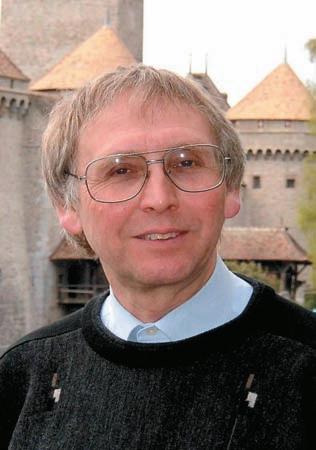

Of his day-to-day choir training we have little impression, except for the obvious inference that he enjoyed a high enough reputation to have been invited to move first to Manchester and then Westminster. He was by his own admission not much of an organist, nor (to quote Watkins Shaw) ‘did his choir training show signs of fine technical honing, whatever its other merits’. He seemed much more at home with larger and less expert forces, having founded largescale choir festivals in all his previous places of work and established a Special Choir of 100 boys and 100 men at the Abbey. There must have been quite a contrast with his successor, the efficient but fearsome Ernest Bullock, but he left the Abbey on good terms with his Dean, who chaired that fateful meeting on 6 December and gave him much fruitful advice.
There was, however, a sense in which Nicholson took cathedral standards to a wider public, for at that time even the humblest church choir was part of a continuum which embraced all standards from village to cathedral; there was
Cathedral Music 37
s
Sir Sydney Nicholson © RSCM
Francis Jackson
Photo: Graham Hermon
Alan Thurlow
P3 140 CM Nov 07 B:3302 Cathedral Music MAY #B5827 31/10/07 14:05 Page 37
Photo: Tina Thurlow
MUSIC at LEEDS PARISH CHURCH
A very warm welcome awaits you! [for service times see the Website, call 0113 267 7571 or email lpc@simonlindley.org.uk]
not today’s divide between informal worship in the parishes and highly skilled, formal liturgy in the cathedrals. To Nicholson, cathedral music was all about doing things to the highest possible standard, which was not necessarily the same as tackling the most difficult music, and any church could enjoy this standard if its musicians were willing to benefit from competent instruction. The small residential choir school which he established at Chislehurst in Kent was intended to provide his students with training in all kinds of church music; students, the most famous of whom were Gerald Knight and Sir David Willcocks, had the chance to direct both ‘parish’ and ‘cathedral’ music. Recent reissues in the ‘Better Land’ series of historic recording show how well his boys sang, and it is possible to detect Nicholson’s influence in how Willcocks trained his wonderful choir at King’s College, Cambridge, not least in the famous ‘King’s pronunciation’. If the master himself had gone, Arthur Wills could still benefit from this tradition as a student at the RSCM in the late 1940s.
Boy Choristers, Choral Scholars and Lay Clerks at all services and events except 23 March & 7 May


SUNDAY 2 DECEMBER – 6.30pm
Traditional Advent Carol Service
*WEDNESDAY 12 DECEMBER – 7.00pm
Carols for a Choral Future
Gala Christmas Concert in aid of the Choral Foundation Appeal
Leeds Parish Church Combined Choirs
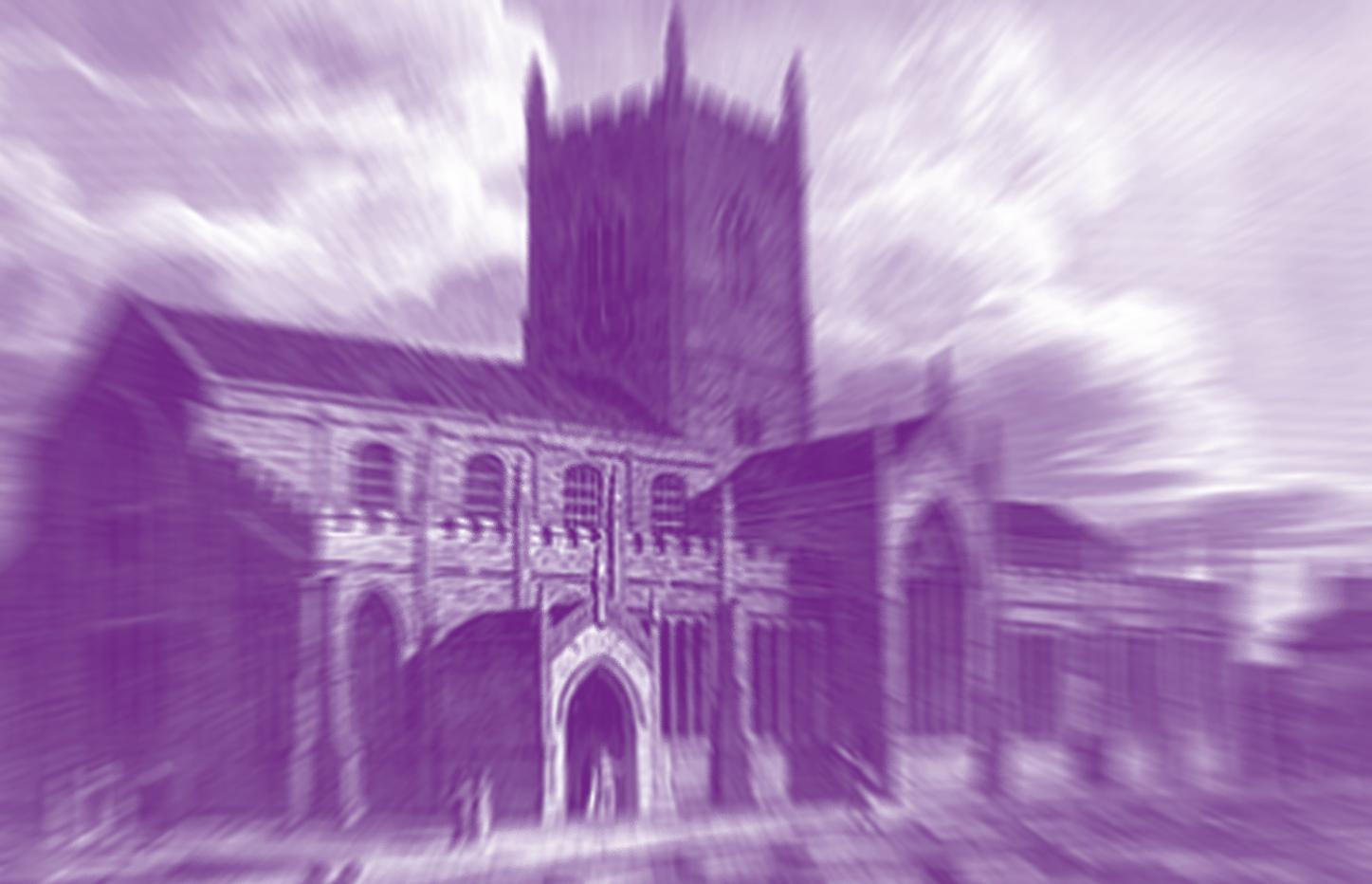
Yorkshire Imperial Band David Houlder: Organ
SUNDAY 23 DECEMBER – 3.00pm
Festival of Nine Lessons & Carols
SUNDAY 13 JANUARY – 6.30pm
Traditional Epiphany Carol Service
MONDAY 17 MARCH – 1.05pm at Leeds Town Hall
Stainer – The Crucifixion The Choir of Leeds Parish Church
*GOOD FRIDAY 21 MARCH – 7.00pm
Bach – Mass in B minor
St Peter’s Singers, Chamber Orchestra & Soloists
WEDNESDAY 7 MAY – 7.30pm
Battle of the Organs
*SUNDAY 15 JUNE – 3.00pm at Leeds Town Hall – admission by free ticket Sacred Choral Classics in aid of the Choral Foundation Appeal
Leeds Parish Church Combined Choirs Orchestra of Opera North
*Booking from 0113 224 3801
Free admission on all other occasions
www.leedsparishchurch.org.uk
Nicholson enjoyed a late return to his roots from 1940 to 1943, when he took charge of the music at St Michael’s College, Tenbury during the organist’s absence on war service. He ably maintained the standard of the music while continuing and even expanding the SECM’s choir festivals, and he also (a characteristic touch) managed to found a ‘village choir’ of ten boys to join the college choir on Sundays and take its place during vacations. It was at about this time also that the first ‘Cathedral Course’ was held, when in 1942 fifty boys and young men from cathedrals, parish churches, public schools and even ‘some of the smallest country villages’ combined to take over the services in Gloucester Cathedral. Similar arrangements followed at Durham and Norwich Cathedrals in 1944 and 1945. This was Nicholson’s philosophy in a nutshell: the standards of cathedral music could be applied to all sorts and conditions of worship, and even parish choirboys could aspire to take an active part in it. We would not wish nowadays to exclude girls and ladies from the scope of his ideal, and the popularity of ‘visiting choirs’ suggests that a large number of good amateur singers enjoy the experience of leading cathedral worship; he might be worried at the apparent decline of the ordinary parish choir which he was so keen to encourage in taking its part, however small, in the great tradition he fought so hard to encourage and maintain.
Francis Jackson
Francis Jackson will have reached his 90th birthday by the time this appears in print; but though we have heard much about his legendary skills as composer and organist, little has been said in CATHEDRAL MUSIC or anywhere else about his dayto-day work as Organist of York Minster from 1946 to 1982. It was a period of gradually accelerating change, not much of it to Dr Jackson’s liking, and there were serious problems affecting the running of the choir; John Roden’s recentlypublished history of the choir school, presumably still available from the Minster shop, tells the whole sorry tale, sparing none of the unsavoury details. Dr Jackson’s own biography of Sir Edward Bairstow, Blessed City, is also required reading, and no true Friend of Cathedral Music should be without a copy.
Francis became a chorister at York on 4 February, 1929 at the age of eleven and a half, and after this rather late start was admitted to the full choir after a period of only three weeks as a probationer, surely the shortest on record. He stayed on after his voice broke, with his articles as a pupil of Bairstow paid for by the
Cathedral Music 38
P3 140 CM Nov 07 B:3302 Cathedral Music MAY #B5827 31/10/07 14:06 Page 38
Friends of the Minster, and by the outbreak of war had collected his FRCO and his Durham BMus. He had taken his share in playing for the Minster services, so when he and Owen Franklin, the Sub-Organist, were called up to the armed forces, Bairstow was left to cope on his own, though some assistance was given by Miss Hilda Milvain, a lady of great character who amazingly had acted in a similar capacity at Rochester Cathedral in the previous conflict. Serving with the IXth Lancers in Italy, Trooper Jackson taught himself to play the saxophone (much to Bairstow’s disgust) and was billed as ‘Jive with Jackson’ or ‘Francis Jackson plays Boogie and Bach – Nightly’.
A serious situation arose at the Minster at the end of 1945. Sir Edward Bairstow had become ill on Christmas Eve with what was to be his final illness, and the Sub-Organist had accepted a post at Doncaster Parish Church. Miss Milvain was left to cope on her own, but on 15 March, 1946 Dean MilnerWhite wrote to Francis Jackson, still awaiting demobilisation, to offer him the newly-vacant post; he expressed the hope that

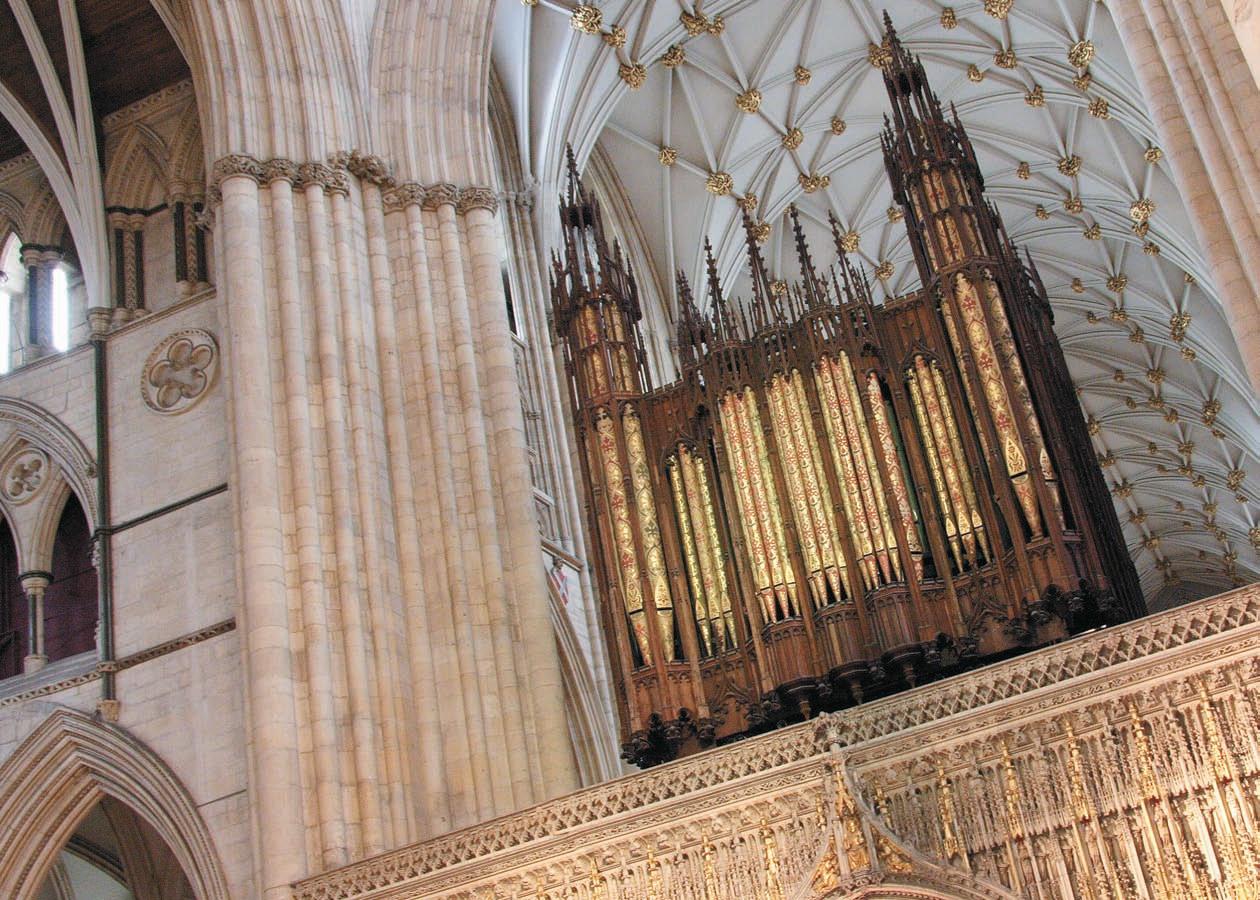
Bairstow would recover but hinted at the more realistic expectation that the Sub-Organist would have to do the job himself. He took up his duties on Easter Monday and Bairstow died ten days later: Francis was officially appointed Organist on 8 October, but it was not until the following year that Allan Wicks was appointed Sub-Organist and he at last had someone with whom to share the work. The Dean had a considerable knowledge of church music; at his weekly meeting with SubChanter and Organist the music list for the following week was agreed, with a continual widening of the repertoire. A few Latin anthems were allowed, though service settings had to be in English, and Milner-White urged his new organist to compose, the famous Benedicite in G following a scheme which the Dean suggested. Francis had to fight to keep some of the old York favourites in use, such settings as Smart in B flat being a little crude for the decanal taste; Milner-White thought him ‘a nice young man’ who might be expected to do as he was told, but he soon showed a healthy independence.
The choir was in surprisingly good shape. The full programme of daily services was still being maintained, with no choral services on Wednesdays but Mattins and Evensong sung on all the other days of the week with the exception of Mattins on Mondays. There was also a Solemn Eucharist on Sundays and Feast Days. Throughout the war someone had always appeared at the right moment to fill a vacancy among the Songmen. Francis found the boys rather less responsive
Cathedral Music 39
York Minster Organ
Photo: Graham Hermon
Francis Jackson
P3 140 CM Nov 07 B:3302 Cathedral Music MAY #B5827 31/10/07 14:06 Page 39
Photo: Graham Hermon
than he had expected, and in his own words ‘asked too much of them, so that there were one or two disasters at first’. His relations with the men were excellent, even though several were old enough to be his father (grandfather, even), and the Dean congratulated him on his applying ‘just the right sort of discipline’. Preparing the music for two services each day was something the choir took in its stride, and when sung Mattins on Thursdays and Saturdays was discontinued to provide more time for the Songmen to earn a living, the choir seemed to be left with too much rehearsal time. Sung Mattins on weekdays, twice and eventually once a week and latterly sung by the boys alone, lingered until 1967 when the great programme of saving the Minster from collapse made the building too noisy on weekday mornings.
Evensong was at 4.00 pm throughout Dr Jackson’s tenure of office and it became very hard to find men free to sing in midafternoon, let alone anyone with time to spare for midmorning Mattins. Even before the war, Bairstow had complained that his best singers went off to Durham, where they were paid more, and perhaps because he himself was a wealthy man, Dean Milner-White did not think it necessary to pay anyone very much in the post-war years. The award of a pension of £1 a week to a songman retiring in 1950 was greeted with an understandable lack of enthusiasm! There were, nonetheless, some fine singers in the choir from time to time – the names of Andrew Carter and Gordon Pullin come to mind – but the introduction of choral scholars after the University of York was established in 1964 helped matters a great deal, though there were always some quite elderly gentlemen in the choir whose mature tones add a characteristic timbre to York’s recordings.
The choir made several recordings in the late 1940s for the Columbia church music series, and these come up very well on their recent transfer to CD. Rather disappointingly, MilnerWhite opposed the making of any more throughout the rest of his time, though the choir was at its best in the 1950s and 1960s, but on those same CDs we can now hear some unofficial recordings of live performances from these years; if
the ensemble is sometimes lacking in polish and precision, we can enjoy the natural and free quality of the boys’ singing, with an obvious care for the clarity of every single syllable that must ultimately be derived from Bairstow’s practice of ‘singing learned from speech’. There was a succession of excellent choristers, notably Beverley Jones who was recorded privately and appears on two CDs in the Better Land series.
At first Francis had to work with his old headmaster, for whom he felt considerable affection and respect: he also enjoyed the best of relations with his choristers, but it is a paradox that after 1952, in the very years when their singing was so good, they had to endure at school a new regime so harsh and eccentric and so inimical to what he was trying to achieve in the Minster that in March 1966 five senior songmen made a formal complaint to Milner-White’s successor about the headmaster’s treatment of the boys. The Dean and Chapter were in any case already concerned about the situation and its effect on the health and welfare of Francis and his family; a new headmaster was appointed remarkably quickly, with whom his dealings were fortunately much more agreeable. Sadly, in some respects the damage could not be undone, and a certain decline in relationships was evident under Ronald Jasper, the last dean he was to serve and one with whom he found it hard to work. It is to his eternal credit that throughout these difficult years Dr Jackson ‘did out the duty’ (to use a phrase beloved of Bishop Hensley Henson) to the best of his ability, though the loss of the Minster’s traditional Sunday pattern of sung Mattins followed by a great Solemn Eucharist was something he deeply regretted.
Sir Edward Bairstow had told the young Jackson that his mission was to be a ‘musical GP’ or ‘jack of all trades’ and he faithfully tried to carry out his allotted task, making music in the wider community by conducting the York Symphony Orchestra and the York Musical Society, the oldest choral society in the country, with whom Bairstow had notoriously fallen out in 1939. He says that even if he had not been appointed to the Minster he would have wished to be a cathedral organist somewhere, but he surely was completely at home carrying on his old master’s traditions at York, which included his amazing psalm-accompaniments. The writer will long treasure his depiction of a violent thunderstorm in Psalm 77, but also some moments of rare beauty in the singing which he directed with such gentleness and sensitivity.
Alan Thurlow
Alan Thurlow was 60 last May, and will retire from Chichester Cathedral next Easter. He is well known to FCM as a distinguished former Chairman, and his award of a Lambeth doctorate two years ago was in part a recognition of this and many other public services to the Cathedral Organists’ Conference, the RSCM and a variety of other local and national bodies; but the official citation in fact states that the award is ‘in recognition of his significant contribution to church music, particularly as Organist and Master of the Choristers at Chichester Cathedral’, and quite rightly so. What are the special qualities of his work there, and how has he kept the choir at such an enviably high standard for nearly three decades?
Alan owes much, both musically and spiritually, to the Anglo-Catholic traditions of St Barnabas Church in Woodford, a South-West Essex suburb of London, where he was a chorister (with a rather good voice) and subsequently organist. He and the writer attended Bancroft’s School, also
Cathedral Music 40
P3 140 CM Nov 07 B:3302 Cathedral Music MAY #B5827 31/10/07 14:06 Page 40
‘Even before the war Bairstow had complained that his best singers went off to Durham, where they were paid more, and perhaps because he himself was a wealthy man, Dean Milner-White did not think it necessary to pay anyone very much in the post-war years.’
in Woodford, where there was then no formal music tuition but whose old boys, nonetheless, include a Professor of Music (Raymond Warren), two cathedral organists (Roger Fisher and Alan Thurlow), the composer Colin Matthews and the baritone Brian Rayner Cook. There was an outstanding ‘Combined Choir’ which included girls from a local grammar school; there we encountered Byrd, Palestrina, Rubbra and Co. at an impressionable age, and there we and many others met our future wives. Alan’s application for a joint French and Music course at Sheffield University saw him rejected by the French department but welcomed by the musicians. He was Organ Scholar at the Cathedral, gained his RCO diplomas and graduated from the University with a ‘First’ in music, going on to Cambridge to carry out research into the music of John Sheppard.
His researches were well advanced when he was appointed to Durham Cathedral in 1973 to assist the legendary and formidable Conrad Eden, by then not far off retirement, for whom he gained considerable respect and affection. The choir in Dr Eden’s own words ‘had a library, not a repertoire’, so a vast corpus of music in all styles and of all periods was sung, and performances could be either brilliant or terrible,

but never merely average. It nonetheless was a surprise for Alan to find S S Wesley’s monumental O Lord, thou art my God scheduled for a Tuesday afternoon during one of Eden’s rare absences; but there again, he had rapidly learnt that nothing was totally improbable. Extra rehearsals were organized and a good performance ensued, but members of Chapter who had not expected to sit through a 20 minute anthem on a weekday were less than amused. It transpired that the anthem should have been O Lord my God (Solomon’s Prayer), duration two minutes rather than twenty, which had somehow gained an extra thou art on the music list.
Conrad Eden was followed by the genial and highly sociable Richard Lloyd, with whom Alan also enjoyed the happiest of relations; his appointment as Organist of Chichester Cathedral in the autumn of 1980 was a well-deserved promotion, for he had run the music at Durham with conspicuous success during the Summer Term between Eden’s retirement and the arrival of his successor. The contrast with Durham could not have been greater. Choir and cathedral were about half the size of what he had been used to, and though the choir’s standard was superlatively high, the repertoire had by deliberate decision been kept small to ensure that no chances were taken in performance. At first Alan found it hard to put together from what the choir knew even one month’s scheme of music he wished to perform, and the boys suddenly had to learn rather a quantity of new material. At Durham Richard Lloyd had maintained his predecessor’s policy of a wide repertoire (or large library), and there seemed no reason why Chichester should be different; thus Alan was determined that he would teach the boys to become good sight-readers, following many of the same methods as Conrad Eden who made much use of the tonic sol-fa.
Chichester’s musical standards and reputation may have been high, but there were problems to be tackled. Salaries were poor: John Birch had filled vacancies among the lay vicars by persuading former choral scholars from the old universities to spend a couple of years at Chichester before moving on to greater (or better-paid) things, and this rapid turnover of personnel may have been one reason for the small repertoire, though that in itself may have hastened the departure of many a good singer. Alan began at Chichester short of an alto and an Assistant Organist, though fortunately there was a very good Organ Scholar to fill the breach, and there were subsequent occasions where a vacancy could not be filled immediately and the choir was short of one of its six adult voices for a term or longer. Part of his vision was for a stable community of men who would make a long-term commitment to the choir and thus be familiar with the much larger range of music he wished to have performed, and in time and largely through his efforts salaries were considerably enhanced and all the men were found accommodation in cathedral property. This policy has been successful, and there is usually a strong field of candidates for such vacancies as occur, though disasters can still happen; quite recently one gentleman who shall remain nameless lasted for one service only before deciding that his future lay elsewhere, thus causing a vacancy which could not be filled immediately.
As most readers will know, Chichester’s quire is uniquely small and the stalls have room for only 12 boys in all. Up to six probationers are usually in training, so to bring these on and give them a chance to sing in the full choir small platforms were added at the east end of the stalls so that a
Cathedral Music 41
P3 140 CM Nov 07 B:3302 Cathedral Music MAY #B5827 31/10/07 14:06 Page 41
Archbishop of Canterbury, DR Rowan Williams with Alan Thurlow Photo: © Lambeth Palace
probationer on each side could join in as well, clinging somewhat precariously to the end of the woodwork. Scholarships were created for all the boys, with extra funds available so that noone need be excluded from the choir for lack of money, and though numbers are never plentiful at auditions it is usually possible to fill vacancies. It can be hard work for those who are left if a large number of senior boys leave at once, and throughout at least one year there were only 10 full choristers.
As the Chichester website puts it, the choir is ‘noted for the beautiful soft tone it produces in the cathedral’s sympathetic acoustic’. John Birch’s choir sang remarkably quietly most of the time, with a very rounded and ‘covered’ tone from the boys, though the power could be turned up quite dramatically on occasion. The sound nowadays is not dissimilar, though the tone is a little more free and the dynamic range greater. There is an insistence on the singers’ awareness of the sound they and others are making, and though around three hundred different anthems are performed each year (plus a goodly quantity of service settings) much of the music is relatively easy and there is time to attend to the basics of good singing. Alan would agree with Sir Sydney Nicholson that cathedral music is about high standards of performance rather than the tackling of difficult works, and it was a pleasure to see (in another journal) a Chichester Head Chorister’s assessment of his choirmaster, to the effect that he worked the choir hard but never made unreasonable demands. The singing of the Psalms (the Prayer Book’s complete allocation for each day, of course) is exceptionally fine. The daily round is hardly ever interrupted, despite the considerable extra demands of the Christmas concerts at the Festival Theatre, the various events
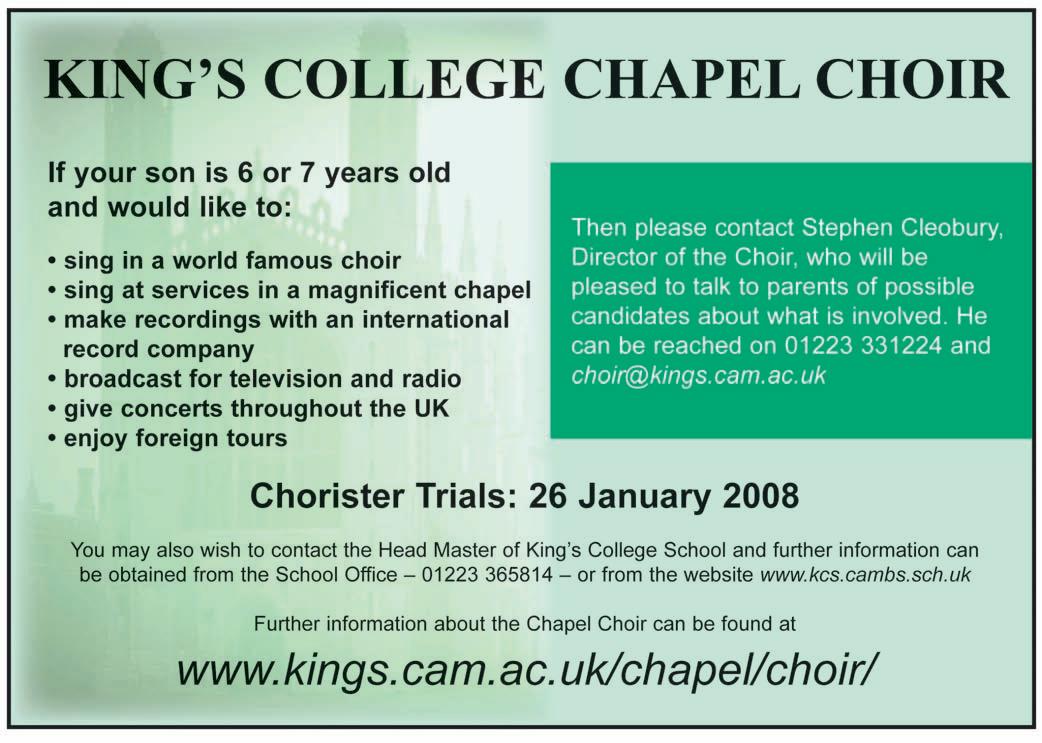
in the Chichester Festivities and of course the Southern Cathedrals Festival which is held in turn at Chichester, Salisbury and Winchester.
Most of us will know the choir from its broadcasts and recordings, even if Chichester is too far away for more than the occasional visit. TheHyperion recording of Geoffrey Burgon’s music won a 1985 Critics’ Choice of the Year Award in The Gramophone, and the choir has made one of the best recordings in the Priory series of Magnificat and Nunc Dimittis, with particularly thrilling performances of E W Naylor in A and Smart in G, the latter a real ‘Chichester special’ which Conrad Eden had mischievously re-introduced to Durham so that the students of the ‘high-church’ St Chad’s College had more than ample time for their devotions during its unusually long Gloria Patri. Also in the Priory catalogue are Chichester Commissions which includes the 1968 Howells’s Chichester Service together with works by Berkeley, Burgon, Jonathan Harvey and Richard Lloyd; Great Cathedral Anthems VII keeps well clear of the beaten track and includes the very same S S Wesley anthem which got Alan into hot water at Durham thirty-odd years ago. Chichester’s small body of singers turns in a compelling performance, with the glorious finale underpinned by the thirty-two foot reed of the cathedral organ whose rebuilding Alan oversaw, making good use of the practical skills he had acquired at Woodford in his teens in patching up an ailing instrument and eventually planning its reconstruction. If the rebuilt organ will be his most tangible legacy to Chichester, it is only a part of the vision he has realised of the choir’s music as an integral part of the cathedral’s worship and its musicians as a part of a community fittingly devoted to God’s glory.
Cathedral Music 42
P3 140 CM Nov 07 B:3302 Cathedral Music MAY #B5827 31/10/07 14:06 Page 42
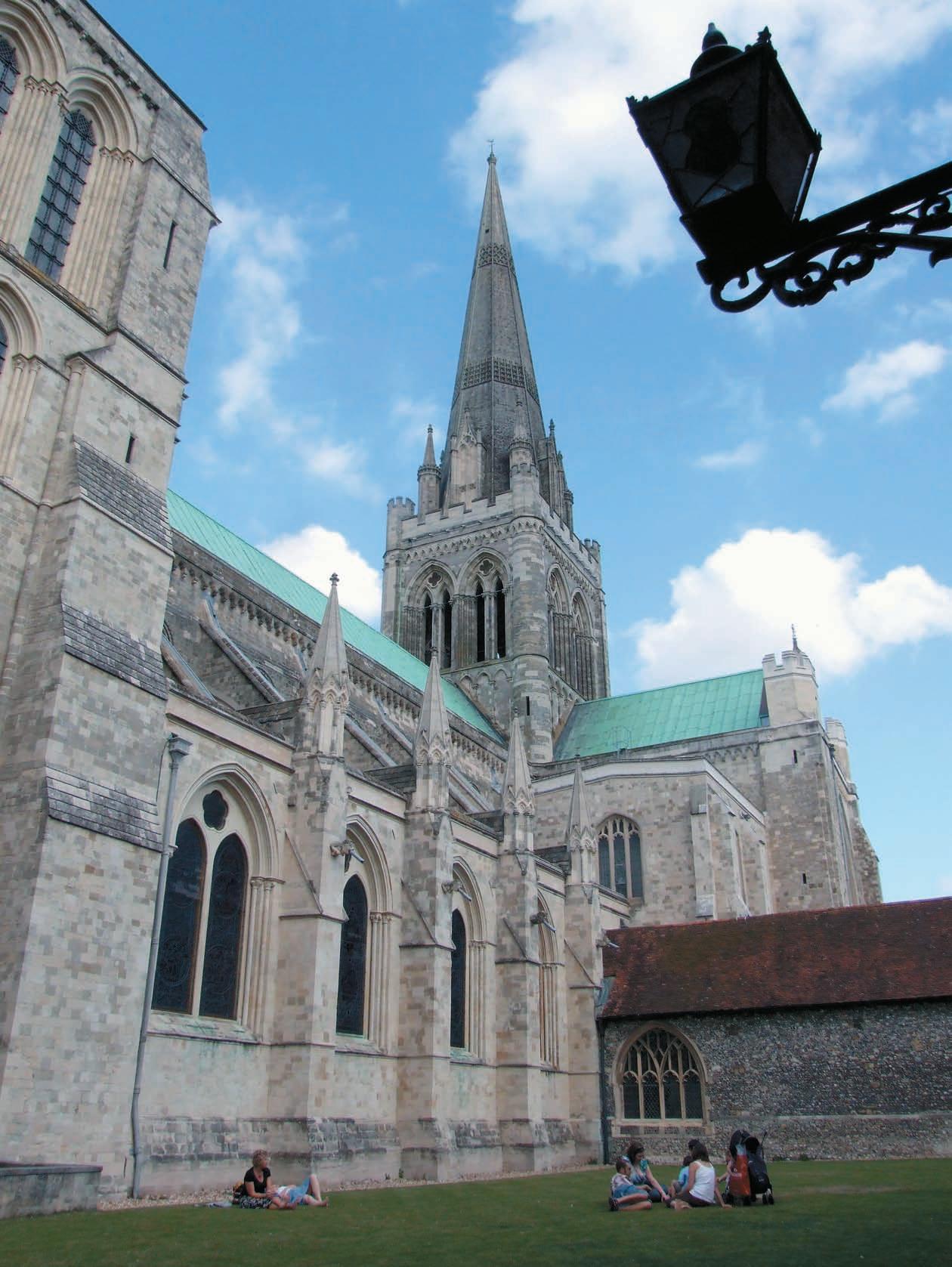
Cathedral Music 43
Chichester Cathedral
P3 140 CM Nov 07 B:3302 Cathedral Music MAY #B5827 31/10/07 14:06 Page 43
Photo: Mike Edgar © theimagecellar
Elements of evil…nothing less than a Scandal
Revd Martin Eastwood
There is a perennial dispute played out from time to time between two camps of fans of cathedrals. On one side stand those whose purpose is to preserve the cathedrals’ sacred character against the inroads of secular influence. On the other are those who welcome the mundane into the cathedral as an expression of the church’s mission to all parts of society. In 1900 TheChurch Times was firmly in the former camp as is shown by its furious attack on the Three Choirs Festival which, it claimed, ‘had in it certain elements of evil, which a later age has developed into nothing less than a scandal’. What was all the fuss about?
First, it was about class. The Church Times report on the festival in its issue of 14 September, 1900, began by suggesting that any institution should be regularly reviewed ‘to show proof that it serves a useful purpose, that it is under the best possible management, that it needs no reformation. For our part we at once affirm that we are by no means satisfied with it as it is’. Though founded with the commendable ‘desire to advance Church Music in three Midland dioceses, and to provide a charitable fund for old singing-men and the widows and orphans of the poorer parochial clergy’ all of which was ‘an excellent design’ yet ‘it had in it certain elements of evil, which a later age has developed into nothing less than a scandal’. This was extraordinarily strong language even for TheChurch Times (which was at this time a campaigning newspaper for the Anglo-Catholic cause within the Church of England). The principal ‘evil’ being attacked was the turning of the festival from an operation designed to deliver charitable resources to the poor (and to draw them into the worship of the cathedrals), into a sequence of concerts for the great and good of the counties involved.
In a section bemoaning the turning
of cathedrals into society concert halls, TheChurch Times suggested that the cathedrals involved were perpetuating the state of religious inactivity and reliance on county connections more readily associated with the cathedrals at the point at which the choral revival had begun in parish churches (the 1830s). Recalling the position of cathedrals at that time, the article suggested that ‘Cathedrals were scarcely regarded as temples consecrated to the perpetual offering of Eucharists and the unceasing recitation of the Divine Office’ but were rather viewed as ‘buildings of special antiquarian or architectural interest under the care of well-bred, well-paid, dignified custodians who stood high with the elite of society’. As such, they were little different from secular concert halls and the sense of desecration much less: ‘there could be no thought of desecration in temporarily converting to the secular uses of the concert room a building which was in effect, the private property of the lessees, whose vergers’ gowns ill-concealed the trader who made “my Father’s house an house of merchandise”‘.
The second element that so angered TheChurch Times was the importation of musicians and audiences from the concert hall which it thought was destroying any sense of holiness that ought to surround a performance of music in a cathedral. Along with the arrival of the oratorio ‘must go Signor This and Madame That, not to mention mademoiselle’s elegant and extensive wardrobe’. Similarly, the performance practice of the concert hall may not be appropriate to that of the cathedral: ‘there is one way of performing it [the oratorio] which befits the place, and one that does not. Unless the idea of a common act of worship is preserved, the whole thing at once sinks to the level of a concert that has somehow strayed from
the public hall into the church’. The article also suggested that such an offering from a liturgical point of view might contravene canon law, and was a ‘concession to the aesthetic craving of the class to whom these festivals appeal’.
TheChurch Times recommended the reform of the festival, its being taken out of the hands of ‘a sort of society enclave within the ecclesiastical sphere of influence’, and the introduction of ‘other-worldliness’ in the place of ‘worldliness’. The importation of soloists and choruses (particularly from Yorkshire!) should be stopped, and the ‘Churchmen’ should say that their ‘Cathedrals were never intended to combine with the theatre, the racecourse, and the regatta, in supplying the rota of fashionable amusements’. And, with a delightfully odd turn to the Bible for support, the article asked, ‘What would St Paul have said to his ‘foolish Galatians’ if he had seen in their summer programme of events the sequence of Eton and Harrow, Henley, Goodwood, Cowes, and the Dublin Horse Show, ending in the Festival of the Three Choirs?’. The article ended with an appeal for the ‘dignified dwellers of the Close’ to hand over this task to others if they were not capable of it.
Naturally, over the next few weeks, there was a huge correspondence arising from this attack, much of it from a number of ‘dignified dwellers of the Close’. Canon H.H. Woodward, in a letter dated 17 September, defended the choral festival, saying that Dean Butler of Lincoln had been so impressed with the festival during his time as a Canon of Worcester that he had inaugurated a similar festival at Lincoln on becoming Dean there. Canon Woodward continued: ‘No one, I think will venture to accuse so illustrious a priest as Dean Butler of conniving at the desecration of a
Cathedral Music 44
P3 140 CM Nov 07 B:3302 Cathedral Music MAY #B5827 31/10/07 14:06 Page 44
The Three Choirs Festival as seen by the Church Times in 1900
cathedral’. Another correspondent denied that the concerts were of appeal only to society figures, and claimed that classing the festival with other society events was ‘a great exaggeration’ as the only ‘society’ figures attending were ‘the gentry and the clergy of the diocese, very few of whom would be seen at the functions you refer to’.
There were also letters in support of the stance that TheChurch Times had taken, one referring dismissively to ‘these Choral Festivals or Choral Treats or whatever they are called’ and arguing that ‘it is more than incongruous, it is pathetic that (the cathedral) should embrace the paraphernalia of a concert, however sacred, in which the service of God may even seem to be postponed to the parade of human art’.
Such a polarisation of views with regard to the use of music in cathedrals is much less frequently heard today but it is still possible to come across distrust of musical ‘intrusion’ into the liturgy, which perhaps has its background in a fear that an excess of aesthetic delight might hamper rather than foster a reverent attitude. And the intrusion of
extended musical works into the liturgy is now a rarity.
In some instances in the early 20th century the musical elements of these ‘services’ had clearly become more prominent than the liturgical. In Canterbury Cathedral special choral services were actually called ‘the oratorio service’, and could contain extended selections of both sacred and secular music. On 4 March, 1905, for instance, the ‘remainder of the service included performances of Mendelssohn’s Hymn of Praise and the last movement of Beethoven’s C minor symphony’. Services often included large forces and the performance of substantial works. In St Paul’s Cathedral, on 15 November, 1900, the twentyseventh annual festival of the London Church Choir Association took place with choirs from fifty-four churches and over one thousand singers.
The diminishing length of church services over the century that followed mirrored practice at the concert hall where the length of concerts in 1900 far exceeded that thought suitable towards the end of the century. Similarly, a ‘performance practice’ attitude towards
St George’s School Windsor Castle
Pre-Preparatory and Preparatory Day and Boarding School for Boys and Girls 3-13 years.
• High quality education and traditional values
• Co-educational policy within a prep school environment
• Opportunities for boy choristers to sing in StGeorge’s Chapel
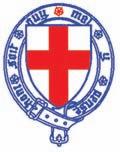
• Five day academic week with flexible boarding arrangements
• Purpose built & equipped Nursery & Pre-Preparatory Dept
• Extensive playing fields and heated indoor swimming pool
• Secure environment for pupils within the Home Park
CHORAL AUDITIONS
For Boys (7 1/2-91/2 years old)
Saturday March 1st 2008
Open Auditions will be held for Choristerships (worth 50% of school fees) with generous additional bursaries also available up to 100%.
Please note that any bursary award will be subject to means testing
Enquiries to the Registrar Aileen De Vally-King, J. Roger Jones, Head Master St George’s School, Windsor Castle
Berkshire SL4 1QF
Tel: 01753 865553 Fax: 01753 842093
e-mail: registrar@stgwindsor.co.uk
Website: www.stgwindsor.co.uk

the liturgy developed alongside that which gradually came to be of paramount importance in the performance of music. The notion of inserting a Beethoven overture into evensong would now seem quite bizarre, and there is a sense in which clergy strive to use the BCP ‘authentically’. Our attitude to the historic liturgies of the Church of England has become very much more ‘precious’ over a period when the use of those liturgies has declined and new liturgies have been introduced.
We can be glad that the services and concerts of the Three Choirs Festival now attract diverse and enthusiastic congregations and audiences. We can also be confident that The Church Times is unlikely to carry a feature describing the festivities as containing elements of evil.
The Revd Martin Eastwood Priest-in-Charge, St Andrew’s, Fulham Fields.
Revd Eastwood is researching twentiethcentury liturgical and musical developments in English Cathedrals.
Cathedral Music 45
I.A.P.S. C.S.A.
P3 140 CM Nov 07 B:3302 Cathedral Music MAY #B5827 31/10/07 14:06 Page 45
DURHAM CATHEDRAL
St JOHN’s COLLEGE, CAMBRIDGE CHORISTER

CHORISTER
Join
There will be ORGAN and CHORAL SCHOLARSHIP VACANCIES from October 2008.
For details of these Scholarships and Choristerships, please apply to:
The Organist, James Lancelot, 6 The College, Durham DH1 3EQ Tel. 0191 386 4766
email: dale.robinson@durhamcathedral.co.uk
www.durhamcathedral.co.uk
www.durhamcathedralchoir.org
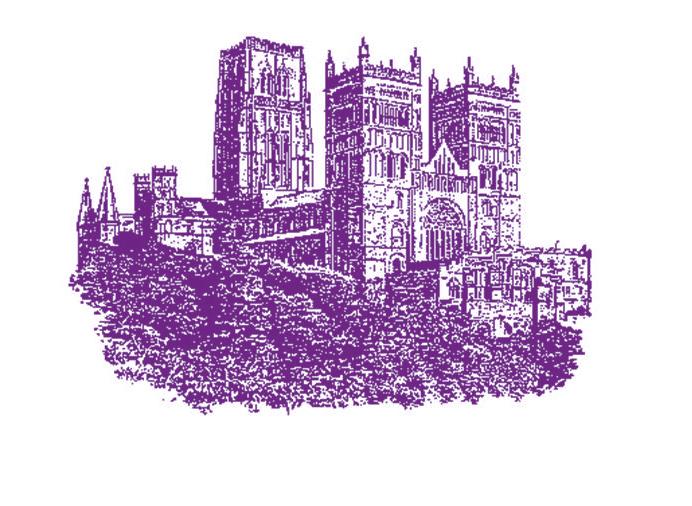
VOICE TRIALS
VOICE TRIALS
Formal Voice Trials for boys aged 6 – 9 years old, who are interested in admission to St John’s College Choir, are held in spring and autumn each year.
For further details please contact Mr Alex Loria at St John’s College School on 01223 353652 or by sending an e-mail to admissions@sjcs.co.uk
SALISBURY CATHEDRAL CHOIR
Be a Chorister for a Day
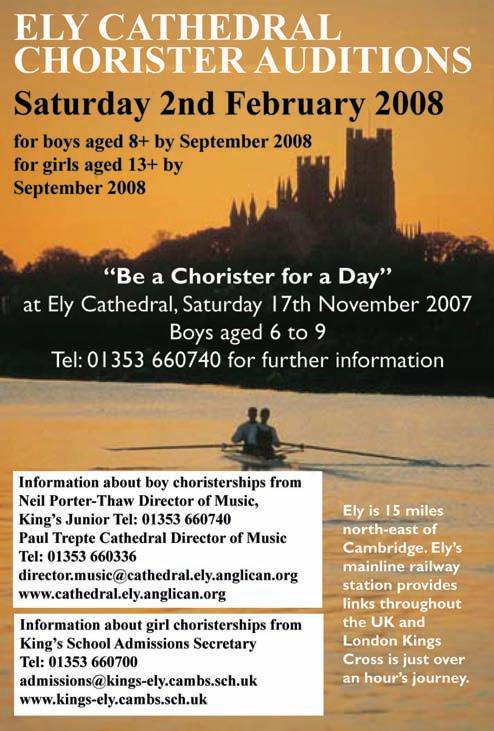
Saturday 10 November 2007
An open day for prospective choristers in Years 2, 3 and 4 and their families
VOICE TRIALS
For children currently in Year 3 or 4
Boys - Saturday 26 January 2008
Girls - Saturday 9 February 2008
ORGAN SCHOLARSHIP
For the academic year 2008-09
An ideal opportunity for a student to experience all aspects of cathedral music in a unique setting
Closing date: Friday 9 November 2007
Auditions: Friday 7 December 2007
For an informal discussion with the Director of Music and/or further details please contact:
The Department of Liturgy and Music, 33 The Close, Salisbury SP1 2EJ
Tel: 01722 555148
email: litmus@salcath.co.uk
Cathedral Music 46
one
finest choirs
dramatic Cathedral City of Durham
of England’s
in the
P3 140 CM Nov 07 B:3302 Cathedral Music MAY #B5827 31/10/07 14:06 Page 46
Sir Philip Ledger CBE A Birthday Tribute Dr
Type Philip Ledger’s name into Google and Wikipedia offers this opening sentence, ‘Sir Philip Ledger CBE is a British classical musician and academic’. That bald statement might apply to any number of British musicians, and hides the incredibly broad scope of Philip Ledger’s distinguished career.
Philip Stevens Ledger was born in Bexhill-on-Sea, 12 December, 1937. Educated at Bexhill Grammar School, he pays touching tribute to the young woman who inspired his life-long love for the piano, and helped him to establish the superb piano technique which has underlaid his musical career. He went up to King’s College, Cambridge to study music, but not, at that time, as an organist. Encouraged by Sir David Willcocks, he took the FRCO diploma in 1959, winning the Limpus and Read prizes for good measure.
From Cambridge, Ledger went directly to be Master of the Music at Chelmsford Cathedral. His special gifts as a conductor found full expression in his successful direction of the Chelmsford Singers and the Essex Symphony Orchestra. Indeed, his reputation continues still among those who knew him in those days, and it was a great joy for the present writer to invite Sir Philip back to perform in the Chelmsford Cathedral Festival on several occasions. The breadth of his skills was summarized by the fact that he appeared as conductor (Britten Spring Symphony); piano accompanist in a song recital with Stephen Roberts, and even as preacher at a Festival Service! He has often said that the latter was his most nerve-racking experience! Of course his beautifully crafted choral pieces were a part of the regular repertoire of the Cathedral Choir.
During his short spell at Chelmsford, Ledger laid the foundations of the wider musical career he was to pursue. He became a regular performer at Aldeburgh, forming links with Britten and Pears which led to his becoming a member of the
Graham Elliott
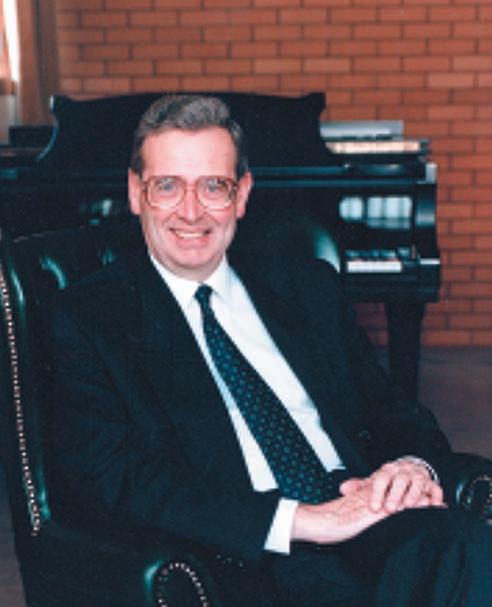
directorate of the annual Aldeburgh Festival. In 1965 he left cathedral music to become the first Director of Music at the young University of East Anglia. There he put down the strong roots of a department which was to become acknowledged as one of the leaders in its field.
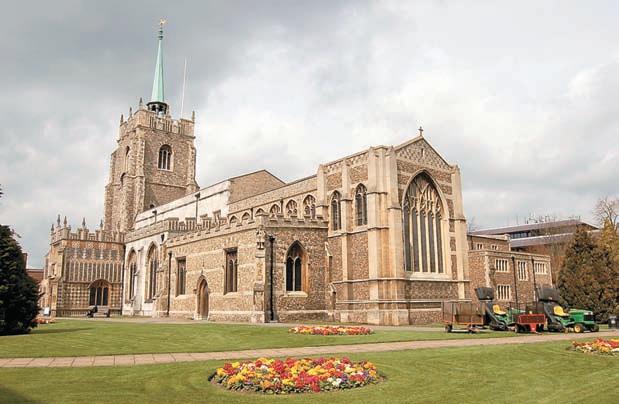
To the surprise of those who believed that Ledger had left behind him the world of church music, he returned, in 1974, to be Fellow and Director of Music, in succession to David Willcocks at King’s College. His work in maintaining the world-renowned choir is enshrined by some magnificent recordings. Many continue to treasure, in particular, the recording of the Duruflé Requiem Mass, with the unforgettable Pie Jesu, sung by Dame Janet Baker.
In 1982 Philip Ledger moved back into the world of music education, succeeding Sir David Lumsden as Principal of the Royal Scottish Academy of Music and Drama. Among his lasting contributions to that institution is the establishment of the Alexander Gibson Opera School, in 1998. Philip Ledger retired from RSAMD in 2001, honoured with a clutch of doctorates, the CBE and a knighthood. Retirement to the Cotswolds has allowed him time to expand on another area of his creativity which he now has enough time to pursue: composition. Up to this point he is largely represented by a number of small, elegantly crafted choral pieces and arrangements. This year sees him branching out into more extended writing with the first performance of his Requiem (A Thanksgiving for Life) commissioned by Christ Church, Christiana Hundred, Delaware, USA, which will take place there on 4 November. The first performance in the UK will be conducted by Philip Ledger with the King’s College Choir in the Chapel of King’s College, Cambridge on Remembrance Sunday (11 November). As Ledger approaches his 70th birthday he shows no sign of slowing down, and we may look forward to further evidence of the breadth of his musicianship in increased creative writing. Happy birthday, Sir Philip!
Cathedral Music 47
Graham Elliott was organist of St Asaph Cathedral and served 18 years as organist of Chelmsford Cathedral before moving to become Director of Music at St Paul’s Episcopal Church, Rock Creek, Washington DC.
P3 140 CM Nov 07 B:3302 Cathedral Music MAY #B5827 31/10/07 14:06 Page 47
Chelmsford Cathedral
Festivals Overview
Despite its fraught start the 2007 Gloucester Festival was a huge success, with about 25,000 attendances, 4.5% more concert tickets sold than in 2004, with 80 - 85% average sales overall. Cathedral seating capacity is 1700.
This year two factors threatened cancellation of several festivals: floods and finance. The Chelmsford Cathedral Festival had already announced that 2007 would be its last, due to funding problems and for the same reason the 23rd International Organ Festival at St Albans might have been called off but at the eleventh hour its long-standing backer, John Stocker, stepped in and rescued it. The flooding in Goucestershire forced the cancellation of the Musica Deo Sacra Festival at Tewkesbury Abbey, where water entered the Abbey nave for the first time since 1770, and this was nearly the fate of the 280th Three Choirs Festival at Gloucester, due to lack of the public water supply.
City of London Festival June 22 - July 12
There were no such problems for the City of London Festival in June, where I attended three major musical events, all reflecting this year’s French theme. The first was a recital on Southwark Cathedral’s gutsy Lewis organ (no Cavaillé-Coll but so good for French repertoire) by Daniel Roth, the titulaire of the large Parisian church of Saint-Sulpice, who played music by six of his illustrious predecessors and himself. Included were movements from two of Widor’s symphonies, an Offertoire by Lefébure-Wély, pieces by Nivers, Clérambault and Grünenwald, ending with Dupré’s powerful Paraphrase sur le Te Deum. M.Roth gave a virtuoso performance, shown on a large projection screen, and is clearly a worthy successor in this legendary lineage but he would have to serve until 2050 to equal the 64-year record of Prof Widor!
By happy chance a concert by the BBC Singers in St Lawrence Jewry was directed by its principal guest conductor, Andrew Carwood, the new Director of Music at St Paul’s Cathedral. This gave me the chance to hear his impact on this professional chamber choir; the electrifying result in a programme of French sacred music from Widor to Naji-Hakim, gives me cause for great optimism about the future performances of the St Paul’s choir. The third concert took place in the Cathedral itself, the stupendous musical masterpiece by Berlioz, the Grande Messe des Morts, first performed in the Dome des Invalides in Paris, which has similar acoustics to St Paul’s. In addition to large chorus and orchestra, it requires four brass bands, which were placed in the four arms of the cathedral, to sensational effect, with the London Symphony Orchestra and Chorus arrayed across a huge platform in the dome area. Yan Pascal Tortelier secured a performance of great spirituality and power; the demanding high tenor solo was superbly sung by Andrew Kennedy. The new director of the CoLF is to be applauded for including more choral and organ music this year; with so many churches and historic organs available we want a return to the organ recital series of the 1990s.
International Organ Festival at St Albans July 12 - 21
After its funding crisis, it is good to report that the International Organ Festival at St Albans was once again a great success this year. Owing to overlap with the unmissable Southern Cathedrals Festival, I could only attend its two choral concerts: a fine rendering directed by Andrew Lucas of Elgar’s last oratorio The
Kingdom, with shining soloists Susan Gritton, Catherine WynRogers, Andrew Staples and Stephen Roberts and the St Albans Bach Choir, which brought out the spiritual warmth inherent in this rather diffuse work; the other was the Three Choirs Concert, for many the highlight of the festival. This year St Albans Cathedral Choir was joined by those from St John’s College, Cambridge and St Thomas Church, New York City in a deft sequence of wellcontrasted choral works drawn from five centuries of sacred music, interspersed by three organ solos. To great effect the combined choirs opened part one with Elgar’s stirring Light of the World and closed it with Alan Ridout’s powerful Corde Natus scored for three a cappella choirs; then part two began with Charles Wood’s Hail gladdening light (sung under the tower - I sat close and it was truly stunning!), after which the gentlemen processed to the nave singing verses of the great plainsong hymn Iste Confessor Domini in alternation with organ verses by Tallis and Redford from the Mulliner Book. This was wonderfully atmospheric, in candlelight, evoking echoes of the former Benedictine Abbey. The complete Messe Solennelle by Langlais, highly charged by Mr Lucas, made a powerful finale to this choral feast.
Southern Cathedrals Festival at Chichester July 19 - 22
There was a brief respite in the weather for the Southern Cathedrals Festival at Chichester and the newly restored and cleaned cathedral glowed in the welcoming sunshine, providing a bright setting for an exhibition of sculpture in the cloister garth (known as Paradise).
At SCF (Chichester-Winchester-Salisbury) there is always a nice balance between choral services and concerts of sacred music, which are concentrated into three days, with light relief in the late evening provided by the lay vicars’ Fringe Revue. It all began with Choral Matins, sung by Chichester’s choir (Stanford in A and Vaughan Williams’s Let all the world), then at 2 pm a wonderful concert, sung from the west end of the nave by boy choristers and men of the three choirs. First, three a cappella motets by Stanford, whose Postlude in D minor was the first of three organ interludes played by Chichester’s organ scholar, James Mountford. Then, Stanford’s A Song of Wisdom , S.S.Wesley’s Ascribe unto the Lord and three Charles Wood anthems: Great Lord of Lords, Hail gladdening light and Glory and Honour. The three directors of music, Alan Thurlow, David Halls and Andrew Lumsden shared the conducting and drew out vibrantly expressive renderings. At 4.30pm Winchester’s choir sang Choral Evensong (Sumsion in G and Rheinberger’s Abendlied). The evening event was a recital on the splendid main organ by Colin Walsh, featuring French works plus a Buxtehude fugue in C, Bach’s prelude and fugue in G (BWV541) and Frank Bridge’s Adagio in E, a brilliant and satisfying performance, as always from this virtuoso organist. On Friday, the Festival Eucharist, sung by the male voices of the combined choirs to Vierne’s Messe Solennelle, with anthems by Shephard and Villette. This reached great choral heights, which rang long in the memory. After lunch a large audience assembled in St Paul’s Church, Northgate for a masterclass with boy choristers, given by the veteran choir trainer John Bertalot. This was
2007 Cathedral Music 48
P3 140 CM Nov 07 B:3302 Cathedral Music MAY #B5827 31/10/07 14:06 Page 48
disappointing, with too much talking and not enough singing. Mutatis mutandis that evening’s concert suffered from the same imbalance. It was billed as ‘a sequence of choral and organ music’ ‘with readings by Patricia Routledge and Nicholas Frayling’ but in the event it was the reverse: there were two or three consecutive readings, some quite long, in between just a single, often short, anthem. The readings, beautifully delivered, seemed too weighty for the choral interspersions and did not link with each other easily. On Saturday morning we all returned to St Paul’s for coaching in the art of plainchant, interactively with the group Opus Anglicanum; this was revelatory, it was so easy to join in and we were uplifted.
Later at Choral Evensong, all the girls sang the top line with the combined men (Howells Col. Reg.,Haydn’s The heavens are telling). The final concert presented a superbly sung blend of baroque liturgical works (Purcell, Pergolesi and Vivaldi) with an a cappella setting by Bax of a text from 1300 This Worldes Joie (he lived near Chichester and often visited the cathedral organist). Two instrumental pieces rested the choirs: Copland’s The Quiet City and a sparkling Handel Organ Concerto, with Mark Wardell as the virtuosic soloist on a delightful chamber organ. Few realised that SCF 2007 would be Alan Thurlow’s last as Festival Director but we now know he is leaving Chichester at Easter, after 28 years, during which his direction of the cathedral’s music has achieved great distinction. Whether the choir was down to nine boy trebles or up to its full complement of 18, the singing always reflected his high standards, as to tuning, diction, and ensemble but above all achieving the finest choral tone – a true cathedral sound.
Gloucester Three Choirs Festival August 4 - 12
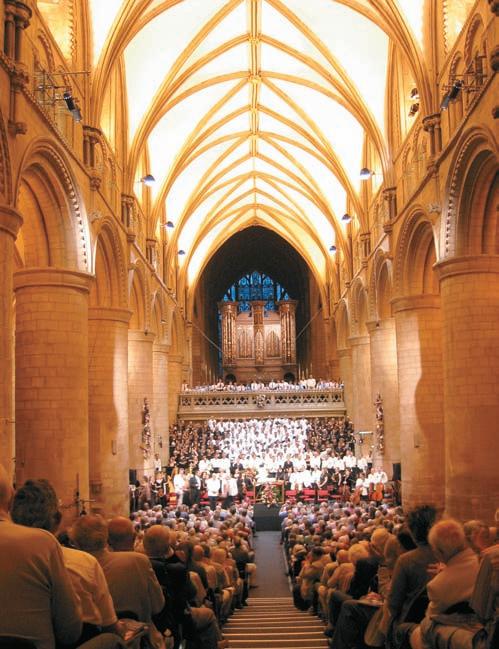
The floods in late July were nearly a baptism by immersion for the new Gloucester Festival Secretary, Paul Hedley, a bass lay clerk at the cathedral, who was much admired for his sang-froid in holding the show on track: events had to be relocated, visitors and artists reassured. Despite this I noticed he always seemed to be where he was needed, as well as singing in the combined choirs for four of the uplifting Choral Evensongs. As in 2004 they were preceded by an organ recital, except for the service recorded for Radio 3; there was always a huge queue, with the large quire filled to capacity by a very diverse congregation.
Equally splendid was the Opening Service on the Saturday morning, with the Cathedral Choir, the Festival Chorus and English Festival Brass: a Kodaly introit and settings by Whitlock, Howells, Stanford and Vaughan Williams. The Dean spoke of the miraculous way the floodwater had stopped 2? inches short of cutting off the city’s power and the water supply being restored at the eleventh hour. In Sunday’s Festival Eucharist the Cathedral and Youth Choirs, accompanied by the Philharmonia strings, performed Schubert’s Mass in G(D.167) with great warmth. Later, the lay clerks created calm with Compline in the vast, candle-lit Perpendicular quire.
The range and quality of music at Three Choirs is great: lunch-time recitals by RCO- chosen organ scholars in St John’s Northgate; song or instrumental recitals in St Mary de Lode, notably a vibrant sequence sung by the distinguished baritone, Roderick Williams, always much admired at the Festival, accompanied sensitively by Iain Burnside.
Of the eight evening concerts in the Cathedral all but one had a choral element, opening with an evocative rendering of Britten’s great pacifist War Requiem by the Gloucester choristers, the Festival Chorus and the Philharmonia under Andrew Nethsingha. The theme of pain and death was so powerfully expressed by both Stephen Roberts and James Gilchrist, the latter’s fierce style uniquely fitting the part. In Elgar’s Dream of Gerontius, three nights later, the same style did not seem right for the old man himself, who is not angry but fearful of death and later reaching a transcendental state. The other soloists, Sarah Connolly and Roderick Williams, seemed more apt. On Wednesday, we had a Haydn and Walton concert under Geraint Bowen, crowned by a spirited Theresienmesse. On Thursday afternoon the sixth of the Philharmonia’s eight concerts was to have had a Three Choirs premier: Bax’s 1st Symphony directed by his greatest advocate, Vernon Handley but sadly he collapsed at rehearsal and the Bax had to be replaced by some Elgar. That evening offered a glowing performance of one of the greatest works of the early baroque: Monteverdi’s Vespers of1610. It was given by the virtuosic Ex Cathedra Choir, Soloists and Baroque Ensemble under its founder, Jeffrey Skidmore, with His Majesty’s Sagbutts and Cornetts enriching the ravishing texture still more. Friday was the fullest day, with nine events: first The Unknown Elgar, songs and piano music presented by David Owen Norris, with soprano Amanda Pitt giving stylish performances.
At 3pm the Three Cathedral Choirs Concert directed by Geraint Bowen: a pacey and expressive Bach cantata (51), then Vivaldi’s Magnificat and Gloria, tautly driven. At the evening concert under Adrian Lucas Elgar’s The Spirit of England, sung with exultant choral clarity and orchestra to match, then a resounding Holst Planets. Next morning John Scott gave a lively organ recital: Langlais, Buxtehude, Bach, Joubert, Wood and Duruflé, well-suited to the uniquely voiced Gloucester instrument, a delight throughout the entire festival. Robert Houssart also gave a fine recital on it, as well as playing splendidly for services. As an inspired choice for the final concert Andrew Nethsingha picked Mahler’s Symphony No 8, the composer’s great affirmation of Christian belief in spiritual growth and redemption. In the event, the Festival Chorus and the eight soloists were driven so fast in part one’s Veni Creator it became a frantic scramble and all gravitas was lost (even the Philharmonia were tested) but part two recovered it with more seemly tempi and both chorus and soloists were able to soar and hover in an increasingly exalted religious atmosphere.
This was Andrew Nethsingha’s last festival and he deserves the highest praise for its quality, which many people feel ranks high in the annals of the Three Choirs. Paul Hedley coped with his first festival superbly, including editing one of the best presented programme books ever. The Festival Chairman, Bernard Day, offering calm support to everyone was also a key factor.
Cathedral Music 49
Gloucester Three Choirs Festival 2007
P3 140 CM Nov 07 B:3302 Cathedral Music MAY #B5827 31/10/07 14:06 Page 49
Photo: Roger Tucker
Stephen
Sir: Just to put the record straight on the inclusion of homilies in the weekly broadcast of Radio 3’s Choral Evensong (referred to by Andrew Palmer in the Comment page in the last edition), the reason is simply that there are many cathedrals accustomed to a Sunday afternoon sermon. It seemed therefore only courteous to suggest to those places that they may like to retain that tradition, albeit restrict the homily to no more than five minutes! During Lent, when the Sunday broadcasts
began, Radio 3 was marking the 200th anniversary of the Abolition of the Transatlantic Slave Trade, so it was felt appropriate to reflect on that particular topic during the service at cathedrals in cities which were involved in the Slave Trade.
Readers may be assured that Radio 3 is taking note of the reaction of listeners to the move of the programme to Sunday afternoon and monitoring the numbers: the change of transmission day is being kept under review.
Revd Redmund S. Haviland.
Sir: I have just read the article in the CATHEDRAL MUSIC issue 1/07 by the Bishop of Stafford on the Psalms. I much appreciated it; it, with some expansion, should be known more
widely. The daily use of the Psalms has been an invaluable rock for me, lately in the NEB version and now in the Common Worship. I miss the BCP Psalms and all their associations, but greatly value the freshness of the CW translation which helpfully irons out lots of obscurities and helps to make so much so contemporary and relevant. But most of all I miss the singing of the Psalms in our present-day Sunday worship, (now that I am generally in the congregation), and I feel something important is being lost for current worshippers. A solo cantor or speaker is better than nothing, but the words don’t become ‘ours’, and one worries about where the refrain comes (and remembering it!). I am sure the CW version must have been pointed for congregational use, and it must be just what is needed at this time, but where is it used? Does any cathedral use it? I have not heard of one. Why is it not
Royal School of Church Music
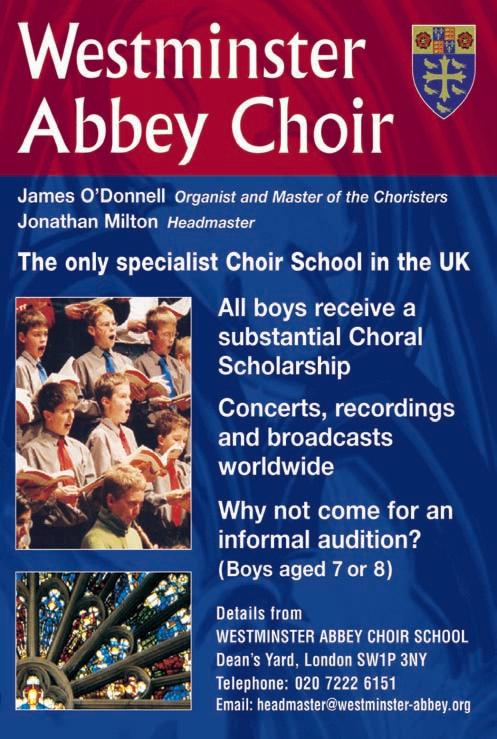
International Summer School and Conference
Monday 11 - Sunday 17 August 2008, Canterbury, England
...transforming, enabling and inspiring worship
A week of music, worship, practical activity, discussion and fellowship, to inspire the transformation of worship through music.
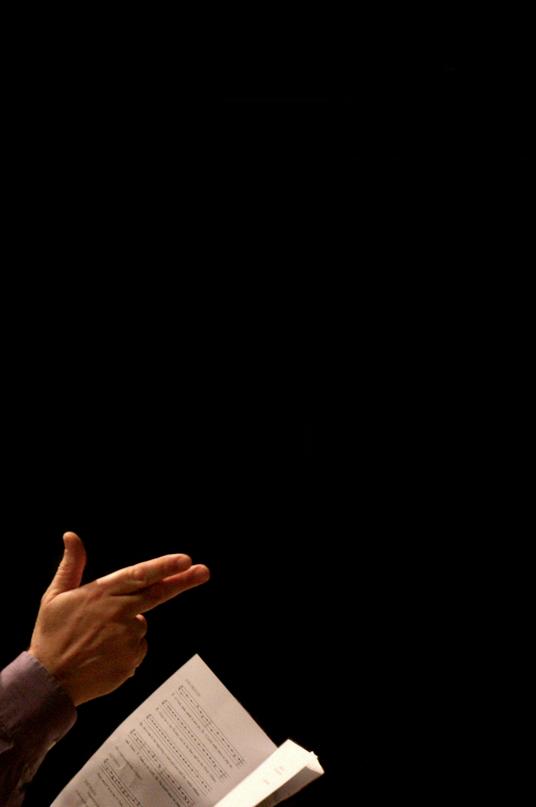
Cathedral Music 50
Shipley, Series Producer, Choral Evensong, BBC Religion and Ethics.
Letters
Contact us for a brochure or visit our website Tel: +44 (0)1722 424843 Email: issc@rscm.com www.rscm.com/issc P3 140 CM Nov 07 B:3302 Cathedral Music MAY #B5827 31/10/07 14:06 Page 50
With Bob Chilcott, James MacMillan, Ken Burton, Geoff Weaver, and many others.
promoted for regular congregational use, in ordinary parish church and in cathedral? Or have I just missed out?
Alan Mould, Salisbury.
Sir: All lovers of the cathedral choral tradition will be grateful for the concern and support for this heritage expressed by Frank Field MP in his article in CATHEDRAL MUSIC 1/07.
Unfortunately it contained some serious misconceptions.
Mr Field suggests that the high cost of maintaining cathedral choirs is in part due to the uneconomic smallness of the choir schools that educate only choristers.
Only Westminster Abbey Choir School is exclusively for choristers. In all other British choir schools the choristers are a minority of the pupils. The average
All readers whose letters are published will receive a copy of FCM CD O How Glorious a compilation of cathedral music from the Priory Records catalogue. Letters may be shortened for publication.
number of pupils in a choir school in 2004 was 457 and is rising. Far from being smaller ‘than they once were’ (Mr Field’s words), every choir school in Britain now educates more children than it has ever done in its past. Some are very large. Hence very few, if any, choir schools (Westminster Abbey excluded) are subsidised by their chapters. They balance their accounts, with expenses covered by fees and other income, and in recent years many have raised large sums for the enhancement and extension of their premises, thereby adding substantial value to property that the chapters own but that the schools maintain and for which they pay large rents. What the chapters do fund is the chorister scholarships – and so they should, because the choral work of the choristers is performed on behalf of the cathedral, not on behalf of the school. This is the cost that is worrying some chapters.
Mr Field goes on to suggest that ‘many of these great choirs are [near] to being axed’. My understanding is that the cathedral choral tradition has rarely been more highly valued by the cathedral chapters than it is today. After all, many of them have recently added teams of girl choristers to their boy choristers – not a cost-free venture. Could you, Mr Editor, identify for us those foundations considering the axing of their choirs so that FCM could focus its generosity – and concern – on these waverers?
All general points and comments welcomed. Please send letters by 8 March 2008 to:
The Editor, 21 Belle Vue Terrace, RIPON, North Yorkshire HG4 2QS Fax: 0871 242 2024 ajpalmer@lineone.net
SCATTER THE DARKNESS: CATHEDRAL POEMS
by Humphrey Clucas
Better known as a cathedral musician, Humphrey Clucas devoted twenty years of his life to poetry. The poems come mainly from his two published collections. Five sonnets were commissioned to celebrate the 900th anniversary of Winchester Cathedral in 1979. There are poems about Bach and S.S.Wesley, St Valentine and Good King Wenceslas, an old and bibulous organist. ‘Deeply formal… A love of literature and music shines through.’ Eva Salzman, in the TLS.
To order, send a cheque for £3.60, made out to Humphrey Clucas, at The Lewin Press, 19 Norman Road, Sutton, Surrey SM1 2TB
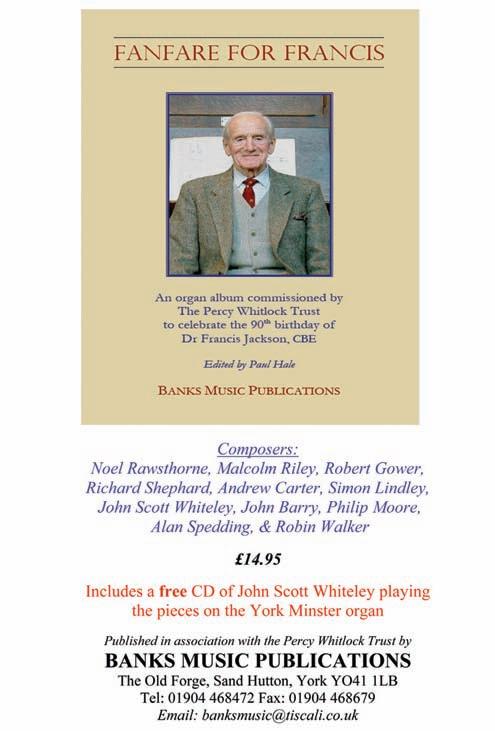
Cathedral Music 51
24pp ISBN 978-0-9550470-1-5
P3 140 CM Nov 07 B:3302 Cathedral Music MAY #B5827 31/10/07 14:06 Page 51
Book & Music Reviews
Voice for Life Songbook - RSCM
TheSongbook comes from the RSCM Voice for Life initiative which aims to raise standards and encourage people from all walks of life to sing in their local church choir. This book is an anthology of warm-up songs, rounds, and songs to increase the repertoire of the parish choir. The collection of songs featuring many well-known composers such as Bob Chilcott and John Bell varies from the simple unison song to songs with two parts or more. Also included is sound and sensible advice for the inexperienced choir conductor. The accompanying CD which consists of solo voices and piano is fine in that it gives the listener an idea of the music contained in the songbook. However, it could have been presented in a much more stimulating style. The book brags of inspirational songs which on paper it certainly has but the CD does not complement this by offering any ideas on how to perform these wonderful pieces in an exciting way. I think the RSCM has missed out on a golden opportunity to inspire many church choirs to raise their standards. On the front cover of Voice for Life Songbook it states ‘songs to get your choir singing!’ This is no idle boast as the information and music included would be of great benefit and inspiration to many church choirs nationwide, especially those which struggle to attract tenor and bass voices.
Gillian Hart
Sunday by Sunday Collection II – RSCM
For your traditional church choir this is a welcome addition to the repertoire. Volume One in this series was a collection of 30 anthems, Volume Two is much broader in its scope and gives a choice of music for all parts of the Sunday Eucharist. An anthology of pieces written by well-known church music composers ranging from Thomas Tallis to David Ogden gives an idea of the variety sourced in this book. The backbone of this anthology is choral pieces which are written for SATB and straightforward to sing. Also included are some useful responses and short pieces which can be sung in a variety of ways to enhance and enrich services. Though the blurb on the back cover announces that much of the music can be sung by a range of different choir set-ups, the pieces, in reality, are biased towards an SATB choir with sections for unison or two-part singing. The accompanying CD is beautifully sung by the Sarum Voices and gives an excellent idea of the choral music contained in the book. This collection of choral music would be an excellent supplement for any church choir repertoire and very accessible for the performers as well as the listeners.
Gillian Hart
journals and newspapers’. The present volume follows an earlier title by the same author, Percy Whitlock, Organist & Composer, A Biographical Study (Thames Publishing 1998 & 2003), which was the result of 20 years’ research by the author and also surveyed Whitlock’s considerable output of music. As the author intended, there is very little duplication between the two books and treated as a set, the books provide a stunningly fascinating glimpse into the life of one of the finest organists of his generation. Whitlock’s early years were spent in and around Rochester, Kent, where, at the age of eight, he joined the Cathedral Choir, during Bertram LuardSelby’s time as organist. Five years later Luard-Selby was succeeded by Charles Hylton Stewart and five years after that, Whitlock was himself appointed Assistant Organist at Rochester Cathedral, a post which he was able to hold at the same time as being Organist of St Mary’s, Chatham and later Organist of Borstal Parish Church. In 1930, Stewart moved to Chester and was succeeded by H A Bennett. Having failed to be appointed to the top job at Rochester, Whitlock moved to Bournemouth, as organist at St Stephen’s Church, where he stayed for just over five years. From 1934 he was Borough Organist to the Bournemouth Corporation, a post which became full-time when he left St Stephen’s. Bournemouth Pavilion still houses the four-manual concert organ built by John Compton in 1929, which Whitlock played almost every week for the last 12 years of his life. During the first part of the Second World War, Whitlock also worked for the Food Control Office of Bournemouth Borough Council, whilst continuing to play recitals and concerts in Bournemouth Pavilion and elsewhere, a great many of which (certainly by today’s standards) were broadcast by the BBC. Whitlock never enjoyed the best of health, even before he contracted tuberculosis at the age of fifteen, and so his death at the age of 42 is unsurprising. In the book the reader will find a large number of letters, the greater part of which were written by Whitlock to Leslie Barnard (to whom the book is dedicated in celebration of his 90th birthday) and date from 1936 to 1939. In addition, there are articles written by Whitlock on subjects including the Organs of Rochester Cathedral, Bournemouth Pavilion and the Convention Hall Atlantic City (the largest organ in the world, now sadly unplayable), Organs in and around Bournemouth, the organ of the future, Organ broadcasting, the baroque revival and the pipeless organ. There are also photographs of Whitlock and others mentioned in the book, a transcript of Whitlock’s will, the score of the Song of Bournemouth for which both words and music were written by Whitlock and some extracts from his diary. All of these would, of course, make for an interesting publication by themselves, but it is the content of Whitlock’s writings that caused me to enjoy the book so much. The book is equally entertaining whether one chooses to start reading on page one and read through to the end or to dip in and out of the book at random. In both cases, the reader will discover two very different facets of Whitlock’s personality. The first is knowledge of music, in particular the organ and its construction, whilst the second is his delightful sense of humour, which is ever present in his letters to friends. I recommend this book and would suggest that readers also obtain a copy of the earlier publication mentioned at the start of this review.
Tim Rogerson
HIRAETH
Selection of Poems and Writings. Robbie Sharma. ISBN 978-0-9554718-0-3. Available from: Nath & Kiran Sharma. Coed Talwern. Dyffrn Ardudwy. Gwynedd. LL44 2ER £4.99 p&p FREE.

BOOKS
BOOK REVIEWS
THE PERCY WHITLOCK COMPANION
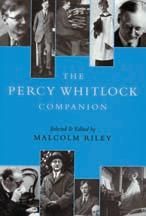
Selected and edited by Malcolm Riley.
The Percy Whitlock Trust ISBN 978-0-9555669-0-5
£18.00 + £2.00 p&p cheques payable to The Percy Whitlock Trust. Available direct from Malcolm Riley, 32 Butcher Close, Staplehurst. TN12 0TJ
Malcolm Riley explains in the introduction to this book that he has sought to ‘bring together the bulk of the surviving correspondence written to and by… Percy Whitlock, together with a selection of articles written by him for various musical
Robbie was born in 1964 and became a chorister in the choir of Lincoln Cathedral and then went on to read Philosophy & Theology at Oxford. He died aged 39 in 2004. His parents have decided to publish his excellent poetry which captures simple everyday events and human relationships conveyed with tenderness and feeling. The writings are of a spiritual and philosophical tenor. This beautiful collection of writings, reflects his strong faith and love of music. This selection of poems and writings are a personal insight into this creative individual. The poems can be dipped into at any time and highlights include his essay on the quality of silence and a short play. The piece on Lincoln Cathedral Old Choristers’ 1996 reunion effectively used a verse from the hymn For all thy saints. I enjoyed this compilation of poems.
Patrick Mayhew
Cathedral Music 52
P3 140 CM Nov 07 B:3302 Cathedral Music MAY #B5827 31/10/07 14:06 Page 52
SCATTER THE DARKNESS: CATHEDRAL POEMS
 By Humphrey Clucas
By Humphrey Clucas
ISBN 978-0-9550470-1-5
£3.60 or from the LEWIN PRESS
19 Norman Road Sutton SM1 2TBH. Price includes: p&p cheques payable to the author. Clucas is a talented man, both composer and author and in this collection he delivers some compelling and impressive poems. The main work is the Psalms for the Ninth Centennial commissioned by the late Very Revd Michael Stancliffe to celebrate the 900th anniversary of the founding of Winchester Cathedral in 1079. My favourite two were De Profundis and Nisi Dominus. The poem Bist du bei mir is a cleverly written short piece as is Wesleyby Itchen. For all of you who enjoy a fine song, sonnet or anthem where the words make all the difference to the composition, will enjoy these poems.
Patrick Mayhew
BANKS MUSIC PUBLICATIONS FRANCIS JACKSON:Festivo
£4.75
This piece is vintage Jackson bearing all the hallmarks of a composer who knows how to write for the instrument. It is not an easy piece but don’t let that put you off. It will make a good voluntary on an instrument with a good reed stop for some trumpet solos.
Patrick Mayhew
See the advertisement for Banks Music Publications on page 51 for details of the new Organ album commisioned by The Percy Whitlock Trust as a 90th birthday tribute to Dr Francis Jackson.
This will be reviewed in the next edition of Cathedral Music as well as the free CD of John Scott Whiteley playing the pieces on the York Minster organ.
CD Reviews CHORAL
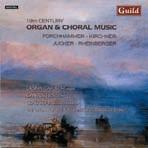
Editor’s Choice ANTON BRUCKNER
Polyphony.
Director: Stephen Layton. Britten Sinfonia.
Ave Maria; Locus Iste; Mass No 2 in E minor; Christus factus est; Vexilla Regis; Os iusti; Virga Jesse floruit; Pange lingua.
HYPERION CDA67629 TT 69:31
The singing on this CD is superb. Just take the performance of Locus Iste, the phrasing of this simple motet has much to commend it and Layton’s choir brings a freshness to the piece not often heard. In fact, compare the two bestknown works on this CD (Locus Iste & Os isuti) and wallow in the brilliance and crispness of the choir’s singing. The men’s voices sound like one of those magnificent Russian choirs full of resonant basses and as a whole blends so well. The wide tonal range as we have here, in Bruckner’s finest choral music, can be a hard feat to bring off but Layton’s choir is polished and produces music of the highest quality. This is yet another in a long line of fabulous CDs where the accuracy of the choir is second to none. The direction of the choir is imaginative, authoratative. Quite simply magnificent and probably one of the best CD in our field this year.
Graham Hermon
OUT OF THE STILLNESS
RSCM Millennium Choir.
Director: David Ogdon.
Organ: Daniel Moult. Wilby Jubilate;Wondrous Cross; Shephard Out of the stillness; Jubilate; Hatfield Living in a holy city; Trad Were you there; Sumsion They that go down to the sea in ships; Sanders The Reproaches; Kelly Done is a battell on the dragon blak; Ogdon Christ has no body now but yours; Archer Prayer of St Richard of Chichester; Harris Behold the Tabernacle; Moore Lo! God is here!; Harper Choristers’ Prayer; Rutter Gaelic Blessing; Chilcott Be thou my vision; Aston The True Glory; Nicholson God be in my head.
Available from RSCM Direct 0845 021 7726 then dial 206. musicdirect@rscm.com £12.95 (£11.95 for RSCM members). TT 75:40

What sets this CD apart from many others is its booklet! More later. The singing is marvellously controlled, as one would expect from the RSCM’s Millennium Youth Choir, a group I want to hear more from. Daniel Moult’s terrific accompaniments add to the enjoyment and ambience of this CD especially in Sumsion’s superb They that go down to the sea in ships. The singing comes into its own in this brilliantly recorded disc especially in the unaccompanied items such as Sanders’s Reproaches and it is a testament to the high standards the RSCM strives for. As for the booklet – other record companies take note: each of the composers is profiled with a photo, where they were born, went to school
and university and now lives or lived. Then there is a section for each on career paths, commissions and studies, where each works and their likes. So we learn that Philip Wilby likes fly-fishing and Philip Moore likes flying kites and collecting fountain pens. It was recorded at Marlborough College. Recommended.
Patrick Mayhew
19th CENTURY ORGAN & CHORAL MUSIC
Cantus Firmus.
Director: Clau Scherrer.
Organ: Ursina Caflisch. Forchhammer Sonate 2 in C minor; Aus Acht Choralbearbeitungen; Kirchner Aus Orgelkompositionen; Jucker Aus Neun Choral-Vorspiele; Rheinberger Messe in F min.
GUILD GMCD 7290 TT 74:36
If you like Rheinberger then you should certainly consider buying this recording, not only for his Messe, but because of the other (organ) music featured, which is in a broadly similar vein. This programme does not present the finest music ever written, but it is certainly worthy of recording. Rheinberger’s Messe is probably the best piece. Cantus Firmus do it justice, though their intonation is not always what it could be – some particular eyebrow-raisers coming from the sopranos. The organ could also do with a good tuning. The programme notes are well written and informative, but the biographies and organ details are very poorly translated.
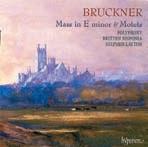 Tom Bell
Tom Bell
THE ENGLISH RACHMANINOV
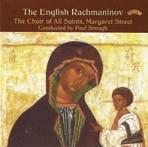
The Choir of All Saints, Margaret Street.
Director: Paul Brough. Mass in B flat; Evening Canticles in B flat; Benediction Hymns; Ave Maria; Hymn of the Cherubim; Vale Requiem Mass in D flat in commemoration of the faithful departed.
PRIORY PRCD 860 TT 68:44
The bulk of this programme consists of Rachmaninov sung in English – a tradition at All Saints, Margaret Street. Also featured is Dr Walter Vale’s rather touching Requiem. Vale was Director of Music at the church from 1907 until his death in 1939, and was responsible for the adaptation of the Mass in B flat that began the association between Rachmaninov’s music and All Saints. This is a very enjoyable recording of often beautiful music, sung with great sensitivity, colour and musicianship… (and did you know that one of Vale’s choristers was one Laurence Olivier?)
Tom Bell
Cathedral Music 53
P3 140 CM Nov 07 B:3302 Cathedral Music MAY #B5827 31/10/07 14:30 Page 53
TRINITY SUNDAY AT WESTMINSTER ABBEY
The Choir of Westminster Abbey.
Director: James O’Donnell.
Organ: Robert Quinney.
Tomkins Preces & Responses; Britten Te Deum in C; Walton Jubilate; Grier Missa Trinitatis Sanctae; Howells Westminster Service; Stainer I saw the Lord; Stanford Fantasia & Toccata in D min.
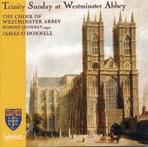
HYPERION CDA67557 TT 78:02
WILLIAM BYRD: THE GREAT SERVICE

The Choir of Westminster Abbey.
Director: James O’Donnell.
Organ: Robert Quinney.
O Lord, make thy servant Elizabeth; Great Service -Venite; Te Deum; Benedictus, Kyrie, Creed, Magnificat & Nunc Dimittis; Prevent us, O Lord; Voluntary for my Lady Nevell; How long shall mine enemies? Out of the deep; Fancy for my Lady Nevell; Christ rising again from the dead; Sing Joyfully.
HYPERION CDA67533 TT 76:15
These two splendid releases combine superb performances by both choir and organist with quite stunning presentation on Hyperion’s part. The cover pictures, and those inside the case, are almost as enjoyable as the music! Bravo! Highlights include magnificent performances of Walton’s Jubilate (tremendous drive), Howells’s Westminster Service and Francis Grier’s marvellous Missa Trinitatis Sanctae. I cannot single out any individual tracks from the Byrd disc because I enjoyed it all equally. Often recordings I receive for review are rapidly consigned to the back of a cupboard (or worse!) but I think I’ll have worn these out by the end of the year!
Tom Bell
GOMBERT: TRIBULATIO ET ANGUSTIA
Brabant Ensemble.
Director: Stephen Rice.
Hortus conclusus es; Aspice Domine; Ergone vitae; Ave sanctissima Maria; Ave Maria; Pater noster; Ne reminiscaris, Domine; Inviolata, integra, et casta es, Maria; Inviolata (chant); Virgo sancta Katherina.
HYPERION CDA67614 TT 66:05
This recording by the Brabant Ensemble is devoted entirely to works by Nicolas Gombert (c1495-c1560) from a single genre: the motet, which sets it apart from the majority of CDs, as they are often placed around the settings of the Mass. In their third recording from Hyperion, The Brabant Ensemble, directed by Stephen Rice, has produced a first-class piece of work with some moments of sheer musicality. The choir, on the whole, makes a very clear sound and each part sings the wonderful melismatic lines with musicality and intelligence. Although the quality of the sounds is excellent, it would benefit from a mixture of male and female altos, and it could do with a little more bass tone in parts.
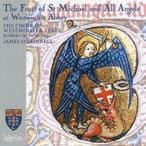
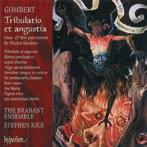 Matt Lennox
Matt Lennox
WESTMINSTER ABBEY: MICHAELMAS
The Choir of Westminster Abbey.
Director: James O’Donnell.
Organ: Robert Quinney.
Dering Factum est silentium; Leighton Preces and Responses; Psalm 148 Chant Stanford; Vaughan Williams Te Deum in G; Britten Jubilate in C; Langlais Messe Solennelle; Tippett Plebs angelica; Magnificat and Nunc dimittis ‘Collegium Sancti Johannis Cantabrigiense’; Psalm 91 Chant Alcock; Howells Sequence for St Michael; Harvey Laus Deo.
HYPERION CDA67643 TT 72:59
The Feast of St Michael and All Angels is a challenging and all encompassing repertoire that takes us from Mattins and Eucharist through to Evensong, from the 17th century to the mid-20th. As you would expect from one of the country’s most acclaimed choirs, the works are sung with passion, precision and energy, and the overall effect is highly satisfying. Highlights for me included Vaughan Williams’s Te Deum in G and all aspects of the Langlais Messe Solennelle. Recording in the superb setting of Westminster Abbey only adds to the atmosphere and quality of this CD.
Matt Lennox
JOSEPH JONGEN
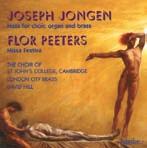
The Choir of St John’s College, Cambridge.
Director: David Hill.
Organ: Paul Provost.
Violin: Thomas Gould. London City Brass.
Jongen Messe en l’honneur du Saint – Sacrement;Deus Abraham; Pie Jesu; Quid sum miser; Peeters Missa Festiva.
HYPERION CDA67603 TT 72:50
What a refreshing change to find in the review pile of recordings one that features something a little different from the run-of-the-mill releases. This recording by St John’s College Choir and David Hill, one of the last before his departure, certainly caught my attention. Jongen’s Messe en l’honneur du Saint Sacrement was written in 1945 after a difficult period in his personal life and the Mass was due largely to the persuasion of his close friend Georges Alexis who, according to John Scott Whiteley’s informative programme notes, also suggested ideas for the Mass by directing Jongen’s attention to Gregorian themes from the propers of the Mass for Corpus Christi and to the choral works of Gabrielli, accounting, perhaps, for the unusual forces for the musical genre. Jongen’s music is fresh and approachable. The scoring for the forces is imaginative and exciting. David Hill succeeds in capturing every subtle nuance in the music’s wide-ranging moods. The Kyrie is flowing and lyrical, while the Gloria starts surprisingly quietly, but builds to an impressive climax at the words ‘laudamus te.’
The Credo is rhythmic and exhilarating. The Sanctus is heralded by a brass fanfare leading into a fugal section, just one example of much fine contrapuntal scoring. The Benedictus is quiet and flowing and features a semi-chorus for the first time in this Mass. The Agnus Dei is restrained and lyrical; here Jongen explores various combinations of the musical forces and special mention should be made of the exquisite treble sound in the second stanza of the Agnus Throughout, the singing is expressive and controlled, while the forces blend and complement each other admirably. Of the three motets on this recording, two are for funerals, taking as their texts words from the Requiem Mass. The third, Deus Abraham, was written for Jongen’s marriage to Valentine Ziane in 1909 and features a solo tenor and violin. Further solos from the choir are heard in the Pie Jesu and Quid sum miser? All three of these pieces are exquisitely crafted. Mention must be made of Alexander Robartes, the treble soloist in Pie Jesu (with its shades of Fauré) who sings with assured clarity and sensitivity. Peeters’s Missa Festiva provides an ideal contrast to the Jongen. The Gregorian Chant inspiration in this work, together with its modal character and organumstyle harmony, is clear from the outset. Peeters writes for the more traditional forces of organ and choir, but to great effect. The music explores a wide range of moods, but more obviously with liturgical use in mind; all movements are short enough to be used comfortably in a service, even the Credo, which at just over eight minutes, builds to an impressive conclusion. Paul Provost’s playing throughout is sensitive and assured. Highly recommended.
Jeffrey Williams
BAIRSTOW CHORAL MUSIC
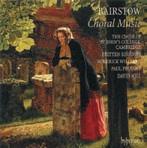
The Choir of St John’s College, Cambridge. Director: David Hill.
Organ: Paul Provost. The Britten Sinfonia.
Jesu, the very thought of Thee; Blessed city, heavenly Salem; Evening service in D; Lord, thou hast been our refuge; If the Lord had not helped me; Let all mortal flesh keep silence; Evening service in G; Five Poems of the Spirit; Save us, O Lord.
HYPERION CDA67497 TT 62:47
There is space (around 15 minutes worth) for more music on this full price CD and no shortage of works which might have been used to fill it. Bairstow is, of course, remembered for his 33 years as Organist of York Minster, which followed seven years each at Wigan and Leeds Parish Churches. Readers who want to learn more about the composer’s life than is told in Philip Moore’s excellent programme notes should search out a copy of Francis Jackson’s fascinating book Blessed City. This disc contains works from two distinct periods of English Church Music. The majority of the compositions performed here fall into the what we might term the ‘Edwardian’ period, but the Five Poems of the Spirit and the Evening Service in G are most definitely from a later period and show that although Bairstow was educated in the Victorian era, his compositional style continued to develop right up until the end of his 72-year life. This is especially true in the case of the two settings of the Evening Canticles. Whilst the setting in D is full of the confidence of a country which
Cathedral Music 54
P3 140 CM Nov 07 B:3302 Cathedral Music MAY #B5827 31/10/07 14:06 Page 54
controlled a large empire, the later setting in G reflects a nation which had embarked on a war with one of the most evil and influential regimes that the world has ever seen. We are told that the G major service was written as a response to a ‘boisterous setting of the canticles’ by H. K. Andrews, which Bairstow considered ‘foreign to the spirit of the words’.
Some of these works will be well known to those who regularly worship in Anglican cathedrals, but I suspect that fewer readers will have heard Lord Thou hast been our refuge or If the Lord had not helped me livein a service. The former was written in 1916 for the Festival of the Sons of the Clergy and sets words from Psalms 90, 102 and 144, whilst the latter, using words from Psalm 94, was written whilst Bairstow was at Leeds. In both cases, Bairstow’s wonderful ability to set music to words is the secret of the works’ success. The Five Poems of the Spirit, which date from 1943 and 1944 but were not performed until 1955, after Ernest Bullock had completed the orchestration, will be new to most readers of this magazine. Bairstow set five texts by 16th and 17th century poets selected by the then Dean of York, Eric Milner-White, to music using a variety of scoring. All five songs are beautiful and mirror the selected texts superbly. The scores of Bairstow’s choral works contain a large number of directions about tempi, dynamics and phrasing and it is to the performers’ credit that they perform these works in a way which so carefully follows and so faithfully reproduces the composers’ intentions. The Britten Sinfonia and Roderick Williams complement the high standards set by the choir in the church pieces. Earlier in the year, a national newspaper published a review of this recording, the gist of which was that it would only appeal to those who are interested in church music, or who would like to hear the Songs of the Spirit. The rest of the music (argued the reviewer) was unlikely to bring anyone to new-found faith and so there was little point in buying it. Hopefully, readers of this magazine are interested in church music and so will go out and buy it.
Tim Rogerson
MENDELSSOHN Sacred Choral Music
The Choir of St John’s College, Cambridge.
Director: David Hill. Organ: John Robinson. Treble: Quintin Beer. Tenor: Allan Clayton. Aus tiefer Not; Ave Maria; Mitten wir im Leben sind; Hör mein Bitten; Warum toben die Heiden Richte mich, Gott Zum Abendsegen; Kyrie eleison; Heilig, heilig ist Gott, der Herr Zebaoth; Ehre sei Gott in der Höhe; Verleih’ uns Frieden; O for the wings of a dove.
HYPERION CDA67558 TT 71:35
MENDELSSOHN Sacred Choral Music
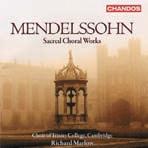
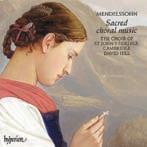
The Choir of Trinity College, Cambridge.
Director: Richard Marlow.
Sechs Sprüche für das Kirchenjahr; Hear my prayer; Beati mortui; Die deutsche Liturgie; Ave Maria; Der hundertste Psalm ‘Jauchzet dem Herrn alle Welt’; Laudate pueril Magnificat; Drei Psalmen.
CHANDOS CHAN 10363 TT 74:03
A recording from either of these two great choirs is always to be welcomed, and both these discs are extremely good. It is remarkable to have next-doorneighbours such as these tackling much the same repertoire, and the comparison is of absorbing interest. Trinity’s programme was recorded as long ago as 2000, though not issued until last year, and is suave, controlled and mellow, a fine example of Richard Marlow’s mature style; the choir of St John’s was recorded in 2005, and is a little more homespun and spontaneous, even a bit rough round the edges, with the countertenors especially showing signs of strain in music for which nature never intended them. Both discs contain the incomplete German Mass, some or all of the opus 78 psalm settings, Ave Maria, and the seemingly inevitable Hear my prayer, St John’s giving it complete in the decent obscurity of German and then O for the wings of a dove again in English as if to compound the offence, while Trinity gives it once, in English. Neither performance is especially wonderful, the St John’s treble being distinctly under the note for much of the time; and it is surely time that the ghastly English translation was buried once and for all. My heart is sorely pained within my breast and the like need to be left in the world of Victorian melodrama, along with Maria Martin and the red barn and the rest of its ilk. I declare Trinity’s offering the winner by a short head, as the singing is better and the programme slightly more interesting, including as it does some anthems for men’s voices and the English Magnificat, but there is much to admire in the rival disc also.
Timothy Storey
HANDEL
Music for the Chapel Royal
Choir of the Chapel Royal.
Musicians Extra-ordinary.
Director: Andrew Gant.
Let God arise; I will Magnify thee; As Pants the hart; O sing unto the Lord.
NAXOS 8.557935 TT 60:55
A sumptuous CD of Handel’s church music expertly sung by the choir for which it was originally intended. This work offers a wonderful blend of orchestral music and high quality choral singing, and the balance is mostly even although at times the orchestra overshadows. For me, it is always a pleasure to hear James Bowman: although his best years are behind him his voice still has a distinctive quality, and this is shown off to fine effect in Tears are my daily food; while thus they say, where is now thy God? from As Pants the hart All in all a pleasing and well-conducted CD.
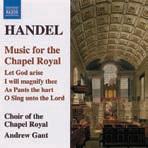 Matt Lennox
Matt Lennox
BRITISH CHURCH COMPOSER SERIES 9
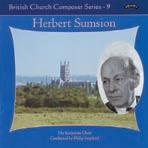
Herbert Sumsion
The Ecclesium Choir.
Director: Philip Stopford.
Organ: David Leigh.
Magnificat & Nunc Dimittis in G; Praise to the Lord; O
Lord, thou hast searched me out; The Lord ascendeth up on high; By the Cross of Jesus; The spacious firmament; There is a green hill far away; They that Go Down to the Sea in Ships; Communion Service in A and D; Fear not O land; I was glad; One thing have I desired; Festival Benedicite.
PRIORY PRCD 839 TT 78:12
The Ecclesium Choir was established in 2003 primarily for this recording. The recording was made in 2005 but has only now appeared for review. It is, as we might expect from the origins of the choir, lovingly made and there are some fine performances of the music of one of the giants of the 20th century cathedral music scene, notably, of some little known works. Philip Stopford became Director of Music at Belfast Cathedral in 2003 and there is a sort of Ulster connection with a paraphrase of St Patrick’s Breastplate by Mrs Alexander and another setting of words by her (There is a Greenhill). Apart from canticles there are a number of ‘occasional’ pieces which deserve to be more widely performed, in addition to the rightly popular They that Go Down to the Sea in Ships. Certainly, the craftmanship is of Harland and Wolf quality! The notes are dense (not least because of the constraints of the page format in CD booklets) and highly informative, but quite difficult to find one’s way around – spaces between paras and more highlighting would have helped. In particular, I found it a bit difficult to sort out the chronology. Partly because of this, I was left unclear as to the rationale of the programming, which for one (carping) critic was difficult to follow. For me, the disc doesn’t quite work as a ‘recital’ and after the first enthusiastic playing it may be better regarded as an archive of Sumsion’s major contribution to British church music.
It was interesting to learn from Allan Smith’s notes that Sumsion ‘did not care fore much of the church music around the 1930s, but tantalising to be told no names! When I first started reading record reviews in the 1960s, much space was always given to the quality of the recordings. Nowadays, this is taken for granted, and this excellent Priory CD is no exception. Ecclesium’s next CD is planned to be of music by Richard Shephard. It should be worth waiting for, though I hope the wait will be shorter on this occasion.
Richard Osmond
THE BETTER LAND GREAT BOY SOPRANOS Volume Six Recorded 1912-1970
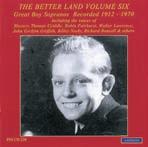
Featuring: Masters Thomas Griddle; Robin Fairhurst; Walter Lawrence; John Gwilym; Billy Neely; Richard Bonsall & others.
AMPHION PHICD220 TT 76:04
Stephen Beet’s single-handed and worthy crusade to preserve for future generations the vintage sounds of the solo boy treble voice continues with a further selection from Amphion recordings. The latest 22-track edition of The Better Land – Volume Six features 10 ‘new boys’ amongst the 16 soloists and covers a period from 1912 to 1970. The CD includes Walter Lawrence, one of the first boy sopranos to commit his voice to a wax recording on 23 August
Cathedral Music 55
P3 140 CM Nov 07 B:3302 Cathedral Music MAY #B5827 31/10/07 14:06 Page 55
1912 singing Villanelle (The Lark’s Song) and a highly charged rendition of Brother James Air with Michael Lamb singing verse 1 and John Evans-Pugh singing verse 2 together with the choristers of St Nicholas’ College, Chiselhurst, recorded in the Church of the Holy Sepulchre, Holborn, London, just three months before the Second World War was declared in 1939. Suffice it to say some of the items recorded, from traditional songs to Handelian arias, are characterised by vibrato singing but this is pure reflection of the time however, and sheer beauty of tone together with precise word enunciation and plenty of sustained lung power more than compensate. Furthermore, any rhythmic shortcomings are more often than not the result of some of the accompanists on instruments ranging from solo organ and piano to double string quartet and orchestra. A wholly sensible track sequence combined with successively contrasting items keep the listener continually engaged with all facets of each performance. Billy Neely’s ‘off-air’ recording from a 1949 programme of BBC’s Children’s Hour of Benjamin Britten’s A Tragic Story for example, contrasts beautifully with Bach’s Sheep may safely graze recorded by the Temple Church’s Head Boy, Robin Fairhurst, some five years later. The same artist, this time singing The Tailor and the Mouse unaccompanied, recorded from a live concert when he was sixteen years old, is one of four recordings here issued for the first time. Mention must be made of Richard Bonsall, New Zealand’s boy soprano and ‘TV personality’ of the late 1960s, here singing with supreme confidence and panache Santa Lucia with piano accompaniment in a 1970 recording. Finally the accompanying programme notes which provide not only a wealth of background information about a number of the artistes together with photographic sources, but articulated comments from Stephen Beet following his exhaustive research, provide a valuable insight into the lives of the boys set against the background of the changing times in which they lived, particularly the 1920s and 1930s. A thoroughly enjoyable and an historically valuable resource.
Michael Rowland
HANDEL Tobit (an Oratorio in three parts)
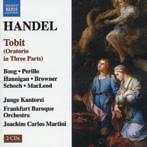
Junge Kantorei.
Frankfurt Baroque Orchestra.
Director: Joachim Carlos Martini.
NAXOS 8.570113-14 TT 2:36:22
Both the Junge Kantorei and the Frankfurt Baroque Orchestra specialise in the performance of Handel oratorios. Here we have an oratorio using the music of Handel, but compiled from original material after his death by John Christopher Smith with a libretto fitted to the music by Thomas Morello. There have also been additions to the scores by Joachim Martini, the conductor. If you are a devotee of lesser-known oratorios then you might consider buying this one out of curiosity. However, I have to confess that I found neither the music nor the performances inspiring. There were balance issues between the chorus and orchestra; Stephan MacLeod, the bass, was the best of the soloists in my book.
Jeffrey Williams
BRITISH COMPOSER SERIES 7
Noel Rawsthorne
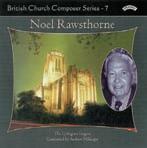
Most tracks all world premiere recordings.
The Collegiate Singers.
Director: Andrew Millinger.
Organ: Richard Moorhouse.
Christ is our cornerstone; Behold O God, our defender; The Liverpool Service; Sortie: Nun danket alle Gott; Psalm 150; Canticles in F major and D major; Like as the hart; The Blackburn Service; They that Go Down to the Sea; Eternal Father; The Chester Mass; The True Glory; Responses; O Praise God in his holiness.
PRIORY PRCD 837 TT 79:35
The distinguished Organist Emeritus of Liverpool’s Anglican cathedral composes in an attractive if not especially original style, his fondness for flattened sevenths and parallel triads bringing to mind the more folksy (and less subtle) characteristics of Vaughan Williams. We are presented with no fewer than three settings of the Eucharist, and it is interesting (and refreshing) that for all of them Dr Rawsthorne has found his inspiration in the Rite A/Common Worship text, the double-choir Sanctus of TheLiverpool Service being particularly striking. There are also two settings of the Evening Canticles and a selection of anthems, with the quieter and more reflective
offerings such as Like as the hart (included in OUP’s Ash Wednesday to Easter volume) more inventive and successful than the rather predictable jollity of some of the others. We could perhaps have done without Eucharistic Acclamations, Great Amens, Preces and Responses and other odds and ends of the liturgical repertoire, whose inclusion carries an otherwise laudable desire for completeness to rather ridiculous lengths. The performances by this very capable group of enthusiasts are for the most part excellent, apart from occasional shrillness (and sharp pitch) in the sopranos and some painfully wooden chanting of Psalm 150: ‘trumPET’ and ‘greatNESS’ are not what one expects from a choir of this calibre.
Timothy Storey
PERGOLESI: STABAT MATER
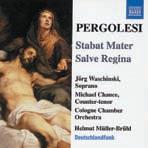
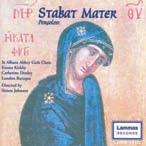
St Albans Abbey Girls’ Choir, with Emma Kirkby, Catherine Denley and London Baroque.
Director: Simon Johnson.
Hildegard of Bingen O Euchari; Lallouette O mysterium ineffabile; Charpentier Serve bone;Pulchra es; Dering O bone Jesu; Verrijt In nominee Jesu; Monteverdi Ut queant laxis; Confitebor terzo alla Francese
LAMMAS LAMM 184D TT 63:42
PERGOLESI
Cologne Chamber Orchestra.
Director: Helmut Müller-Brühl.
Soprano: Jörg Waschinski.
Counter-tenor: Michael Chance.
Stabat Mater; Salve Regina in C minor.
NAXOS 8.557447 TT 57:05
Pergolesi composed Stabat Mater on his deathbed, and what a wonderful work it is, well sung on both these discs. You should certainly buy one or the other, and of course the Naxos version, which contains also Pergolesi’s setting of Salve Regina for solo soprano, comes at a bargain price (about £5.99) and is only about seven minutes shorter than its rival. The Lammas recording allots some of the movements in Stabat Mater to the St Albans girls, who also contribute motets by Charpentier, Dering, Lallouette, Monteverdi and Verrijt, and are joined by Emma Kikby for Hildegard of Bingen and by both soloists for more Monteverdi. How privileged they are to sing such music in such company, and how well they sing it! For your reviewer, they tip the balance in favour of the Lammas version, it being a pretty equal contest otherwise as he gives his vote to Emma Kirkby and Michael Chance who are unfortunately not on the same disc. Perhaps the only solution is to be extravagant and buy both.
Timothy Storey
MUSIC FROM THE SISTINE CHAPEL
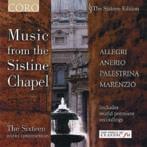
The Sixteen.
Director: Harry Christophers.
Anerio Ave regina caelorum a 8;Regina caeli leaetare a 8;Stabat Mater a 12; Magnificat secundi toni a 8; Palestrina ascendit dues a 5;Angelus Domini descendit a 5; Assumpta est Maria a 6; Allegri Christus resurgens ex mortuis; Missa ‘Che fa oggi il mio sole’; Marenzio Che fa oggi il mio sole. CORO COR16047 TT 67:49
The Sistine Chapel is invariably connected with two giant figures in church music, Palestrina and Allegri, both of whom are represented on this disc and for once the Miserere of Allegri refreshingly does not feature. However, there is another significant name that comes to the fore, that of the composer Anerio, the great achievement of whose life was to be appointed as official Papal composer on 3 April, 1594, on the death of Palestrina. He is represented on this disc by a number of compositions, the most substantial of which is the 12-part Stabat Mater with its use of massive vocal forces. With its control of harmony, rhythm and texture, interest and forward impulse never flag despite the length of the text. The Sixteen give a good performance of this piece, sometimes lack power and vitality, but overall the group bring their considerable experience together to present a wonderful selection of music form the Sistine Chapel.
Patrick Mayhew
Cathedral Music 56
P3 140 CM Nov 07 B:3302 Cathedral Music MAY #B5827 31/10/07 14:06 Page 56
WILLIAM BYRD LAUDIBUS IN SANCTIS
The Cardinall’s Musick.
Director: Andrew Carwood. Quis est homo? Tribulatio proxima est; Apparebit in finem; Salve sancta parens; Alleluia, Ave Maria… Virga Iesse; Beata es, virgo Maria; Beata vicera; Regina caeli; Salve regina; Fac cum servo tuo; Ecce quam bonum; In manus tuas, Domine; Unam petii a Domino; Vista quaesumus, Domine; Domine, exaudi orationem meam, inclina; Laudibus in sanctis.
HYPERION CDA67568 TT 69:45
Formed in 1989, The Cardinall’s Musick have established a reputation for the performance of music from Renaissance England. More recently the group has branched out and now perform music from a wide range of periods, styles and countries. On this recording we see them returning once more to their roots. It would have been easy to have recorded these pieces grouped together from their respective publications. However, considerable thought has gone into the order so as to produce a satisfying and varied musical programme. Three contrasting Cantiones Sacrae appear on the first three tracks: Quis est homo? Tribulatio proxima est and Apparebit in finem. These are then followed by the complete Propers for Lady Mass in Eastertide: Salve sancta parens for the Introit, Beata es, virgo Maria for the Offertory and Beata viscera for Communion.
The Gradual being replaced by the Ave Mariagratia plena and Virga Jesse, each preceded by Alleluias Regina caeli, a Marian Antiphon for Easter follows the Propers then Salve Regina, the Marian Antiphon for Trinity until Advent. Thus, the centrepiece of the recording provides us with a wonderful sequence of devotional, Marian music. The remaining tracks feature three more each of the Cantiones Sacrae and Gradualia with Laudibusin sanctis, Byrd’s paraphrase of Psalm 150, bringing the programme to a fitting conclusion. The music here is full of examples of Byrd’s compositional style, be it the seamless, melodic flow of his counterpoint, rhythmic vitality and syncopation in the livelier works, or his subtle use of word painting, leaving the listener in no doubt as to Byrd’s mastery of his craft. The music is sung one voice to a part and with varying combinations of singers from within the group. This achieves clarity of texture and variety of vocal timbre that offers an interesting contrast to some recordings of larger ensembles with multiple voices to each part and mellow vocal tone. The Propers for Lady Mass, though, are sung by the same singers throughout. The singing is relaxed and expressive, allowing the timeless quality of Byrd’s contrapuntal writing to shine through. The voices blend well for the most part, whilst retaining their own identity, though I found the occasional forced vibrato a little intrusive. The intimate nature of much of this music is helped by the one voice per part style, because, let us remember, Byrd wrote many of these pieces for private, devotional use rather than for grand liturgical performance as he continued to produce music for Catholic Rites at a time when such activities were forbidden.
Jeffrey Williams
CHORAL MUSIC BY NICHOLAS MAW
One foot in Eden still, I stand

Schola Cantorum of Oxford.
Director: Mark Shepherd.
Three Hymns; Five Epigrams; The Angel Gabriel; Our Lady’s Song; Balulalos; Corpus Christi Carol; Sweté Jesu; Five Irish Songs; One foot in Eden still. I stand.
HYPERION CDA67615 TT 58:04
If you have yet to discover the choral music of Nicholas Maw or have only heard it in passing then I encourage you to buy a copy of this recording and experience it for yourself. Here we have a selection of the composer’s output that covers a period of over 30 years. It was recorded in the wonderful acoustic of Exeter College Chapel in Oxford.
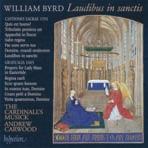

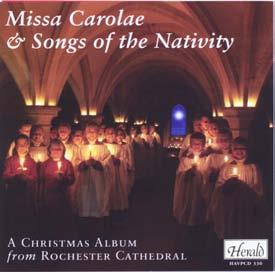
The programme opens with Three Hymns, written for the 1989 Lichfield Festival. These are very contrasting pieces; Morning Hymn is bold and confident while Pastoral Hymn is buoyant and lively. Evening Hymn, the longest of the three, is expressive and full of emotion. The vocal writing is exquisite and delivered with seemingly effortless ease by the Schola Cantorum of Oxford. In Jeremy Filsell’s capable hands Exeter College’s Walker Organ shows itself to excellent effect in its accompanimental role. Five Epigrams were written in 1961 for the London Scottish Choir. These five short pieces are unaccompanied. Burn’s texts provide ample opportunity for an imaginative

The Choirs of Rochester Cathedral with the Locke Brass Consort
Directed by Roger Sayer and Daniel Soper
Rochester Cathedral commissioned James Whitbourn’s Missa Carolae for the Midnight Eucharist on its 1400th anniversary. The work introduces a festival of seasonal music from Rochester.
HAVPCD 330
Music for Epiphany to Candlemas
The Choir of Winchester Cathedral
Director: Andrew Lumsden
Organist: Sarah Baldock
The Gospel narrative of Jesus Christ’s child hood and early ministry are the focus of the motets, anthems and organ pieces presented. There is Poulenc, Warlock, Howells & Holst with Messiaen and Duruflé organ works.
HAVPCD 333
CDs and Cassettes supplied to all good record shops and other outlets through the following distributors:
Herald AV Publications The Studio, 29 Alfred Road, FARNHAM, Surrey. GU9 8ND Tel: 01252 727718 Fax: 01252 735567 www.heraldav.co.uk Mail Order available from: RECORD CORNER LTD Pound Lane, GODALMING, Surrey, GU7 1BX. Tel: +44 (0)1483 422006 High Street Outlets Coda Distribution Limited Unit 4 Phoenix Court Hawkins Road Colchester Essex CO2 8JY Tel: +44 (0)1206 861332 Fax: +44 (0)1206 793074 Email: info@codadistribution.co.uk Religious & Heritage Outlets Griffin & Company Ltd 24 Church Lane East Peckham Kent TN12 5JH Tel: 01524 844399 Fax: 01524 844335
Cathedral Music 57
P3 140 CM Nov 07 B:3302 Cathedral Music MAY #B5827 31/10/07 14:06 Page 57
composer to write something different. Maw’s music captures the often coarse nature of the words superbly and the singers clearly revel in the vocal writing. Of the Five Carols, four were written in the 1960s and the last, Sweté Jesu, for King’s College Cambridge in 1992. As we approach the time when many choir directors will be turning their attention to music for the relentless run of Christmas concerts and carol service, anyone looking for something different would do well to dwell here. TheAngel Gabriel is given imaginative and refreshing treatment; the melody is woven into a web of vocal textures. Our Lady’s Song has a suitable medieval quality that reflects its 14th century text, while Balulalos gentle lullaby melody is interwoven into a texture of biting harmonic dissonance. Corpus ChristiCarol is a folk-like setting with piano accompaniment and subtle harmonic dissonance. Sweté Jesu is a beautiful, but technically challenging piece with complex harmonic shifts.
Five Irish Songs were written for the 1975 Cork International Festival. Maw chose Irish texts that would allow him to write music to capture a particular point or character. In I shall not die for thee and Dear dark head, he writes in a dissonant harmonic style, but always with an ear to the melodic line. Popular Song is lighter with a folk song influence, whereas Ringleted youth of my love returns to a gentle and more lyrical style. Jig is a rollicking conclusion that rejoices in the state of love as influenced by the change of seasons. One foot in Eden,still I stand was written in 1990 for the 500th anniversary of the founding of King College Cambridge. It is for tenor soloist, quartet and full choir. The writing is sumptuous and rich in texture, capturing the imagery of Edwin Muir’s text. The vocal forces are deployed very effectively and this is clearly the work of a composer at the height of his craft. The Schola Cantorum of Oxford sing with great sensitivity and assured technical ease. Mark Shepherd succeeds in coaxing every subtle nuance from his performers. For me, this recording is a real treat and I recommend it highly.
Jeffrey Williams
NOCTURNES
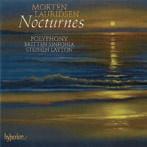
Morten Lauridsen
Polyphony.
Britten Sinfonia.
Director: Stephen Layton.
Mid-Winter Songs.Les Chansons des roses; Nocturnes.
HYPERION CDA67580 TT 65:17
Morten Lauridsen is an American composer and this is his second collaboration with Polyphony and Stephen Layton. The disc concentrates on the composer’s secular choral output, though it does include three sacred pieces. Mid-Winter Songs was written in 1983 and consists of five contrasting settings of the poems of Robert Graves. Lauridsen, we are told in Byron Adams’s sleeve notes, has made a lifelong study of Medieval and Renaissance music as well as plainsong. It is interesting to hear how Lauridsen has worked these influences into his individual and contemporary style. The music is approachable and is conceived melodically. It is clearly the work of a composer who understands and knows how to write for the voice. The orchestral scoring is sensitive and never overwhelms. Les chansons des roses dates from 1993 and are settings of five poems in French by the German poet Rainer Maria Rilke. The vocal writing here is exquisite and captures beautifully the poetic, rose-inspired imagery. Lauridsen’s music is rich in sonority, warm and lyrical. The singing and total control of Polyphony is quite simply stunning. The three sacred pieces stretch across a period of 35 years. I will lift up mine eyes with its organum and Medieval-inspired style dates from 1970 as does O come, let us sing unto the Lord , which is rhythmic and lively with an organ accompaniment in the capable hands of Andrew Lumsden. The piece would make a most worthy addition to any choir’s repertoire of music for festive occasions. Ave dulcissima Maria was written in 2005 and is for unaccompanied male voices. Here again, the influence of plainsong and organum is very evident. The music is gentle but builds most effectively to an impressive central climax. Nocturnes, from 2005 is a group of three poems set in contrasting musical styles, the first Sa nuit d’été and the last Sure on this shining night with piano accompaniment played by the composer. The middle song Soneto de la noche is unaccompanied. I have to confess to not having come across Lauridsen’s music before and reviewing this recording has been a real revelation. The combination of his musical style and the first-rate performances from Polyphony make this a real find. Highly recommended.
Jeffrey Williams
MUSIC FOR AN ABBEY’S YEAR III
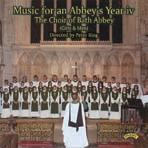
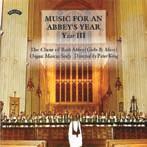
The Choir of Bath Abbey (Girls & Men).
Director: Peter King.
Organ: Marcus Sealy.
Wood Hail gladdening light; Fauré Cantique de Jean Racine; Mendelssohn Frohlocket ihr Völker;Kyrie; Harris Almighty and most merciful Father; Kirbye Vox in Rama; Ley A Prayer of King Henry VI; Purcell Remember not, Lord our offences; Parry There is an old belief; Szymanovski Fac me tecum; Sanders The Reproaches; Walford Davies O sons and daughters; Wesley O give thanks; Bruckner Virga Jesse; Brahms Geistliches Lied; Stanford Beati quorum via; Howells Te Deum Collegium Regale.
PRIORY PRCD 851 TT 70:34
MUSIC FOR AN ABBEY’S YEAR IV
The Choir of Bath Abbey (Girls & Men).
Director: Peter King.
Organ: Marcus Sealy.
Wesley Ascribe unto the Lord; Poulenc O magnum mysterium; Mendelssohn Hear my Prayer; Drayton Ecce ancilla Domini; Elgar Ave Verum; Blow Salvator mundi; Philips Ecce vicit Leo; Gibbons O clap your hands; Ives Listen sweet dove; Messiaen O sacrum convivium; Wood Expectans expectavi; Pärt The Beatitudes; Bruckner Os justi; Bairstow Lord, I call upon thee.
PRIORY PRCD 861 TT 77:03
Bath Abbey’s girls sing with a bright, forward tone, and are ably supported by a youthful-sounding back row. The standard of singing is commendably high, with admirable tuning and ensemble, though I preferred the girls’ quality on the earlier of these two discs. The whole project has been cleverly devised to construct a musical progress from Advent onwards, and is a fair cross-section of the present-day core repertoire, only the 18th century failing to be included; one or two ‘Lichfield specials’ from his days as Assistant Organist there have followed Peter King to Bath, such as Harris’s atmospheric setting of Dr Johnson’s last prayer, and Fac me tecum from Szymanovski’s Stabat Mater. I only wish that Cantique de Jean Racine had been given a miss (would anyone spare it a second glance if it were not by Fauré?), and I wish it were not regarded as essential to include Mendelssohn’s Hear my prayer in choral anthologies as I have had to sit through no fewer than four versions in the current batch of reviews. That apart, these two recordings have given me great pleasure, and I recommend them warmly.
Timothy Storey
ADONAI
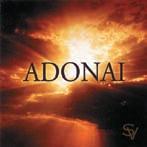
Sarum Voices.
Director: Benjamin Lamb. Bernstein Chichester Psalms; Janácek Lord’s Prayer; Britten Missa brevis; Lamb Missa brevis. VIF RECORDS VRCD 055 TT 66:09
This recording was made in 2006 in Christchurch
Priory where Catherine Lamb was until recently Assistant Director of Music, whilst her husband, Ben Lamb, was Organist at St Peter’s Church, Bournemouth. Following Catherine’s appointment to Lichfield Cathedral in the summer of 2007, they have both relinquished these posts. Sarum Voices is a choir formed by Ben Lamb and for this recording consisted of 11 sopranos, five contraltos, seven tenors and five basses. The programme of 20th century works offered on this disc is immediately appealing and consists of three works, which are all unique in their own way, coupled with the conductor’s own unaccompanied Mass setting. Bernstein’s Chichester Psalms were composed for the 1965 Southern Cathedrals Festival and use an accompaniment of harp, percussion and organ. The setting of the Lord’s Prayer by Janácek was written in response to his wife’s seeing a review of a set of eight paintings, which had been displayed at the 1899 Warsaw exhibition and which were based on the words of the Lord’s Prayer. It requires an accompaniment of harp and organ. Britten’s Missa Brevis was written for George Malcolm and the boys of the Choir of Westminster Cathedral. It is scored for three upper voice parts and organ. Ben Lamb’s own setting is scored for unaccompanied four-part choir. Sarum Voices sing this demanding programme with apparent ease. The only slight disappointment concerned the balance, as there were several occasions when I felt that the organ was not loud enough, especially in the Britten, whilst in Ben Lamb’s Mass, the soprano and tenor parts seemed to dominate. This did not spoil my enjoyment of the latter work, however, which deserves a wider audience. I enjoyed this recording very much and can recommend it.
Tim Rogerson
Cathedral Music 58
P3 140 CM Nov 07 B:3302 Cathedral Music MAY #B5827 31/10/07 14:06 Page 58
CELTIC INSPIRATIONS
The Choirs of Belfast Cathedral.
Director: Philip Stopford.
Organ: Ian Barber.
Stopford Be thou my vision;Belfast Centenary Eucharist; Thiman Draw nigh and take the body; Stanford As now the sun’s declining rays; St Patrick’s Breastplate; Wood Expectans Expectavi; Vaughan Williams Who are we who stand and sing? Grindle Psalm 23; Rutter A Prayer of St Patrick; Irish trad Melody Ni a losa, im chroise; Moore Irish Blessing.
PRIORY PRCD 826 TT 65:57
Some very good work is being done at Belfast, with both Youth (mixed) and Cathedral (all-male) choirs heard separately and together. The singing is of a high standard, apart from the boys’ tendency to sing under the note (why is this such a common failing nowadays?), and there are some good soloists. I just wonder whether there is sufficient real musical interest in a programme such as this; Charles Wood’s Expectans expectavi stands out as an oasis of ‘proper’ music, like a good deed in a naughty world, the rest of the disc being an assemblage of hymns, folk melodies and ‘popular classics’ including the appalling You raise me up (or ‘yerp’) popularised by Westlife; and the Holy Flute makes its inevitable appearance. It is all somewhat like dining on marshmallow, nice at the time but ultimately unsatisfying: but don’t let a grumpy old fogey like me put you off if that’s precisely what you like, for it is all very well done here.
Timothy Storey
VENI, SANCTE SPIRITUS Choral and organ music of Patrick Gowers
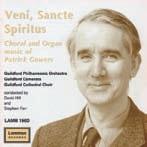
Guildford Cathedral Choir. Guildford Philharmonic Orchestra. Guildford Camerata.
Directors: David Hill and Stephen Farr.
Organ: David Davies and Stephen Farr.
Veni, Sancte Spiritus; Cantata; Adagio; Chester Lullaby; Toccata; Fugue; Libera Me; An Occasional Trumpet Voluntary.
LAMMAS LAMM 196D TT 69:48
Patrick Gowers has enjoyed a varied career in music as composition lecturer, jazz critic, conductor and composer, especially of film music. This CD concentrates on his church music and presents a selection of his output which displays his versatility and sure touch.
The most substantial work, the Cantata, written for the Southern Cathedrals Festival in 1991, sets, with great subtlety, texts from the Psalms by Coverdale and Mary Herbert and her brother, Sir Philip Sydney. The scoring is for three choirs, organ and orchestra. Of the shorter choral pieces, the lively Veni, Sancte Spiritus is based on two Rouen melodies and Chester Lullaby and LiberaMe are evocative settings of familiar texts. Stephen Farr gives assured performances of the organ solos, especially Toccata and An Occasional Trumpet Voluntary (in which one listens in vain for a solo trumpet!). The conducting is shared between David Hill and Stephen Farr, and David Davies accompanies Guildford Cathedral Choir. Programme and recording are nicely balanced and the ambience of the Guildford acoustic is well captured.
Alan Spedding
HOWELLS CHORAL WORKS
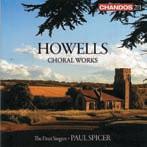
The Finzi Singers.
Director: Paul Spicer.
Te Deum (St Mary Redcliffe); Even such is the time; The summer is coming; The house of the mind; Two Madrigals; Salve Regina; Mass in the Dorian Mode; God is gone up; Three Carol Anthems; Sweetest of Sweets; Haec Dies; Regina Coeli; Long, long ago; A Sequence for St Michael; Antiphon; Requiem; Take Him, Earth, for Cherishing; Thee will I Love.
CHANDOS 2-DISC SET. CHAN 241-34 CD1 TT 79:25 CD2 TT 79:47
Recordings dating from 1992, 1993 and 1996 have been assembled to make this comprehensive and fascinating anthology. There are the early, student works such as the Latin motets and the Mass in the Dorian Mode which Howells composed for Westminster Cathedral; there are two of the unaccompanied settings of Herbert and Newton dating from 1977, and as the liner-note so aptly puts it, ‘comparing these later works with the Latin church music written fully sixty years earlier gives a vivid sense of Howells’s life journey, spiritual and musical’. There are many delights for the listener along this
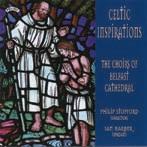
journey, not the least being a couple of madrigals from 1915 and 1918; but in general the easy, popular and accessible Howells of Collegium Regale and Like as the hart is eschewed, the only canticle setting being the St Mary Redcliffe Te Deum which is far from easy either for listener or performer. In fact this excellent choir is at its best in the most demanding music, the familiar A spotless rose and its two companion settings being rendered in a curiously perfunctory manner; but the discerning listener will be thankful for this chance to sample so many wonderful but relatively unknown works.
Timothy Storey
HEAVENLY HARMONIES
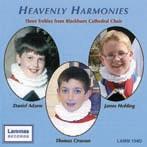
Three trebles from Blackburn Cathedral. Daniel Adams, James Holding and Thomas Croxson, accompanied by Richard Tanner with organ interludes played by Greg Morris.
LAMMAS LAMM 194D TT 72:44
This is a thoroughly delightful disc, definitely a cut above the usual standard of such offerings, with not a dove (or, rather, its wings) anywhere in sight. What a pleasure to hear such welltrained boys, and how they must have enjoyed learning and performing this programme of British and continental works from the 17th and 18th centuries. It was recorded in 2002 and 2004, so it is already something of an historical document. Of the three singers, James Holding was then at the glorious height of his powers: he takes the lion’s share of the work, displaying impressive control and generally excellent intonation, though he struggles a little with Et exultavit from Bach’s Magnificat, a cruel test for any soloist. The singing of other two, Daniel Adams and Thomas Croxon, is fresher but a little less polished, though no less enjoyable. Perhaps The sorrows of my heart are enlarged (Boyce, from Turn thee unto me) would have been better than For man walketh in a vain shadow (Greene, from Lord, let me know mine end), which is too short to stand on its own; but otherwise one is full of admiration for the invention and scholarship evident in the planning of this anthology. Strongly recommended.
Timothy Storey
LET US LIFT UP OUR HEART: 19TH CENTURY CHURCH MUSIC
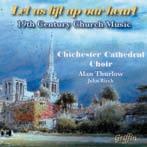
Chichester Cathedral Choir.
Conductors: Alan Thurlow and John Birch. Organists: Jeremy Suter and Ian Fox. GRIFFIN. GCCD 4059 TT 71:04
This is a conflation of no fewer than three old Abbey recordings which have somehow escaped the Priory series of re-issues. The liner-notes are an awful muddle, and cannot decide who is doing what on which recording; what we actually have is (a) Remember, O Lord (Walmisley) and Cast me not away (S S Wesley) from a 1970s recording directed by John Birch, characteristically smooth and restrained for the most part but with moments of great power and intensity; (b) How beautiful upon the mountains (Stainer) from early 1981, Alan Thurlow’s very first recording and still very much the Birch sound; and (c) the entire contents of a 1984 recording of Goss, Ouseley, Smart, Stainer and S. S. Wesley, a vintage time for the choir, when the boys’ sound had become brighter but the blend, ensemble and tuning were as good as ever. The Walmisley anthem is an exceptionally fine piece, very well performed; the highlight of the 1984 items, and perhaps of the whole disc, is Henry Smart’s Magnificat and Nunc Dimittis in G, each canticle set in one great continuous movement, with trebles divided thoughout and at one point in the Magnificat further divided into four parts. Get this excellent re-issue without fail; if the final Gloria Patri of Smart in G does not thrill you, nothing will!
Timothy Storey
BRAHMS Ein Deutsches Requiem

Gestliches Lied
Vasari Singers.
Director: Jeremy Backhouse.
Soprano: Claire Seaton.
Baritone: Colin Campbell.
Piano Duet: Jeremy Filsell & Roderick Chadwick.
GUILD GMCD 7302 TT 64:39
Brahms himself arranged the German Requiem for piano duet, so that amateur music-makers could get to know the work at home, and this version was used in the (private) first performance of the work in England, on 7 July, 1871. The accompaniment of Geistliches Lied may also be played on the piano, three or four hands. So it’s officially all right to perform the music in this form, but
Cathedral Music 59 P3 140 CM Nov 07 B:3302 Cathedral Music MAY #B5827 31/10/07 14:06 Page 59
nevertheless one’s initial reaction is of having stumbled upon a choir practice, a reaction reinforced by a certain rehearsal-room quality in the sound of the piano used for this recording. The listener should be patient; one is soon won over by the excellence of the singing, both choral and solo, and by the clarity, intimacy and flexibility of the accompaniment; the fugal passages in the third and sixth movements come over with especial success and the more intimate moments take on almost the quality of a very fine performance of lieder, such is the rapport between the singers and our distinguished pianists. This version is strongly recommended as a lean, fit and highly musical interpretation with vividly projected choral singing, the generally brisk tempi making it for singer and audience alike less of an endurance test than is sometimes the case.
Timothy Storey
STAR OF THE EAST
Music for Epiphany to Candlemas
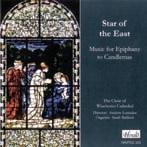
Wishart Alleluya, A new work is come on hand; Edwards No small wonder; Poulenc Quem vidisitis pastores; Videntes stellam; Mendelssohn When Jesus our Lord; Warlock Bethlehem Down;Benedicamus
Domino; Duruflé Prélude sur I’Introït de I’Épiphanie; Howells Here is the Little Door; Eccard When to the Temple Mary went; Langlais Incantation pour un Jour Saint; Handl Omnes de Saba venient; Surplice Brightest and best; Messiaen Les Bergers;Les Mages (La Nativité); Whitacre Lux aurumque; Holst Nunc Dimittis.
The Choir of Winchester Cathedral.
Director: Andrew Lumsden.
Organist: Sarah Baldock.
HERALD HAVPCD 333 TT 69:12
The latest CD from Winchester is subtitled Music for Epiphany to Candlemas (though at least two items are really left-overs from Christmas). The performances are top-notch, but the programme would not, on the whole have been my first choice. Having said that, I am glad I had to play (and indeed buy) this CD and my recommendation to get it is, with one possible doubt, unreserved. However, if what you want is a more ‘trad’ wallow you may be better served by the St Paul’s disc on the Hyperion label. Winchester has a tradition of pushing out the frontiers and refreshing the repertoire and you will find a number of unexpected treasures. No Small Wonder by Paul Edwards is already becoming deservedly well-known and Peter Warlock’s arrangement for solo voice(s) of his well-known Bethlehem Down is a show stopper even if his harmonic progression is more tortuous than the journey of the magi themselves. The excellent programme notes by John McCaffry tell us that Messiaen depicts camels in the pedal part of Les Mages, even if it seems to me that he conjures up T S Eliot’s description of them as ‘stubborn and refractory’. This is one of the several French organ interludes in the programme. Indeed, there is quite a French flavour to the disc, with two superb Poulenc motets. Other relatively less well-known pieces include Here is the Little Door by Howells, incomparable in execution as well as conception and the piece by Peter Wishart with which the recital opens. Epiphany has always struck me as the most parable-like of our major festivals (as well as one of the more undervalued). This programme seeks to conjure up the impression of ‘epiphany’ (though I thought that Eric Whitacre’s Lux aurumque degenerated into amorphousness rather than impressionism. If Epiphany is undervalued so is the Nunc dimittis despite its stunning theology; too often just a pendant to a more elaborate Magnificat. The setting by Holst concludes this recital It lacks more frequent performances just because it stands alone. Traditionalists will revel in the Mendelssohn but overall my advice is to go and get yourselves a new personal Epiphany with this outstanding disc.
CD Reviews
Richard Osmond
CHORAL & ORGAN REISSUES
PRIORY CHORAL MUSIC FROM…
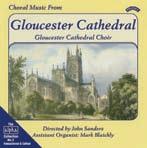
ALPHA COLLECTION No A
Liverpool Cathedral Choir.
Director: Ronald Woan.
Organ: Noel Rawsthorne.
Brahms How lovely is thy dwelling place; Tallis If ye love me; Bach Recitative & Chorale; Content am I to leave the (Cantata 95); Zion hears the watchmen’s voices; Jesu Joy; Mundy O Lord the maker; Stanford Magnificat in G; Mudd Let thy merciful ears; Wesley Blessed be
the God; Bourgeois Dark’ning night the land doth cover; RVW Te Deum in G.
PRIORY PRAB 100 TT 48:54
ALPHA COLLECTION No 2
Lincoln Cathedral Choir.

Director: Philip Marshall.
Organ: Roger Bryan. Sumsion Evening Service in A;They that go down to the sea; Singleton I will lay me down and take my rest; Pasfield Grieve not the Holy Spirit of God; Fisher Ave Regina caelorum (Introit and Litanie); Morley Out of the deep; Psalms 101 & 150; Byrd Exsurge Dominie; Marshall Firmly I believe and truly; Howells Take him, earth for cherising.
PRIORY PRAB 101 TT 51:04
ALPHA COLLECTION No 3
Gloucester Cathedral Choir.
Director: John Sanders.
Organ: Mark Blatchly.
Parry arr Sanders Dear Lord and Father; Bax This Worldes Joie; Wesley O Lord my God;Praise the Lord O my Soul; Brahms Three Festival Motets; RVW arr Sanders Come down, O Love divine; Howells Gloucester Service.
PRIORY PRAB 102 TT 53:57
ALPHA COLLECTION No 5
Liverpool Cathedral Choir.


Director: Ronald Woan.
Organ: Noel Rawsthorne & Ian Tracey. Alan Williams Communion Service; RVW Old 100th; Ouseley O Saviour of the World; Roxburgh A Passiontide Carol; Lotti Crucifixus; Battishill O Lord look down from Heaven; Ley The Strife is o’er; Horsley There is a green hill; Pratt Agnus Dei; Rawsthorne Psalm 130; Farrant Call to Remembrance; Victoria O all ye that pass by; Moore Communion Service.
PRIORY PRAB 104 TT 53:18
ALPHA COLLECTION No 6
York Minster Choir.

Director: Francis Jackson.
Organ: Geoffrey Coffin. Byrd Miserere mei; Walford Davies Magdalen at Michael’s Gate; Gray What are these that glow from afar; Jackson Benedicite;Blow ye the trumpet; Leighton Second Service; Tallis In manus tuas; RVW Prayer to the Father in heaven.
PRIORY PRAB 105 TT 50:31
Be sure to buy these bargain price re-issued recordings, and hear how well cathedral choristers sang a quarter of a century (and more) ago. In all of them one is struck by the sheer beauty and impeccable intonation of the boys’ singing, with no hint of the depressing flatness so common nowadays, even if at times the men can most charitably be described as doing the best they can. The late and much-lamented Harry Mudd and his Abbey recording company seem to have been determined to capture the special musical character of each cathedral’s choir, so we have music by present and former organists (Byrd at Lincoln, Jackson at York, Rawsthorne at Liverpool and S S Wesley at Gloucester), or music written specially for the choir or which was a special favourite in the local repertoire. It is apparent that in some places a special effort was made with music that taxed the performers to the limit (Bax’s This world’s joie at Gloucester, the Howells Motet on the death of President Kennedy at Lincoln and Leighton’s Second Service at York, hot off the press and learnt in great haste for the recording). Performances are never less than adequate, and at best can thrill and move the listener. For example, Lincoln offers psalm singing of great distinction, a rousing account of Sumsion’s They that go down to the sea in ships and a polished and exquisite Out of the deep (Morley): Gloucester produces, in addition to the S. S. Wesley already mentioned, some very good Brahms and, naturally, a stunning performance of Howells’s Gloucester Service; while York delights us not only with Dr Jackson’s Benedicite and Blow ye the trumpet in Sion, but also with a sensitive account of Magdalen at Michael’s Gate (Walford Davies), for many years a favourite in the York repertoire, and some vivid sounds from choir
Cathedral Music 60
P3 140 CM Nov 07 B:3302 Cathedral Music MAY #B5827 31/10/07 14:06 Page 60
and organ alike (including the famous Tuba Mirabilis) in that stirring anthem What are these that glow from afar? by Alan Gray, Organist of Trinity College, Cambridge, who came from a distinguished York legal family. Only the Liverpool recordings let the side down, with dull, sluggish and occasionally quirky performances of generally undemanding music and some surprisingly reticent organ accompaniments: it is noteworthy that the choir’s second disc contains excerpts from no fewer than three Communion Services.
Timothy Storey
CD Reviews
ORLANDO GIBBONS
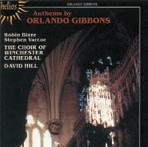
HELIOS REISSUES
Anthems and Verse Anthems
The Choir of Winchester Cathedral.
Director: David Hill.
Countertenor: Robin Blaze.
Baritone: Stephen Varcoe.
Hosanna to the son of David; Sing unto the Lord; This is the record of John; If ye be risen again with Christ; O Lord, in thy wrath; Second Evening Service; Behold, thou hast made my days; O God, the King of Glory; Glorious and powerful God; Fantasia in A minor (organ solo); O clap your hands; Thou God of wisdom; Blessed are all they that fear the Lord; Great King of Gods.
HELIOS CDH55228 TT 72:31
As you would expect, one word would suffice to sum up this reissue: exemplary. David Hill’s reputation goes before him and here we have a CD of music from the very heart of the English church sung with warmth, vitality and energy – quite perfect. The pedigree is first-class, especially from the two soloists who interconnect with the choir superbly; Robin Blaze’s contribution is exceptionally good. Hyperion’s decision to reissue these recordings (this one made in 1999) has to be commended because the performances are quite simply terrific.
Andrew Palmer
BRITTEN
Corydon Singers. Westminster Cathedral Choristers. (David Hill Master of Music).
Director: Matthew Best.
Organ: Thomas Trotter.
A Boy was born; Festival Te Deum; Rejoice in the Lamb; A wedding Anthem.
HELIOS (HYPERION) CDH55307 TT 66:12
SCHÜTZ:
THE CHRISTMAS STORY & Christmas Motets
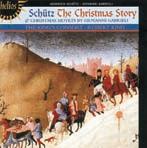 By Giovanni Gabrieli
By Giovanni Gabrieli
The King’s Consort.
Director: Robert King.
HELIOS (HYPERION) CDH55310 TT 57:01
DAQUIN: DOUZE NOËLS
Christopher Herrick plays the organ of St Rémy de Dieppe
HELIOS (HYPERION) CDH55319 TT 65:19
These three releases are superb. Robert King’s contribution lives up to his high standards with a delightful narration of the familiar Christmas story.
Christopher Herrick has made a good choice for instrument on which to record the Douze Noëls, and displays his usual rhythmic playing, full of energy –described by BBC Music Magazine ‘irrepressible jeu d’esprit ’. The Westminster boys are on top form in the Britten where their voices are the perfect match for singing his music. This is a fantastic Corydon Singers CD under Matthew Best’s direction –a winner. These three releases are full of warmth and have been re- released as being the best of Hyperion’s back catalogue and they are just divine. Add them to your collection, you will not be disappointed.
Graham Hermon.
CD Reviews CHRISTMAS
CHRISTMAS FROM WELLS
The Choir of Wells Cathedral. Director: Matthew Owens. Organ: David Bednall. Walker The Lord of all; Rutter Mary’s Lullaby;Wild Wood Carol;Christmas Lullaby; Shepherd’s Pipe Carol; Tavener The Lamb; God is with us; Trad Ding dong!; Twelve Days of Christmas; Edwards No small wonder; Lauridsen O magnum mysterium; Rachmaninov Bogoroditse devo; Leighton O leave your sheep; Athanasiadis Antiphon to Mary; Sandström Der är en ros utsprungen; Martin/Blane Have yourself a merry little Christmas; Edmundsen ToccataPrelude: ‘Von Himmel hoch’.
REGENT REGCD260 TT 73:30
Great singing as ever from this wonderful choir. Sensitively sung, excellent choice of repertoire; a few familiar items interspersed with gems such as Lauridsen and Edwards to make a pleasing addition to the Christmas CD catalogues. A good buy.

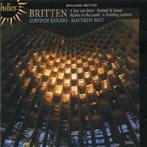 Ian Morgan
Ian Morgan
THOU EVER BLESSED MORN
Christmas at St Philip’s
The Cathedral Choir & Schola.
The Cathedral of St Philip, Atlanta, GA.
Canon for Music: Bruce Neswick; Associate Organist/Choirmaster: David Fishburn.
Ding Dong! Merrily on high; Beaudrot A Mary’s Hiding; Carter A Maiden most gentle; Terry Myn Lyking; Purvis Carol Prelude on ‘Greensleeves’; Pastorale on Forest Green; Stanford Magnificat in G; See amid the winter’s snow; Neswick People
Look East; Improvisation on ‘God rest you Merry, Gentlemen’; Lo, How a Rose e’er Blooming; MacKinnon Sleeps Judea Fair; Joubert Torches; Kirkpatrick Away in a manager; Arr Willcocks Sussex Carol; Polish Carol Infant Holy, Infant Lowly; Trad God rest you merry, Gentlemen; Angels; We have heard on high; Silent Night; Woodman Partita on ‘Lo, How a Rose e’er blooming’; Poston Jesus Christ the Apple Tree; Ore Variations on ‘Angels we have heard on high’.
St Philip’s Cathedral in Atlanta has a large SATB choir, which incorporates a smaller group called Schola, and an ample acoustic. Here we have a selection of Christmas favourites with one or two new items as well, most notably Sleeps Judea Fair, a delightful and charming piece by Hugh MacKinnon, interspersed with organ solos. The singing is dedicated and enthusiastic with attention to musical detail. The result is a very creditable recording, though I have reservations about some of the tempi. It is good to hear Stanford’s Magnificat in G getting an outing, even if the performance is a little too sentimental for my taste. This is an ‘in-house’ production and is only available, presumably, from St Philip’s Cathedral.
Jeffrey Williams
MISSA CAROLAE & SONGS OF THE NATIVITY
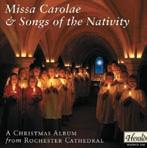
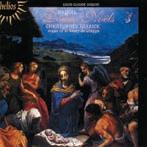
A Christmas Album from Rochester Cathedral
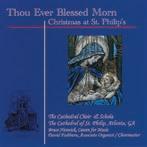
The Choirs of Rochester Cathedral. Directors: Roger Sayer and Daniel Soper. Locke Brass Consort.
Piccolo: Lesley Pocknell. Percussion: Joby Burgess & Catherine Ring.
Piano: Roger Sayer. Organ: Daniel Soper, Charles Andrews.
Whitbourn Missa Carolae Mass on Christams carols; Chilcott The Lily and the Rose; Dyke Three Kings; Clucas In the Dark-time; Archer The Holly and the Ivy; King Is the little King sleeping?; Mathias A babe is born; arr Lloyd St Joseph’s Carol; arr Rose People look east; Dove I am the day; Duruflé Toccata;Prélude sur I’Introit de I’Éiphanie.
HERALD HAVCPD 330 TT
This CD contains a refreshing change from the usual fare of Christmas
Cathedral Music 61
P3 140 CM Nov 07 B:3302 Cathedral Music MAY #B5827 31/10/07 14:06 Page 61
music. Here we have a quite wonderful arrangement of European carols put together in the form of a Mass by James Whitbourn, whose skill in taking the famous melodies and weaving them into a Mass to be used at different parts of the cathedral is sublime. The Kyrie uses Noël Nouvelet; the Gloria Es ist ein Ros’ entsprungen and God rest ye with the Sanctus being formed by In ducli jubilo and in the Agnus Dei, Infant Holy is borrowed. This CD would be welcomed by anyone looking for something different and yet containing all the elements needed to make Christmas special. The remainder of this CD is taken up with miniatures all beautifully sung and accompanied by the cathedral choirs. One niggle is that immediately following the superb Mass we are jolted back to earth by the juxtaposition of a piano-accompanied piece. Nothing wrong with the lovely composition by Chilcott but it somehow moves from the ethereal to the sentimental. Never mind this, if you buy this lovely CD then money goes towards the Rochester Cathedral Music Forever Fund.
Patrick Mayhew
CHRISTMAS ORGAN MUSIC
Daniel Hyde plays the Organ of King’s College, Cambridge.
Bach Sinfonia to Cantata 29 (arr. Dupré), In dulci jubilo (BWV 720), Pastorella (BWV 590),Von Himmel hoch, da komm’ ich her (BWV 700, 701, 738), Wir Christenleut’ (BWV 710); Brahms Es ist ein Ros’ entsprungen; Guilmant Offertoire sur Deux Nöels; Handel For unto us a child is born (arr. Best); Ireland
The Holy Boy; Karg-Elert Chorale Improvisation on ‘In dulci jubilo’ (op. 75, no. 2); Reger Weihnachten (op. 145, no. 3); Sattler Pastorale über ‘Joseph, lieber Joseph mein’ und ‘Stille Nacht’; Widor Final (6ème Symphonie).
PRIORY PRCD 884 TT 79:11
Daniel Hyde’s first solo recording is a fantastic achievement. Ranging from the very familiar to the very unfamiliar (Sattler was a completely new name to me), the selection of pieces is wide and well chosen. With the exception of one microscopic moment of rhythmic unevenness, the playing is impeccable. The registrations are stylishly chosen, and show off the resources of the King’s organ. The Bach Chorale Preludes are well known, but the Pastorella is not so familiar. There are four movements, all except the second in 6/8 time. The first has a drone bass, the second a suitably shepherd-like melody played on a 4’ flute. The melody of the third has a plaintive quality, and the fourth is a gigue. The well-known Bach Fantasia on In dulci jubilo is here, and it makes an interesting comparison with Karg-Elert’s rather chromatic Improvisation on the same melody. Carl Sattler was an organist in Cologne at the start of the 20th century, and his Pastorale weaves together the melodies of Joseph, dearest Joseph mine and Silent Night. In the Guilmant Offertoire sur Deux Nöels (one of which is Adeste Fidelis), the resources of the King’s organ are successfully used to create a Cavaillé-Coll sound – a vox humana being cunningly created using the Solo cor anglais together with the Swell 4’ flute. The booklet is exceptionally well produced. Daniel Hyde’s article is both informative and lively containing details of the composers and descriptions of the music. The history and specification of the organ are given, and there is biographical information about Daniel Hyde. The pictures are well chosen – they are of King’s College chapel, the organ console, and a spectacular shot of the College interior showing the organ case and the fan vaulting in great detail. And there is a most romantic one of Dan in appropriate winter clothing. (There is one small spelling error.) Order the CD now, and play it during Christmas Day lunch.
David Knight
NOËL NOUVELET
A uniquely fresh mix of new and favourite Christmas carols.
Mendelssohn Frohlokket ihr Völer auf Erden; Head
The Little Road to Bethlehem; Chilcott Shepherd’s Carol; arr Rutter Quem pastores laudevere; Rutter
Mary’s Lullaby; Leighton Coventry Carol; Rathbone
Corpus Christi Carol; Weir Illuminare Jerusalem; Lauridsen O magnum mysterium; Hakim Ding dong! Merrily on high; Clucas Love came down at Christmas; Edwards No small wonder; Gruber arr Rathbone Silent Night;
Gardner Tomorrow shall be my dancing day; arr Short Away in a manger; arr Sargent Hawaiian Lullaby; Tormé arr Ward Swingle Christmas Song; Arr Carter The Twelve Days of Christmas. Vasari Singers.
Director: Jeremy Backhouse.
Organ: Jeremy FIlsell.
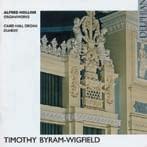
GUILD GMCD 7314 TT 60:06
Well this CD certainly does what it says on the label - present a uniquely fresh mix of new and favourite Christmas carols. The excellent Vasari Singers open their Christmas programme with an a cappella Mendelssohn motet where the ensemble is crisp and resonant. The sopranos and altos are on good form contributing much to this disc. Lauridsen’s powerful O magnum mysterium is one of those pieces that should be heardmore often. In fact the repertoire on this disc has been carefully chosen. When assembling the programme around the word ‘Nouvelet’ it was interpreted in its broadest sense. So we have a traditional Christmas but with a fresh, modern twist. Of particular note is Hakim’s arrangement of Ding dong. Other carols like Rathbone’s sumptuous arrangement of Silent night and the lush setting of Away in a manger immediately conjure up the feeling of Christmas so evocatively sung are they. The recital ends with Andrew Carter’s firmly tongue-incheek showpiece arrangement of The Twelve Days of Christmas Listen out for all the different tunes cleverly woven into a composition to highlight the different subject of the verses A thoroughly enjoyable collection of Christmas which will be enjoyed by anyone finding it in their stockings on Christmas Day. Absolutely recommended.
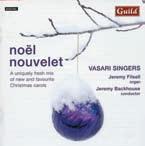
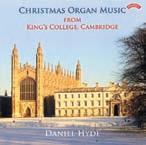 Patrick Mayhew
Patrick Mayhew
CD Reviews ORGAN
ALFRED HOLLINS
Concert Overtures in C major, C minor and F minor; Benediction Nuptiale; A Trumpet Minuet; Allegretto grazioso; Evening Rest; Andante in D; A Song of Sunshine; Maytime Gavotte; Theme with Variations and Fugue.
DELPHIAN DCD34044 TT 79:40
In recent years a new generation of organists has rediscovered the music of Alfred Hollins and more of his pieces (other than A Trumpet Minuet and A Song of Sunshine) are being included in recital programmes. Timothy ByramWigfield’s splendid CD comes as a welcome reminder of Hollins’s versatility as a composer. Hollins was above all a concert organist, in spite of his dedicated service at St George’s Free Church in Edinburgh where he was organist for almost half a century. In spite of blindness, he was also active as an organ designer and one of his most significant designs was for the organ in Dundee’s monumental Caird Hall, where he gave the opening recital in 1923. Sadly, no recordings of his playing, either as pianist or organist, appear to have survived. A tantalising glimpse of his prowess as an improviser is recalled by Graham Watson (formerly organist of St Mary’s Beverley), who once heard Hollins in Newcastle improvising on the Sailor’s Hornpipe with his right hand, Men of Harlech with his left and another tune on the pedals, all at the same time. Timothy Byram-Wigfield puts the magnificent Caird Hall Harrison through its paces in an exciting programme which includes the three substantial Concert Overtures as well as some lollipops.
Also included is a sensitive performance of Andante in D (1895), which Hollins himself considered his finest piece. All the performances are beautifully judged. The considerable technical demands are made light of and Hollins is accorded full justice by player and organ alike. Highly recommended.
Alan Spedding
Cathedral Music 62
Timothy Byram-Wigfield plays the organ of the Caird Hall, Dundee
P3 140 CM Nov 07 B:3302 Cathedral Music MAY #B5827 31/10/07 14:06 Page 62
ALPHA COLLECTION No 4 Moonlight and Roses and other gems for the organ
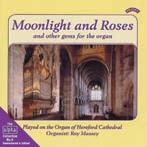
Played on the organ of Hereford Cathedral by Roy Massey.
Guilmant March on a theme of Handel; Canzone; Nicholson Impromptu No 2; Hollins Spring Song; A Trumpet Minuet; Lemare Andantino in D flat; Stanford March Eroica; Lemmens Triumphal March; Fanfare; Wolstenholme Allegretto
PRIORY PRAB 103 TT 45:45
This is the recording that enthused me to take up the organ, so I am glad to have the opportunity to wax lyrical about this re-release and also Massey’s playing which is excellent. The playing is exciting particularly the Lemmens pieces and I never tire of a good performance of Hollins’s Trumpet Minuet. A delightful programme, superbly played and well-worth hearing.
Andrew Palmer
MUSICA JUBILANS
Sounds of Glenstal. Cyprian Love plays the organ of Glenstal Abbey.

Liszt Prelude and Fugue on BACH; Reger Chorale
Fantasia ‘Straf Mich Nicht in Deinem Zorn’; Peeters
Chorale Prelude ‘Creator Alme Siderum’; Clérambault
Basse et Dessus de Trompette; Yon Humoresque; Guilmant Introduction and Variation on and old Polish Carol; Widor: Toccata; Bach Concerto in A minor; Prelude and Fugue in G; Prelude and Fugue in C minor; Chorale Prelude ‘Nun Komm, der Heiden Heiland’.
SDGCD 646 TT 71:10
The organ at Glenstal Abbey was built in 1981 by Kenneth Jones, incorporating a substantial amount of pipework from an 1846 Bevington as well as an 1880 Salicional by White and an 1845 Bourdon by Bishop. Five ranks are by Jones. This is an interesting and varied programme, though the organ lacks the tonal resources and weight to do real justice to the big compositions which is unfortunate, since almost 30 minutes of music, and in particular, Reger’s Chorale Fantasia, are given over to such works. There is no 16’ tone on the manuals or any Swell reeds and the Pedal has only one 16’flue with both reeds borrowed from the Great. Where the instrument shows itself best is in the smaller scale pieces and the Baroque and French classical works where it is entirely at home and convincing. It is brightly voiced and speaks well in the Abbey Church’s helpful and warm acoustic. It is here in the remaining 40 minutes that the interest of this programme lies for me. Despite the instrument’s limitations, as mentioned above, Cyprian Love’s playing is accomplished throughout. He is clearly at home in the church’s acoustic and he achieves clarity of articulation and plays with judiciously chosen tempi.
Jeffrey Williams
MINSTER SPECTACULAR Organ favourites from York Minster. John Scott Whitely
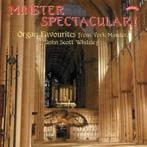
Widor Toccata; Elgar Nimrod; Cocker Tuba Tune; Bach Toccata and Fugue in D minor; Chorale Prelude
‘Liebster Jesu’; Vierne Carillon de Westminster; Fletcher Festival Toccata; Kinder In Springtime; Boëllmann Toccata; Walford Davies Solemn Melody; Purcell Trumpet Tune; Lefébure-Wély Sortie in B flat; Mulet Carillon Sortie.
PRIORY PRCD 5003 TT 66:09
Most of the music needs no introduction; only the Fletcher Toccata and In Springtime being slightly off the beaten track. The rather curious purpose of the disc is to present the Minster organ as it is heard from a position just above the case, which, of course, stands on a screen at the east side of the crossing. The somewhat cursory programme notes explain that the microphone was hung from the top of the tower presenting the listener with ‘an exciting experience ….. which will provide a fitting tribute to this magnificent and famous instrument’. The back cover of the box also explains that the recording was made in 1995 and that this is the first time it has been released on CD. The disc will appeal to those who are intrigued by how the Minster organ sounds from this unusual position (the famous Tuba Mirabilis and large pedal reeds being rendered somewhat impotent,
whilst the upperwork entirely dominates) as well as those who do not have recordings of the items recorded. John Scott Whitely’s playing is up to his usual high standard.
Tim Rogerson
LEFÉBURE-WÉLY ORGAN WORKS 3
Richard Lea plays the organ of Liverpool Metropolitan Cathedral.
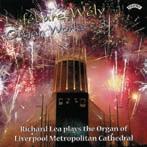
Hymn of the Nuns; Fugue; March. L’Organiste Moderne: Scene Pastorale; Noël Varié; Offertoire; Verset; Sortie in E flat; Fugue; Élévation; Offertoire.
PRIORY PRCD 862 TT 74:40
As I listened to parts of this disc, I couldn’t help but agree with Camille Saint-Saëns, who wrote, ‘Lefébure-Wély, who was a wonderful improviser (I heard him so I can speak about it), has only left us a few insignificant morsels for organ’. L’Organiste Moderne, from which ten pieces on this disc come, was created by Lefébure-Wély to provide some written pieces based on his own improvisations, which the crowds in Paris used to flock to hear during his time as organist at three of the great Paris churches. I imagine that the discipline of committing these works to paper, probably deprived Lefébure-Wély of some of his creativity and, so a programme such as this is not perhaps as exciting as listening to the composer improvise live would have been. Nevertheless, Richard Lea plays this music with conviction and uses the full resources of Liverpool Metropolitan Cathedral’s thrilling organ (which is forty years old this year, incidentally). The recording engineers have wisely avoided placing the microphones too close to the organ, which means that they have picked up rather more of the cathedral’s echo than might in some circumstances be desirable, but which in this case seems to add some authenticity to the recording and certainly helps to reproduce some of the atmosphere of the wonderful buildings in which the composer conceived these works. I cannot imagine anyone not being cheered up by listening to this disc!
Tim Rogerson
JS BACH
Margaret Phillips plays the Bernard Aubertin Organ (2004) in Saint-Louis-en-l’Île, Paris.
Orgelbüchlein BWV 599-644; Prelude & Fugue in A BWV 536; Allabreve in D; Fantasia & Fugue in C minor; Prelude & Fugue in C BWV 531; Canzona in D minor; Fugue in B minor on a theme of Corelli; Prelude & Fugue in E minor BWV 533.
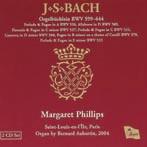
REGENT REGCD254 TT 118:27
Margaret Philips’s interpretations and playing are always accurate and clean and these CDs are no exception. Wonderfully sensitive playing on a beautiful instrument. The recording is characteristically up to the high standards from the Regent team and contains repertoire not frequently heard.
Daniel Reed
ORGAN MUSIC FROM CARLISLE CATHEDRAL
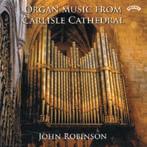
John Robinson plays the cathedral organ
Howells Rhapsody in C Sharp minor; Lloyd Webber Benedictus; Bridge Adagio in E; Ireland Capriccio; Willan Introduction, Passacaglia and Fugue; Whitlock Fidelis; Elgar Organ Sonata in G. PRIORY PRCD 885 TT 70:27
It is probably fair to say that if there is such a thing as a typical English cathedral organ, then the organ of Carlisle Cathedral might just be it. Father Willis installed the instrument in 1856, returning 19 years later to make a few additions, before Harrison and Harrison arrived in 1907 and enlarged it further, no doubt revoicing much pipework in the process. In 1960, J. W. Walker & Sons brightened it up, which included turning the Choir organ into a Positive, before David Wells of Liverpool did some work in 1997, which included reversing some of the 1960 changes and (inevitably) adding a few extra stops.
John Robinson has been Assistant Organist at Carlisle since 2005, having
Cathedral Music 63
P3 140 CM Nov 07 B:3302 Cathedral Music MAY #B5827 31/10/07 14:06 Page 63
previously been Organ Scholar at Canterbury Cathedral and St John’s College, Cambridge, as well as a chorister at Hereford Cathedral. He plays this programme of demanding works in a most exciting and committed way and appears to have complete control of the instrument. Some listeners will find some of the tempi on the recording rather quicker than they might be expecting, though to my mind this serves to make the playing more thrilling, especially in John Ireland’s Capriccio and the final movement of the Elgar Sonata. Two other small matters are worthy of comment, neither of which concerns the performer, but which are both important when considering the disc as an overall package. The first and unavoidable consideration is the amount of action noise (clicks, clunks, squeaks and hisses) made by the organ, which is at its worst in Percy Whitlock’s delightful Fidelis. The second point is the rather pretentious style of the programme notes, which inform us (among other similar statements) that Ireland’s Cappriccio ‘is expressive of a sensuous expectation beyond the confines of restraint imposed upon more diurnal and less hopeful contexts’. These are minor irritations, though, and it is good to hear a relatively young performer matching music and instrument so well. I commend this disc to readers, in the hope that they will buy it, which will encourage John Robinson to make further recordings.
Tim Rogerson
SYMPHONIC ORGAN
Franz Hauk plays the great Klais Organ of Liebfrauenmünster
Ingolstadt
Hakim Overture Libanaise;Pange lingua; Helmschrott Furioso Infernal – Symphonische Fantasie; Dans la Lumière; Messiaen L’Ascension –Quatre Méditations Symphoniques.

GUILD GMCD 7309 TT 73:49
This is a musically-rewarding disc. The Klais organ dates from 1977 and is a superb example of organ design from the time. The music on this CD fits the instrument like a glove, in fact both of the works by Hakim were written for it. Hakim’s work is coupled with that of his predecessor at La Trinité Church in Paris. The performer Franz Hauk, who is organist at Ingolstadt Minster, is a specialist in performing contemporary works and shows a great understanding of the technical demands required. All the works are long –over 10 minutes each, but they all consist of good material, and the disc can be listened to without the content tiring on the ear. Though most will not be familiar with the work of Robert Helmschrott, it is engaging and imaginative, and surely deserves a wider audience. Buy this and hear for yourselves.
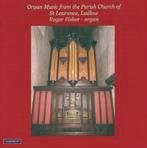 Stephen Power
Stephen Power
SAMUEL SEBASTIAN WESLEY ORGAN WORKS
James McVinnie plays the organ of St Michael and
All Angels, Tenbury
Introduction and Fugue in C sharp minor; Larghetto in F sharp minor; Voluntary (Grave and Andante); Andante Cantabile in G major;Andante in E flat major; Andante in F major; Andante in C major; Andante in E minor; Holsworthy Church Bells; Choral Song.
NAXOS 8.570410 TT 58:29
Lovers of Samuel Sebastian Wesley’s organ works will want this recording by James McVinnie, Organ Scholar at St Paul’s Cathedral, with its freshness and verve. It was recorded on the Father Willis organ at St Michael and All Angels, Tenbury. Commencing with the Introduction & Fugue in C sharp minor, one can sense the admiration the composer had for J. S. Bach and the piece is reminiscent of him. Well-known in his day as a brilliant improviser, one can imagine Wesley launching off in that direction. The longest piece on the recording is the Andante in F major regarded by many as Wesley’s finest organ work. It calls for good keyboard technique with its use of octaves in the right hand and intricate counterpoint which McVinnie achieves immaculately. Some of the pieces on this recording were originally written for Wesley’s pupil, Lady Acland, for the chamber organ at Killerton House which visitors to this National Trust property today are invited to play. The Air with Variations on Holsworthy Church Bells always charms and its relative simplicity again demands precision playing. Sadly, if you visit the Church in North Devon today, you will find no reference either to Wesley’s
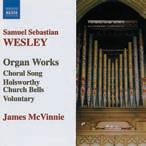
visit, the carillon for which he wrote two melodies or the composition. Fittingly, the final track is the Choral Song, probably Wesley’s best known organ work and one of the most colourful pieces composed for the instrument in its time.
Trevor Godfrey
FRENCH ORGAN MUSIC FROM CHESTER CATHEDRAL
Philip Rushforth plays works
by Vierne and Dupré
Vierne Quatrième Symphonie; Arabesque; Dupré Symphonie-Passion.
AMPHION PHICD218 TT 68:50
Philip Rushforth is Assistant Director of Music at Chester Cathedral and in this CD of French organ music plays works by Vierne and Dupré written within a 10-year period. Vierne’s five-movement Quatriéme Symphonie dates from 1914 and is an intense and quite sombre piece, full of anxious chromaticism, much of it based on material from two main themes. However, it is not all gloom: there is a delightful Minuet third movement and the fourth is a tender Romance Philip Rushforth gives a compelling performance with playing of great clarity and technical assurance. This Symphonie should be more widely known. The Arabesque no 15 and the 24 Pièces en style libre also date form 1914. A dreamy, sinuous melody gently twists and turns over sustained chords and gives the opportunity to use some delicious flute stops on the Chester organ. Dupré’s Symphonie Passion written around 1924, started life as an improvisation using various plainsong melodies and its four movements describe a confused world awaiting its Saviour, the Nativity, Crucifixion and Resurrection. Philip Rushforth gives a brilliant performance of the work and summons up some wonderfully evocative sounds, especially in the third movement with its dark and sinister opening. There is a superbly managed build-up in the last movement from a restrained beginning to a tremendously powerful ending in a blazing D minor. An excellent CD, highly recommended.
Adrian Moore
ORGAN MUSIC FROM THE PARISH CHURCH OF ST LAURENCE, LUDLOW
Organ: Roger Fisher.
Francis Jubilation; Walond Voluntary no 1 in E major; Bach Chorale Partita “Sei gegrüsset, Jesu gütig” BWV 768; Prelude and Fugue in D major BWV 532; Howells Psalm Prelude no 1 set 1 Opus 32 no 1; Reger Benedictus Opus 59 no 9; Whitlock Divertimento; Francis Solemn Prelude on the hymn tune “Hereford”; Rheinberger Sonata no 14 in C major Opus 165 AMPHION PHI CD 219 TT 77:09
The organ in Ludlow Parish Church is around the same size as some of our smaller cathedral instruments and has an interesting history. Fourteen stops date back to 1764 when John Snetzler installed a new organ replacing an instrument which had been in the church for around 100 years. Joseph Walker made a few additions in 1837 and then Gray and Davison added a large number of stops between 1860 and 1891 before William Hill added pneumatic action and a new console. In the first half of the 20th century, the organ seems to have escaped “improvement” (something for which we should all be grateful) and it was not until 1985 that Nicholsons added a few extra stops following an overhaul in 1981. Since then, a few more stops have been added leaving a fourmanual instrument with a comprehensive specification. Roger Fisher writes in his well-judged programme notes that the purpose of this disc is to display the organ’s considerable resources in both classical and romantic music and to celebrate the fine musicianship of Richard Francis, who was Organist and Choirmaster at Ludlow for 30 years until Easter 2007. To this end, the programme includes two pieces by Richard Francis as well as a selection of better known works, which demonstrate the versatility of this musical organ. Francis wrote Jubilation for his wedding in 2004, and it features a short fanfare on the 1860 Gray & Davidson Tuba followed by a dance-like section before composure is regained again for the end of the procession. The Prelude on Hereford was written as a tribute to Rannald Ogston, Honorary Assistant Organist at Ludlow from 1979 until his death in 2003, and to whose memory the CD is dedicated. The tune Hereford is well known and is most often sung to the words O Thou who camest from above, but rather like a Psalm Prelude by Howells, the piece is really a meditation around the tune which although never far away is

Cathedral Music 64
P3 140 CM Nov 07 B:3302 Cathedral Music MAY #B5827 31/10/07 14:06 Page 64
never clearly stated. The remainder of the programme needs little introduction but demonstrates what versatile and musical instruments Victorian organs can be in the hands of an experienced player, when they (i.e. the organs) have not been mutilated by later generations. My only slight reservation about the performance concerns the Bach D major Prelude and Fugue, where a rather booming and late-speaking open wood sound spoils (for me) the opening of the prelude and the end of the fugue. Otherwise, the combination of organ, player and music works well, giving a disc which is worth buying.
Tim Rogerson
OLIVIER MESSIAEN
James Lancelot plays the organ of Durham Cathedral.
Durham Cathedral Choir Association. La Nativité du Seigneur; L’Ascension
DCCA0505 TT 77:21
LA NATIVITÉ
Rupert Jeffcoat plays the organ at Coventry Cathedral
Leighton Helmsley; Veni Emmanuel from Six Fantasies on hymn tunes; Messiaen Puer natus est nobis (Livere du Saint Sacrament); La Nativité du Seigneur; Krzanowski Partita on Idzie, idzie bog prawdiziwy; Harvey Laus deo.
REGENT REGCD230 TT 72:43
These two discs both feature Messiaen’s most popular organ cycle, La Nativité. Both performances are excellent in technical terms, but there are some substantial interpretive differences. Rupert Jeffcoat is generally faster than James Lancelot, though having said that his Les Mages is fully three minutes slower! Both performers seem a little afraid of silence, resulting in a loss of atmosphere at the more ethereal moments. For example, the second line of Dieu Parmi Nous (played on the celestes) feels slightly matter of fact; such is the performers’ haste. Strangely this tendency to slightly over-emphasise forward motion does not affect James Lancelot’s L’Ascension. If forced to choose between the two I would plump for James Lancelot, as his performance is better paced, even if the Durham organ sounds a little less at home in this music than that at Coventry. The Durham disc also features a quite wonderful L’Ascension, whilst Rupert Jeffcoat offers a number of less well-known 20th century pieces – I was particularly interested to hear Jonathan Harvey’s Laus Deo

 Tom Bell
Tom Bell
REGER
Martin Welzel plays the Klais Organ, Trier Cathedral, Germany.
Choral fantasia on ‘Alle Menschen müssen sterben’; Six Trios; Introduction, Variations and Fugue in F sharp minor on an Original Theme

NAXOS 8.557338 TT 72:10
Max Reger wrote so much organ music, yet relatively little of it is performed. His colossal Introduction, Variations and Fugue on an Original Theme was new to me, and it, like all the music on this recording, is treated to a superb performance on a fine organ. This is a very good release indeed, but it is definitely for the Reger connoisseur, or perhaps someone wishing to delve deeper into his enormous output. If you have never heard Reger before, don’t start here!
 Tom Bell
Tom Bell
TOCCARE INCANDESCENT
Joseph Nolan plays the organ of Coventry Cathedral
Montague Toccare Incandescent; Gant Sonata No 2 for Organ; Guillou Toccata; Dupré Symphonie-Passion; Eben Moto Ostinato.
HERALD HAVPCD 329 TT 65:15
Joseph Nolan made his first recording in 2004, playing the Reubke Sonata on the 94th Psalm (amongst other things) on the organ of Ripon Cathedral. The disc under review dates from 2006, and contains works ranging from the lesswell-known to the not-known-at-all. They are wildly difficult – in most cases I
am relying on my ears to tell me this – and the playing demonstrates again Joseph Nolan’s formidable technique. The pieces by Stephen Montague and Andrew Gant are given their world premiere recordings. They are suitably modern in style with discernible structures, although the length of the former, perhaps, is too great for the musical material available. In the 70s, I heard Jean Guillou give a recital at the Royal Festival Hall, and his performance concluded with the Toccata, which, if my memory serves me correctly, contains double pedal glissandi in opposite directions. (Be most careful if you attempt to play these.) The piece is excitingly rhythmic with sudden and wide changes in dynamic. Dupré’s Symphonie-Passion is not, perhaps, one of his most frequently performed works, but may be considered to be representative of the Dupré style. It began in 1921 as an improvisation (on the organ in the Wanamaker store, Philadelphia) based on plainsong melodies whose texts were specifically concerned with events in the life of Christ. It was then reworked as a formal composition, and Dupré gave the first formal performance in Westminster Cathedral in 1924. There are four movements, The World waiting for the Saviour, Nativity, Crucifixion, and Resurrection. It is a substantial work lasting over 30 minutes.
The Moto Ostinato is the third movement of Eben’s organ symphony, Sunday Music. There is an insistent rhythmic figure throughout, against which an angular melodic line is woven. The style of the piece will be familiar to those who know other examples of Eben’s organ pieces. The chosen tempo is, perhaps, a little ponderous. The booklet is a little disappointing. It contains the specification of the Coventry Cathedral organ and some information about the composers and the music, although it is rather sketchy considering the unfamiliarity of much of the music. Authorship of the notes is not given. A good deal of the material, including the effusive biographical notes about the performer, is merely taken from websites. There is a photograph of Nolan seated at the console of the Chapel Royal.
David Knight
CD Reviews
ORGAN REISSUES
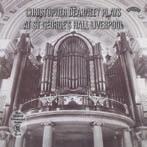
MUSIC FOR AN OCCASION
Christopher Dearnley plays the Grand Organ of St Paul’s Cathedral, London Vaughan Williams Rhosymedre; Purcell Overture Bonduca; Rondeau Abdelaza;Prelude The Fairy Queen; Trumpet Tune; March Music’s Handmaid; Minuet ; Slow Air; Clarke Trumpet Voluntary; Handel March Occasional Oratorio; Whitlock Exultemus; Folk Tune; Bliss Andante tranquillo; Bush Trumpet March.
PRIORY PRCD 6006 TT 45:00
This recording dating from the 1980s has not been released in any format before. It does exactly what it says on the tin, and the programme is similar to the music used at the wedding of the Prince of Wales to Diana in July 1981. The special elements of the organ are used to good effect, and the overall quality of the recording is good. There may be a number of Trumpet Tunes, but Dearnley has plenty of trumpet stops to choose from!
Stephen Power
CHRISTOPHER DEARNLEY Plays at St George’s Hall
Liverpool
Reger Toccata in D minor; Brahms Fugue in A flat minor; Liszt Fantasia on BACH; Fletcher Festival Toccata; S. S. Wesley Andante Cantabile in G; Elgar Nimrod; Handel ‘See the Conquering Hero Comes’ ; Finale (Organ Concerto in G).
PRIORY PRCD 6008 TT 48:74
This is a ‘must have’ recording, taken from an evening FCM former Chairman, Christopher Dearnley, spent simply enjoying himself at the mighty Willis, one of the firm’s most characterful instruments. The crescendo in Brahms’s Fugue in A flat minor is breathtaking, and the Liszt BACH is hugely enjoyable to listen to.
 Stephen Power
Stephen Power
Cathedral Music 65
P3 140 CM Nov 07 B:3302 Cathedral Music MAY #B5827 31/10/07 14:06 Page 65
Cathedral MUSIC Cathedral
Aldeburgh Parish Church ............................................13
Allen Organs ..................................................................2
Allegro Music ................................................................66
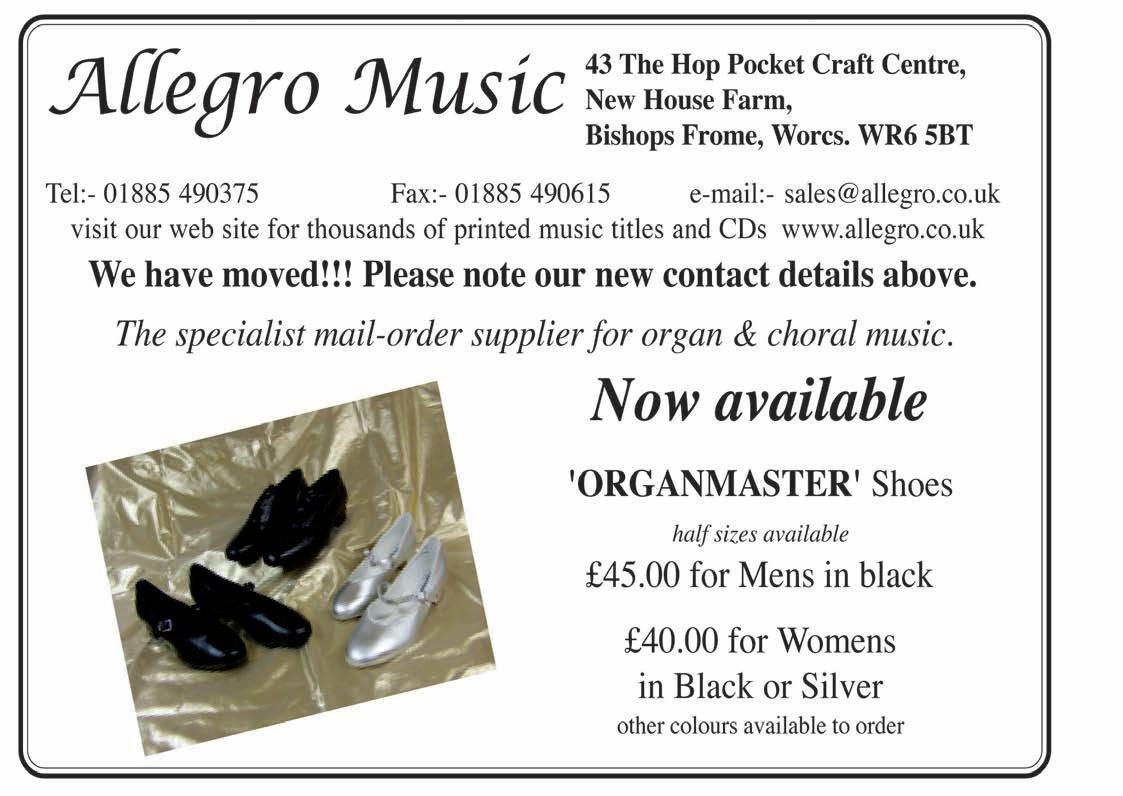
Banks Music ..................................................................51
Christ Church Cathedral School ................................20
Common Praise ............................................................11
Dean Close Preparatory School ..................................16
Durham Cathedral Scholarships..................................46
Ely Cathedral ................................................................46
George Sixsmith Organs ..............................................17
Harrison & Harrison ....................................................29
Herald ............................................................................57
Hestor............................................................................45
Humphrey Clucas..........................................................51
King’s College Chapel Choir ......................................42
Advertisers and Supporters
LCM Examinations ......................................................17
Leeds Parish Church ....................................................38
New English Hymnal ....................................................20
New English Praise ........................................................11
Prayer Book Society ......................................................15
Regent Records ............................................................67
Royal School of Church Music ....................................50
Salisbury Cathedral Voice Trials ..................................46
St George’s School, Windsor ........................................45
St John’s College Choir ................................................46
St Paul’s Cathedral Concerts........................................67
St Paul’s Cathedral School............................................67
Viscount Classical Organs..............................................19
Westminster Abbey Choir ............................................50
Cathedral Music 66
P3 140 CM Nov 07 B:3302 Cathedral Music MAY #B5827 31/10/07 14:06 Page 66
St. Paul’s Cathedral St. Paul’s Cathedral
Advent Procession
Sunday 2nd December and Monday 3rd December - 18.00
One of the year’s most dramatic services as the procession moves from darkness to light. Words and music focus on the Advent themes of life and death, heaven and hell, time and eternity, judgment and healing.
Britten’s Ceremony of Carols
Saturday 8th December - 17.00
The ever-popular work for boys’ voices and harp, performed in candlelight by the choristers of St Paul’s, with seasonal readings.
Handel’s Messiah
Wednesday 12th December - 18.30
St Paul’s Cathedral Choir and Chorus with the City of London Sinfonia.
Conducted by Andrew Carwood
Sankta Lucia Carol Service
Friday 12th December - 18.30
With the Swedish Church in London. Candlelight procession with traditional British, Swedish and International Carols.
La Nativité du Seigneur
Sunday 16th December - 18.00
Messiaen’s organ meditation on the mystery of the birth of Christ. Performed by HuwWilliams and including readings and prayers.
A Celebration of Christmas
Wednesday 19th December - 18.30
Sponsored by Lloyds TSB, featuring the Choir of St Paul’s Cathedral,City of London Sinfonia and celebrity readers

Christingle Carol Service
Saturday 22nd December - 13.00
Enjoy Christmas favourites in a service lasting 45 minutes.
Children especially welcome.
Christmas Carol Services
Sunday 23rd and Monday 24th - 16.00
Two atmospheric Christmas Eve services sung by the Cathedral choir For more information about any of these events please call 020 7236 4128 or visit www.stpauls.co.uk
New from Regent
Restored to G lory Birmingham Town Hall
Thomas Trotter
Released to celebrate the re-opening of Birmingham Town Hall and the restoration of its historic William Hill organ, international virtuoso and Birmingham City Organist Thomas Trotter presents a new recording of dazzling organ showpieces featuring original works and orchestral transcriptions from the English ‘town hall’ tradition.

Handel transcribed Dupré Organ Concerto No 16 in F, Thalben-Ball Variations on a theme of Paganini for pedals, Thalben-Ball Elegy, WT Best Concert Fantasia on Men of Harlech, Ireland Villanella, Bizet transcribed Lemare Carmen Suite, Lemare Andantino in D flat, Lemare Rondo Capriccio, Lemare Concertstück; Wagner transcribed Lemare Rienzi Overture REGCD265
Some reviews of Thomas Trotter’s previous release on Regent:
“thenew recording sets the gold standard ...panache to burn.”
Chorister Open Day
Monday 21st January 2008
Boys aged between 6 and 9 who have an interest in music and singing are invited to spend a day in the life of the Cathedral Choir and Cathedral School
• 100% fee bursaries available to choristers

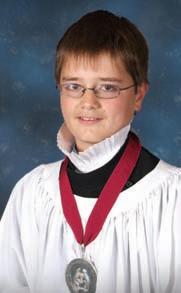
• Free tuition on two instruments
• Preparation for scholarship and Common Entrance exams
Next voice trials: Saturday 26th January 2008
For a prospectus and more details about the open day please contact: Clare Morgan, St Paul’s Cathedral School 2 New Change, London EC4M 9AD Tel: 020 7248 5156; Fax: 020 7329 6568 Email: admissions@spcs.london.sch.uk
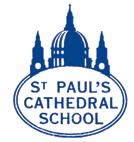
BBC Music Magazine July 2007 *****
“throughout this superbly engineered recording his mastery of tonal gradation, innate stylistic sense and imaginative colouring make for a recording as rewarding as it is timely”
Gramophone August 2007
Peter King Bath Abbey Organ
The BBC National Orchestra of Wales
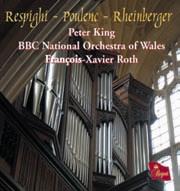
Conducted by François-Xavier Roth
Music for Organ and Orchestra
This recording, released to celebrate the 10th anniversary of the new Klais organ in Bath Abbey, features three very contrasting works for solo organ and orchestra:Respighi’s opulent and luxurious homage to the eighteenth century and the Baroque suite, Poulenc’s dramatic, expressive and wild patchwork quilt and Rheinberger’s gloriously melodic and virtuoso nineteenth-centurygrand concerto with its echoes of Schumann.
Suite in G for Strings and Organ – Respighi
Concerto in G minor for Organ, strings and timpani – Poulenc
Concerto No 1 in F, Op 137 for Organ, strings and three horns – Rheinberger
REGCD257
WELLS CATHEDRAL CHOIR MATTHEWOWENS
David Bednall Organ
A beautiful and varied selection of Christmas music, including two first recordings*, sung by the superlative Wells Cathedral Choir.
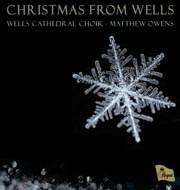
REGCD260
The Lord of all Walker*, Mary’s Lullaby Rutter, Wild Wood Carol Rutter, Christmas Lullaby Rutter Shepherd’s Pipe Carol Rutter, The Lamb Tavener, No small wonder Edwards, O magnum mysterium Lauridsen God is with us Tavener, Ding Dong! Merrily on High arr. Willcocks, Bogoroditse devo Rachmaninov O leave your sheep Leighton, The Twelve Days of Christmas arr. Rutter Antiphon to Mary Athanasiadis*, Det ër en ros utsprungen Sandström, Have yourself a very merry Christmas Martin/Blane, arr. Gritton,Toccata-Prelude: ‘Vom Himmel hoch’ Edmundson
Some reviews of Wells Cathedral’s previous release on Regent: “The Wells Cathedral Choir are in world class form here.” Gramophone May 2007
“the overall choral sound is wonderfully blended and must rank as one of the top cathedral sounds outside London” BBC Music Magazine March 2007
Cathedral Music 67
from all good
and from Regent direct REGENTRECORDS, PO Box 528,
WV3 9YW Tel: 01902 424377, Fax: 01902 717661 E-mail:
-
byRSK
Available
CD retailers
Wolverhampton,
info@regentrecords.com Web: www.regentrecords.com
now with secure online ordering Cathedral shops order from Regent Direct Retail distribution
Entertainment Ltd Tel: 01488 608900, info@rskentertainment.co.uk
C H R I S T M A S F R O M W E L L S
P3 140 CM Nov 07 B:3302 Cathedral Music MAY #B5827 31/10/07 14:07 Page 67
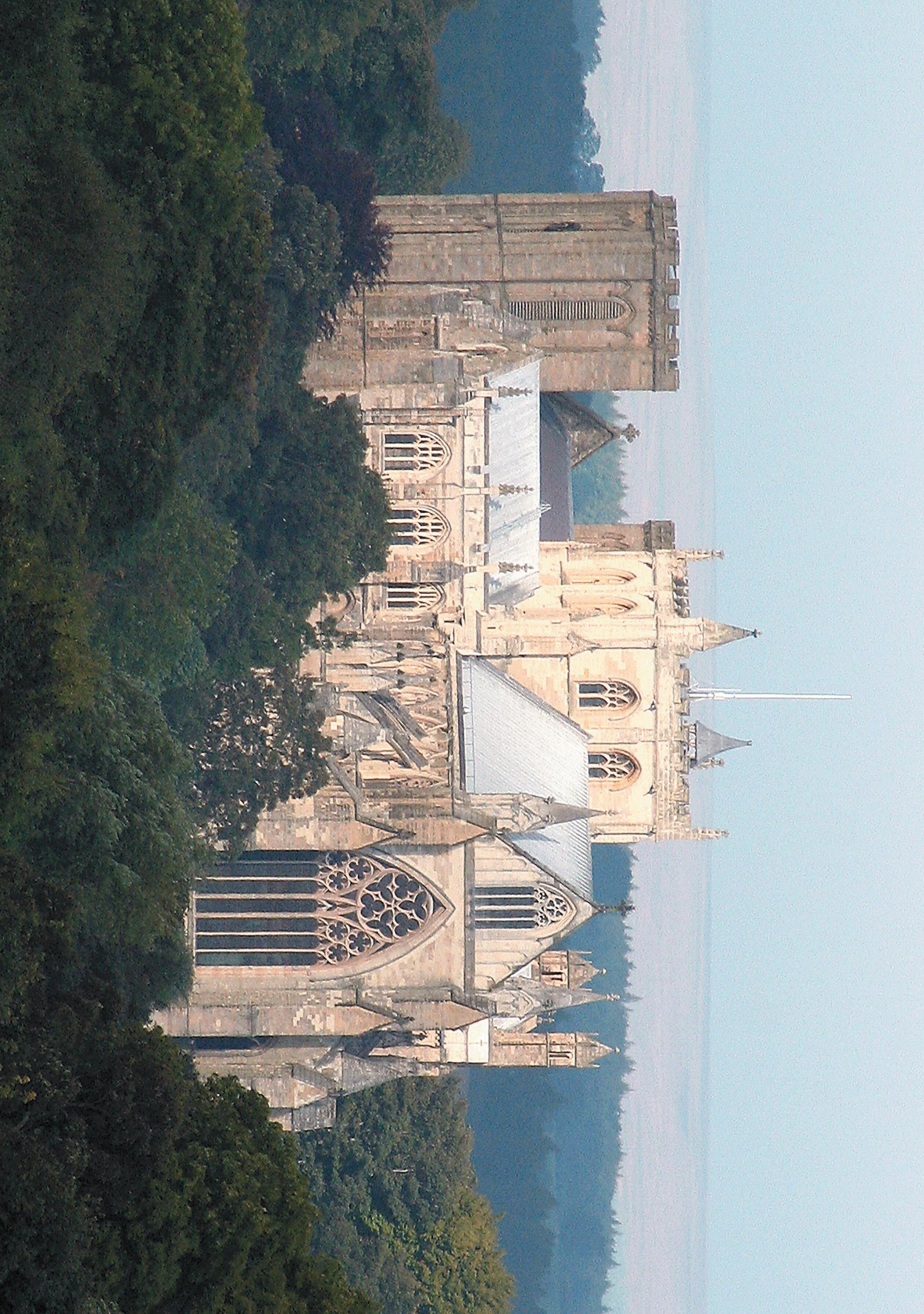
P3 140 CM Nov 07 B:3302 Cathedral Music MAY #B5827 31/10/07 14:07 Page 68





















































 DAVID
DAVID





































 By Humphrey Clucas
By Humphrey Clucas


 Tom Bell
Tom Bell




 Matt Lennox
Matt Lennox




 Matt Lennox
Matt Lennox





























 By Giovanni Gabrieli
By Giovanni Gabrieli

 Ian Morgan
Ian Morgan





 Patrick Mayhew
Patrick Mayhew







 Stephen Power
Stephen Power



 Tom Bell
Tom Bell

 Tom Bell
Tom Bell

 Stephen Power
Stephen Power







